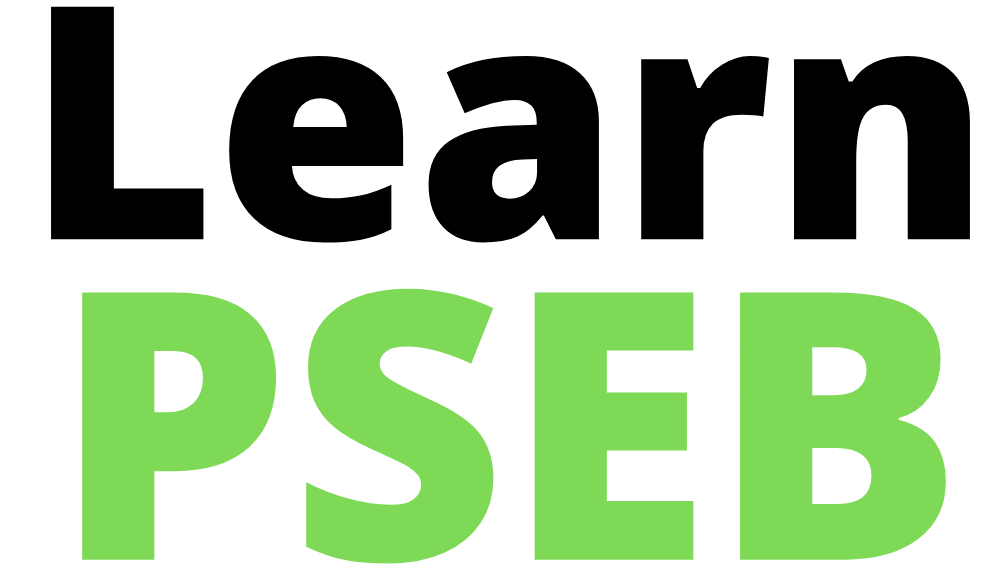Class 10 Biology
PSEB Class 10 Biology Chapter 7 Control And Coordination Question and Answers
Control And Coordination Questions
Question 1. What is the difference between reflex action and walking?
Answer:
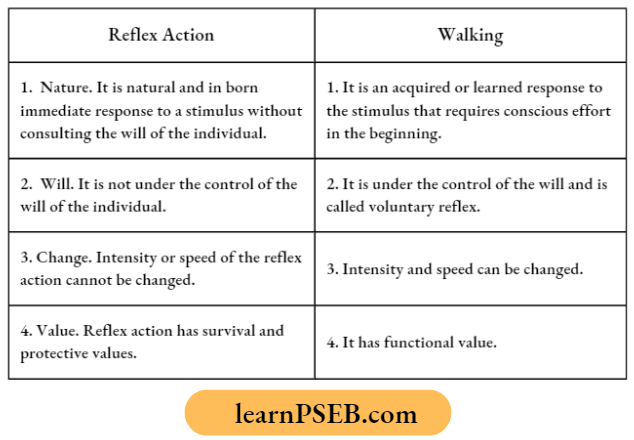
Question 2. What happens at the synapse between two neurons?
Answer:
The synapse between two neurons is a junctional complex that permits an axon end of a neuron to pass its electrical or chemical signal to the dendrite end of another neuron.
- There is a fluid-filled narrow space between the two neurons. It is called synaptic cleft. The presynaptic axon end of the neuron is bulb-like.
- It contains many synaptic vesicles having neurotransmitter chemicals. The postsynaptic dendrite end of the next neuron has a trough-like depression. Its membrane has receptors for the neurotransmitter.
- As the impulse reaches the presynaptic bulb, the synaptic vesicles move to the cleft side and burst open.
- The released neurotransmitter sensitizes the receptors that in turn create the electrical impulse.
- Synapse allows a unidirectional flow of information from the axon end of one neuron to the dendrite end of the next neuron.
Read And Learn More PSEB Class 10 Biology
PSEB Class 10 Biology Chapter 7 Control And Coordination
Question 3. Which part of the brain maintains posture and equilibrium of the body?
Answer: Cerebellum.
Question 4. How do we detect the smell of an agarbatti (incense stick)?
Answer: Burning of agarbatti releases numerous molecules of incense. They enter the nose and come in contact with particular sensory hair of olfactory cells.
An impulse is generated. It passes into the olfactory bulb which relays it to the temporal lobes of the cerebrum for interpretation.
Question 5. What is the role of the brain in reflex action?
Answer: Like the spinal cord, the brain can also play a direct role in certain reflex actions called cerebral reflexes, for example., closing of eyes or flashing of light.
In such cases, brain acts as a relay station in which the impulse of sensory neurons is transferred to motor neurons through an interneuron.
Question 6. What is reflex action? Explain the mechanism of reflex action with a suitable example.
Answer:
Reflex action is a nerve-mediated automatic and spontaneous response to a certain stimulus without consulting the will of the individual.
- The stimulus for reflex action is picked up by its receptor. The receptor is connected to a sensory neuron. An impulse generated in it is passed to the central nervous system.
- The central nervous system acts as a relay or modulator. With the help of an interneuron, it transfers the impulse to a motor neuron. The motor neuron takes the impulse to the effector organ for response.
Question 7. Name the three major regions of the brain. Which part of the brain maintains posture and equilibrium of the body?
Answer:
Three regions of the brain. Fore brain, midbrain, and hindbrain. Maintenance of posture and equilibrium. Cerebellum.
Question 8.
- Distinguish between voluntary and involuntary actions of our body.
- Choose involuntary actions among the following: reading, beating of heart, salivation in mouth on viewing tasty food, talking.
Answer:
- Voluntary action is under the control of the will and is performed with the help of striated muscles. Involuntary action is performed without instructions from will with the help of smooth muscles.
- The beating of the heart and salivation in the mouth on viewing a tasty food are involuntary actions.
Question 9.
- Name two main regions of our central nervous system,
- Which one of them plays a major role in sending commands to muscles to act without Involving the thinking process,
- Name the phenomenon involved.
Answer:
PSEB Class 10 Biology Chapter 7 Question And Answers
- Brain and spinal cord.
- The spinal cord has a major role in sending instructions to muscles without involving the thinking process.
- Reflex action.
Question 10. Write the function of the following :
- Sensory neuron
- Cranium
- Vertebral column
- Motor neuron.
Answer:
- Sensory Neuron. Conveying impulse or sensation from receptor to central nervous system.
- Cranium. Covering and protection of the brain.
- Vertebral Column. Covering and protection of the spinal cord.
- Motor Neuron. Conveying impulse for action from the central nervous system to the effector organ.
Question 11. Identify the part of a neuron
- Where information is acquired
- Through which information travels
- Where the impulse must be converted into a chemical signal?
Answer:
- Dendrite
- Axon
- Synapse.
Question 12.
- What is a reflex arc?
- Why have reflex arcs evolved in animals?
Answer:
- A reflex arc is nerve nerve-based pathway performed by an impulse from the receptor of stimulus to the effector organ through the central nervous system without consulting the will of the individual.
- Reflex arcs evolved in animals even before the evolution of intelligence as a survival mechanism because they can provide immediate responses to harmful stimuli.
Question 13. Stale the sequence of events through a reflex arc which occurs when a bright light is focussed on your eyes.
Answer:
- Bright light is sensed by receptors present over the eyes. The sensation is picked up by sensory neurons and taken to the superior quadrigeminal.
- Intemeurons present in the superior corpora quadrigemina transfer the impulse to motor neurons. The motor neurons close the eyelids as well as narrow the pupil.
Question 14.
- Name one gustatory receptor and one olfactory receptor present in human beings.
- Write a and b in the given flow chart of neurons through which information travels as an impulse.
Dendrite a → b → End point of a neuron.
Answer:
- Gustatory Receptor. Taste buds over the tongue.
- Olfactory Receptor. Olfactory epithelium in nasal chambers.
- Dendrite → Cell body → Axon → End point of a neuron.
Question 15. What is a nerve impulse? State the direction followed by a nerve impulse while traveling in the body of an organism.
Answer:
A nerve impulse is a progressive electrical wave or signal that develops in response to a stimulus and travels along a nerve fiber to reach another nerve, muscle, or gland.
Direction Of Nerve Impulse
Dendrite → cell body → Axon → Axon end → Dendrite/gland/muscle.
Control And Coordination PSEB Class 10 Notes
Question 16. List in tabular form two differences between reflex action and walking.
Answer:
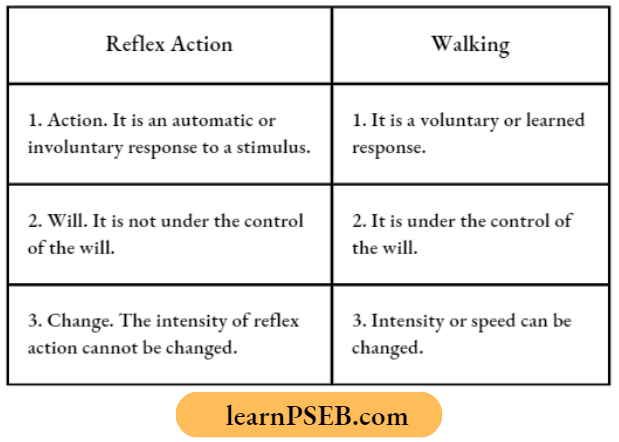
Question 17. Which part of the nervous system controls reflex arcs? Trace the sequence of events that occur when we touch a hot object. Mention the part of the neuron that requires information and the form in which information travels.
Answer:
Reflex arcs are controlled by the central nervous system (many in the spinal cord) without analyzing them. CNS functions as a coordinator or relay station for transferring sensory information to motor information.
Events. A hot object is the stimulus. As it is touched, the stimulus is picked up by skin-based receptors. From receptors, the information is taken up as an impulse by sensory neurons.
- Sensory neurons take the impulse to the spinal cord. In the spinal cord, the impulse is transferred to motor neurons through interneurons.
- The motor neurons take the impulse to the muscles of the hand which pull away the arm. Information travels in neurons in the form of electrochemical impulses.
Question 18. What is the structural and functional unit of the nervous system? Name any two components. Which structure in a neuron helps to conduct a nerve impulse
- Towards the cell body
- Away from the cell body.
Answer:
Structural and Functional Unit. Neuron.
Components of a Neuron. Dendrites, cell body, and axon.
- Dendrite
- Axon
Question 19.
- Which part of the brain controls Involuntary actions?
- Write the function of any two regions of It.
Answer:
Hind brain is a part of the brain that controls involuntary functions. It has three parts—pons, cerebellum, and medulla oblongata.
- Medulla Oblongata. It regulates blood pressure, heart rate, and breathing. Several reflex actions have centers in the medulla oblongata, viz., swallowing, vomiting, sneezing, coughing, salivation, and peristalsis.
- Cerebellum. It involuntarily co-ordinates muscular activities of the body. The cerebellum maintains equilibrium during different activities or postures of the body.
Question 20.
- If the cerebellum is not functioning properly, state the activities of our body that are affected.
- How do muscle cells move?
Answer:
PSEB Class 10 Biology Important Questions
- Impairment of the cerebellum shall result in non-coordination of body activities and defects in maintaining balance or posture of the body.
- Muscle cells move in response to excitation provided by a neuromuscular junction. The motor impulse passes to the bulb end of the motor end plate of an axon.
- The bulb is in near contact with the sole plate of the muscle cell. As the nerve impulse reaches the bulb, it activates the synaptic vesicles.
- The vesicles move to the membrane and burst open to release molecules of neurotransmitters.
- They activate receptors over the end plate and cause activation of muscle interior releasing calcium and causing contraction of muscle cells.
Question 21. Name the part of the brain that controls
- Voluntary actions
- Involuntary actions.
How is the brain protected from injury and shock?
Answer:
- Voluntary Actions. Cerebrum.
- Involuntary Actions. Hindbrain.
Protection of the Brain.
- Covering of brain by cranium,
- Holding of the brain by meninges,
- Presence of shock-resistant fluid medium both inside and outside the brain.
Question 22.
- Name the system which facilitates communication between the central nervous system and other parts of the body.
- Mention two types of nerves it consists of along with their organs of origin.
Answer:
- Peripheral Nervous System (PNS) facilitates communication between the central nervous system (CNS) and other parts of the body.
- The peripheral nervous system consists of two types of nerves
- Cranial from the brain, 12 pairs
- Spinal from spinal cord, 31 pairs.
Question 23. Trace the sequence of events that occur when a bright light is focused on your eyes.
Answer:
It is an example of a cerebral reflex.
Receptor cells of eyes → Sensory neurons → CNS (Brain) → Motor neurons → Eye muscles → Pupil contracts and eyelids close.
Question 24. List in tabular form three distinguishing features between the cerebrum and cerebellum.
Answer:
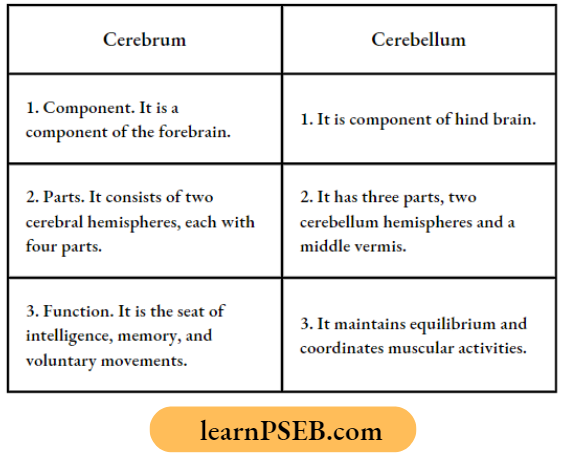
Question 25.
- Name a part of the human brain that controls
- Voluntary actions and
- Involuntary actions.
- Write the function of the peripheral nervous system. Name the components of this system stating their origin.
Answer:
PSEB Class 10 Science Chapter 7 Solutions
- Voluntary actions. Forebrain/cerebrum.
- Involuntary Actions. Hind brain/medulla oblongata.
- Peripheral Nervous System (PNS) connects different parts of the body with the central nervous system. It consists of nerves. Depending upon their origin, nerves arc of two types, cranial (from the brain) and spinal (from the spinal cord).
Question 26. Name parts in the diagram. What is the term given to the sequence of events occurring in the diagram?
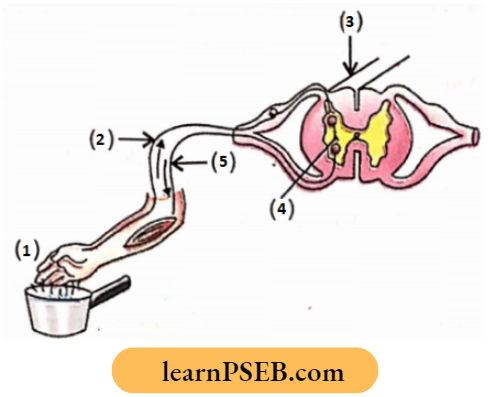
Answer:
- —Receptor (skin)
- —Sensory neuron
- —Spinal cord
- —Relay neuron
- —Motor neuron.
Term. Reflex arc.
Question 27. A cheetah on seeing a prey, moves towards it at a very high speed. What causes the movement of his muscles? How does the chemistry of cellular components of muscles change during the event?
Answer:
- The sight of prey generates a nerve impulse that reaches the muscles. A neurotransmitter is released. It causes the activation of muscles through the release of calcium.
- Calcium brings about a shortening of muscles through the sliding of myosin fibrils over actin fibrils. Shortening and relaxing of muscles allow the cheetah to move at high speed.
PSEB Class 10 Biology Chapter 9 Heredity Question And Answers
Heredity Short Question And Answers
In each question, two statements are given- one labelled Assertion and the other labelled Reason. Select the correct answer to these questions from the codes (A), (B), (C) and (D) as given below :
- Both assertion and reason are true and reason is a correct explanation of the assertion.
- Both assertion and reason are true but reason is not the correct explanation of the assertion.
- Assertion is true but reason is false.
- The assertion is false but the reason is true.
Question 1. Assertion (A). The sex of a child in human beings will be determined by the type of chromosome he or she inherits from the father.
Reason (R). A child who inherits an ‘X’ chromosome from his father would be a girl (XX) while a child who inherits a ‘Y’ chromosome from the father would be a boy (XY).
Answer: (1)
The sex of the children is determined by what they inherit from their father and not the mother. Justify.
Answer:
Women are homogametic. They produce one type of ova 22 + X. Men are heterogametic. They have two types of sperms, androsperms (22 + Y) and gynosperms (22 + X). During fertilization, it is the sperm type which determines the sex of the child—male (22 + X and 22 + Y or 44 + XY) or female (22 + X and 22 + X or 44 +XX).
Read And Learn More PSEB Class 10 Biology
Question 2. State the importance of chromosomal differences between sperms and eggs of humans.
Answer:
The chromosomal difference between sperm and eggs of humans is basic to the determination of the sex of the child. Eggs are of one type carrying the genetic complement of 22 + X. Sperms are of two types, androsperms with 22 + Y chromosomes and gynosperms with 22 + X chromosomes. The two types of sperm determine the sex of the child. Justify.
Question 3. Name the organism Mendel used for his experiments. Explain F1 and F2 progeny obtained by Mendel when he bred tall and short varieties of the organisms he experimented with.
Answer:
The experimental organism used by Mendel was the Garden Pea (Pisum sativum). Mendel crossed a pure tall
Pea plant with a pure dwarf Pea plant. All the plants of the Fj generation were tall. On self-breeding plants of the F1 generation, Mendel obtained an F2 progeny of both tall and dwarf in the ratio of 3: 1. The presence of dwarf plants in the F2 generation shows that the factor of dwarfness was present in F1 plants but it did not express its effect due to its recessive nature. The factor for tallness is dominant.
PSEB Class 10 Biology Chapter 9 Heredity
Question 4. The genotype of a plant bearing purple flowers is PP and one with white flowers is pp. When these are crossed
What colour of flowers would you find in F1 progeny?
Give the percentage of white flowers if F1 plants are self-pollinated.
In what ratio would you find PP and Pp in F2 progeny? Draw a flowchart in support of your answer.
Answer:
Purple (b) 25 % (c) 1: 2
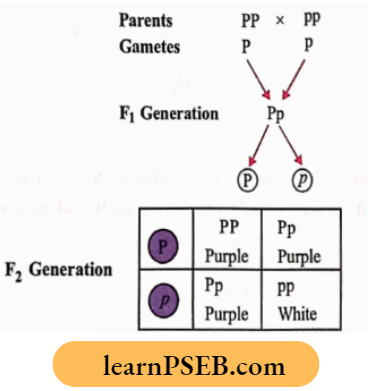
1 Pure: 2 hybrid purple: 1 pure white
Question 5. Why are some Pea plants tall and others short in nature? Explain with reference the role of genes in controlling characteristics.
Answer:
Genes are segments of DNA. They function in controlling body structure and its working through the synthesis of mRNAs. wRNAs take part in the formation of proteins. The proteins help in the synthesis of enzymes and other biochemicals.
The character of height is controlled by growth hormones. If the gene-controlling height is dominant, it helps in the synthesis of more hormones so that the plant becomes tall. If the gene is recessive, a less efficient protein and a smaller quantity of growth hormones would be produced. As a result, the plant remains dwarf.
Question 6. Explain how Mendel’s experiments show that traits are inherited independently.
Answer:
Mendel performed a dihybrid cross between round yellow-seeded and wrinkled green-seeded Pea plants. In F1 generation he obtained only round yellow seeded plants. Both traits are dominant and are expressed in hybrids.
He raised the F2 generation after the self-breeding of F1 plants. There were four types of F2 plants—round yellow (9/16), round green (3/16), wrinkled yellow (3/16) and wrinkled green (1/16). The combinations of round green and wrinkled yellow-seeded plants were new. They could arise only if the traits of the two characters could assort independently.
Question 7. One plant with dominant tall height bearing purple flowers is crossed with another plant having recessive dwarf and white flowers.
- What does the plant’s F1 generation look like?
- What type of cross is it?
- What is the phenotypic ratio in F2 generation and name the type of plants obtained according to phenotypic ratio?
Answer:
- Plants of generation are all tall and purple-flowered.
- Dihybrid cross as it involves two different characters.
- 9: 3 : 3: 1. Tall and purple flowered (9/16) tall and white flowered (3/16) dwarf and purple flowered (3/16) and dwarf and white flowered (1/16).
Question 8.
1. Name the sex chromosomes present in human males and human females.
2. With the help of a flowchart determine genetically in human beings the sex of the spring if the sperm carrying X chromosome fertilizes the egg.
Answer:
A. Sex chromosomes.
1. Human Male-XY
2. Human female-XX.
B. 22 + X (egg) and 22 + X (sperm) will produce a female baby (44 + XX).
PSEB Class 10 Biology Chapter 9 Question And Answers
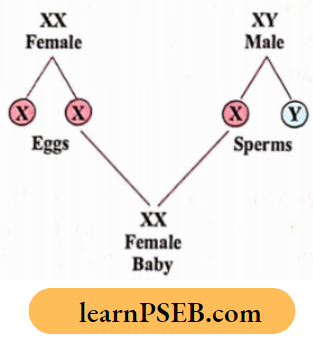
Question 9. Guinea pigs having black colour when crossed with guinea pigs having the same colour produced 100 offspring out of which 75 were black and 25 were white. Now find out :
- What is the possible genotype of guinea pigs?
- Which trait is dominant and which is recessive?
- What is this cross called and what is the ratio of F2 progeny obtained from this cross?
Answer:
- Genotype of Guinea Pigs. Bb, Bb.
- Black colour is dominant (B) while white colour (b) is recessive.
- Monohybrid cross. F2 progeny. 1 pure black (BB): 2 hybrid black (Bb): one white (bb).
Question 10.
- Name an animal which can change sex. What does it indicate?
- Name the trait which can express itself in the next generation.
Answer:
- Ophryotrocha(an annelid). It is male in the young state and female later. Sex is here determined non-genetically.
- Dominant trait.
Heredity PSEB Class 10 Notes
Question 11.
- Mendel selected the Pea plant for his experiments. List two reasons.
- State the meaning of recessive and dominant genes.
Answer:
- Mendel selected the Pea plant for his experiments because It can be cross-pollinated manually and self-pollinated automatically. It is annual with a short life span and a high yield of seeds.
- Recessive Gene: It is a gene or factor that cannot express its effect in the presence of its contrasting factor.
- Dominant Gene: It is a gene or factor which expresses its effect both in homozygous and heterozygous states.
Question 12. In a cross between plants with purple flowers and plants with white flowers, the offspring of the F1 generation had all purple flowers. When F1 generation individuals were self-bred, the F2 generation gave rise to 100 individuals, 75 of which had purple flowers. Make a cross and answer the following.
- What is the genotype of F2 individuals?
- What is the ratio of purple to white-flowered plants in F2 generation?
Answer:
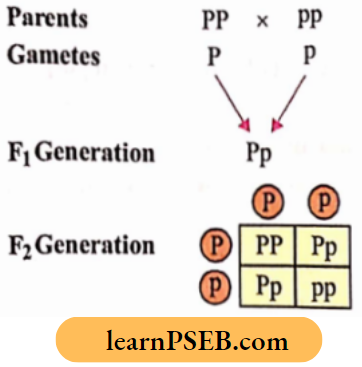
1PP (pure purple): 2 Pp (hybrid purple): pp (pure white)
- Genotypes of F2 Progeny. 1 PP: 2 Pp: 1 pp.
- Purple to white flowered ratio. 75: 25 or 3: 1.
Question 13. A husband has 46 chromosomes. His wife has 46 chromosomes. Then why does not their offspring have 46 pairs of chromosomes which is obtained by fusion of male and female gametes? Support your answer with an illustration.
Answer:
Gametogenesis is not a mitotic division. It is a meiotic division. Therefore, gametes do not possess the same chromosome number as the parents. Instead, they have half the number of chromosomes. As the mother has 46 chromosomes, the ovum will have 23 chromosomes.
Similarly, as the father has 46 chromosomes his sperm will have 23 chromosomes. The fusion of a sperm (23 chromosomes) and an ovum (23 chromosomes) restores the 46 chromosome number in the offspring. There is no chance of having 46 pairs of chromosomes.
PSEB Class 10 Biology Important Questions On Heredity
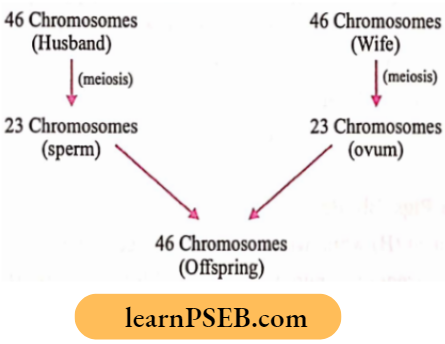
Question 14. “It is a matter of chance whether a couple will give birth to a boy or a girl”. Justify the statement and support your answer with a neat illustration.
Answer:
The wife produces only one type of ova, that is, 22 + X. The Husband has two kinds of sperm, 22 + X (gymnosperms) and 22 + Y (angiosperms) formed in equal numbers. It is a pure chance which type of sperm comes in contact with the ovum. If it is endosperm, a male child is born. If it is a gymnosperm, a female child is born.
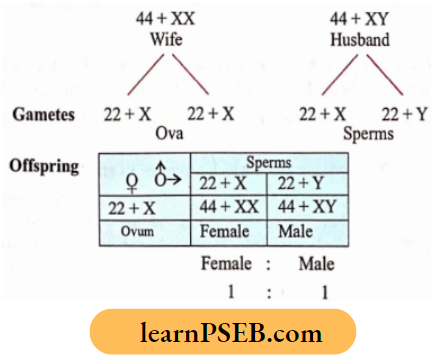
Question 15. A round-seeded plant (RR) Is crossed with a wrinkled-seeded plant (RR). Find out the phenotype and genotype of the F1 and F2 generations.
Answer:
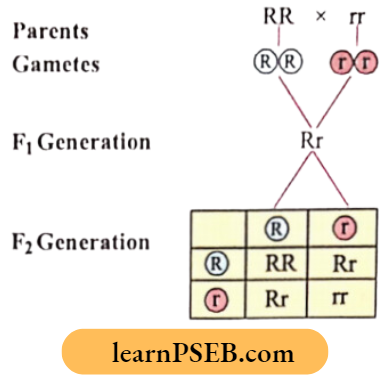
Phenotype of F1 generation = Round Seeded ; Genotype of F, generation = Rr
The phenotype of F2 generation = 3 round: 1 wrinkled
Genotype of F2 generation = 1 pure round (RR): 2 hybrid round (Rr): 1 wrinkled (rr).
Question 16. Mendel studied the inheritance pattern of traits in a Pea plant. According to this study, he obtained a 9 : 3 : 3: 1 ratio of certain traits in the progeny of the F2 generation. Based on it answer these questions.
- What traits did he study? How do they represent themselves?
- What was the trait of F1 progeny?
- Which rule does this inheritance pattern suggest?
Answer:
- Mendel crossed round yellow seeded (RRYY) plant with wrinkled green seeded (rryy) plant.
- F1 plants were all round and yellow-seeded.
- In the F2 generation, four types of plants were formed—round yellow seeded (9/16), round green seeded (3/16), wrinkled yellow seeded (3/16) and wrinkled green seeded (1/16).
The occurrence of round green and wrinkled yellow-seeded plants was a new combination of traits other than the parental types.
This is possible if the traits of the two characters separate or assort independently of each other. The phenomenon is called the law of independent assortment.
PSEB Class 10 Science Chapter 9 Solutions
Question 17. A cross was obtained between a purebred tall Pea plant and a purebred dwarf pea plant and F1 progeny. Later the F1 progeny was selfed to obtain F2 progeny. Answer the following questions :
- What is the phenotype of F1 progeny and why?
- Give the phenotypic ratio for F2 progeny.
- Why is the F2 progeny different from the F1 progeny?
Answer:
- F1 progeny is all tall as the trait of tallness is dominant over the trait of dwarfism.
- 3 tall: 1 dwarf.
- Segregation of the trait of tallness and trait of dwarfism during gamete formation by F1 progeny followed by random fusion of the two types of gametes during the formation of F2 progeny, i.e., T x T (TT), T x t (Tt), t x t (tt).
Question 18. How can you say that in Mendel’s monohybrid cross, the F2 dominants are not the same?
Answer:
Phenotypically F2 dominants appear similar but genotypically they are of two types, pure and hybrid. This can be proved by self-breeding the dominants. One-third of the dominants produce a progeny of only dominants. They are pure for the dominant trait. Two-thirds of the dominants behave as hybrids. They give a progeny of both dominant and recessive traits in the ratio of 3: 1.
Question 19. A cross was made between pure breeding Pea plants one with round and green seeds and the other with wrinkled and yellow seeds.
- Write the genotype of Ft progeny. Give reasons for your answer.
- Write the different types of F2 progeny obtained along with ratios when F1 progeny was selfed.
Answer:
- Across between RRyy and rrYY plants yields an Fj generation ofRrYy(round and yellow seeded plants) even though none of the parents have this set of traits. It is due to the non-expression of recessive alleles for green colour and wrinkled seed in the presence of dominant alleles for yellow colour and round seed.
- F2 Progeny. Round yellow (9/16), round green (3/16), wrinkled yellow (3/16) and wrinkled green (1/16).
Question 20. In an experiment, Mendel obtained 1014 plants, out of which 787 had round seeds and 227 had wrinkled seeds in F2 generation.
- What is the approximate ratio obtained in F2 generation?
- Under which law do you find this ratio?
- Why is this law so-called?
Answer:
- 787: 227 roughly 3:1.
- Law of segregation.
- As per the law of segregation, the two alleles of a character separate during gametogenesis and pass to different gametes.
- A gamete comes to have only a single allele of a character.
PSEB Class 10 Biology Solutions For Chapter 1 Life Processes
PSEB Class 10 Biology Solutions For Chapter 1 Life Processes
Life Processes
These are the processes which together perform the functions of growth, repair, and maintenance of living organisms. These include nutrition, digestion, respiration, transportation, and excretion.
Simple Trick To Remember Life Processes
With the help of the mnemonic “MRS GREN” one can easily tell the life processes which indicate whether an organism is alive or not.
- M: Movement
- R: Respiration
- S: Sensitivity (or Feel)
- G: Growth
- R: Reproduction
- E: Excretion
- N: Nutrition
- Nutrition
Read And Learn More PSEB Class 10 Biology
Nutration
It is the process by which living organisms take in food, utilizes it to get energy for growth, repair and maintenance, and then excretes the waste material from the body.
Life processes class 10 notes
Simple Trick To Remember Modes Of Nutrition, Its Types And Subtypes
Organisms are divided into two categories, viz. Autotrophs and Heterotrophs on the basis of their mode of nutrition.
PSEB Class 10 Biology Chapter 1 Life Processes
Autotrophs
Plants are Autotrophs. Autotrophs prepare their own food by the process of photosynthesis.
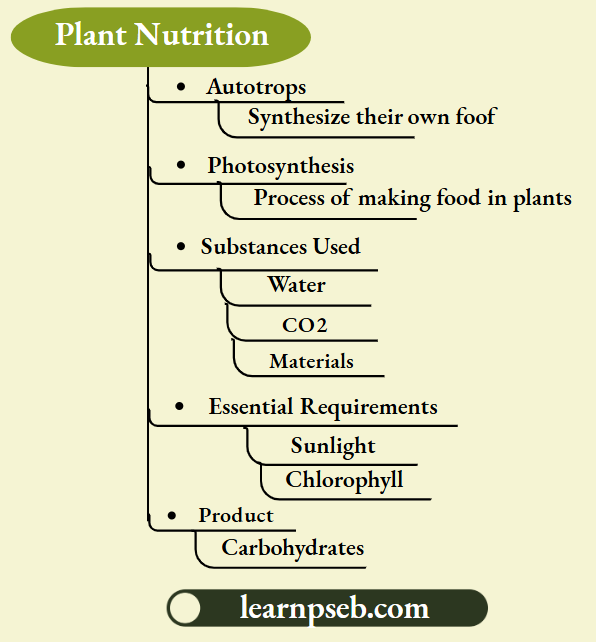
Chemical Equation Of Photosynthesis

Steps involved in photosynthesis
- Absorption of light energy of sun by chlorophyll.
- Conversion of light energy to chemical energy and splitting of water molecules into hydrogen and oxygen.
- Reduction of carbon dioxide to carbohydrates.
Heterotrophs
Animals are Heterotrophs. Heterotrophs depend on others for food. They obtain nutrition through process of digestion.
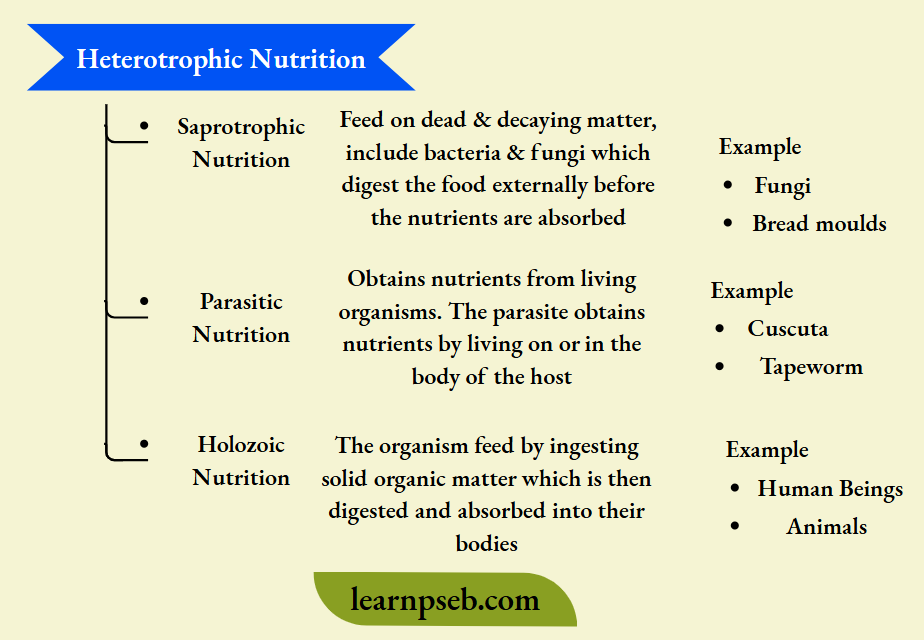
- Digestion is the process of breakdown of complex food molecules into simpler ones.
Tests To Confirm Importance Of Various Raw Materials In Photosynthesis
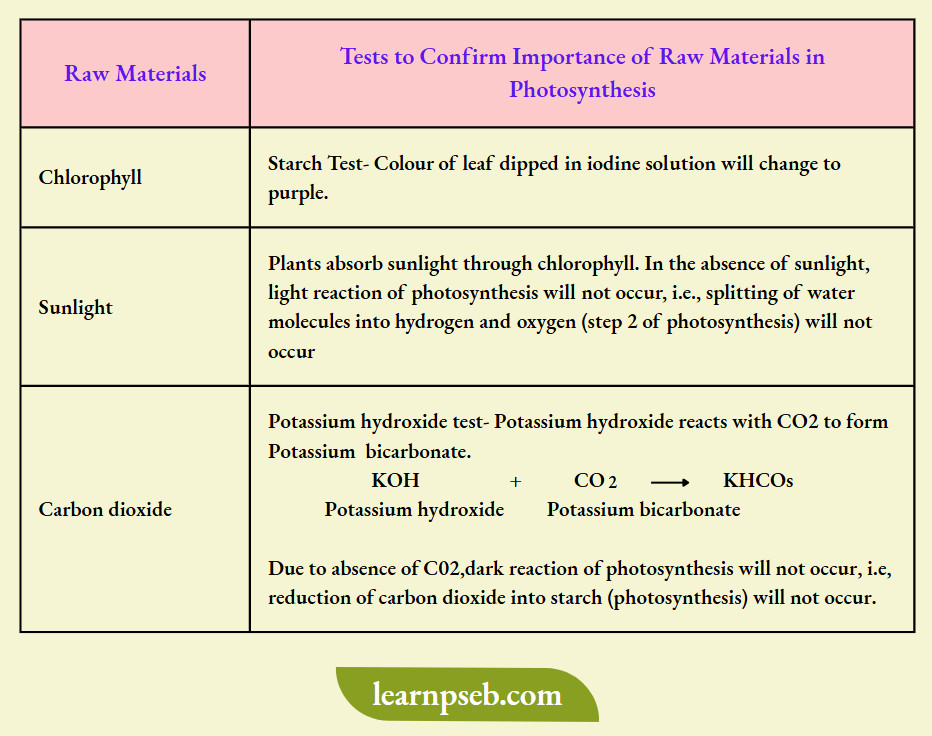
Parts Of Leaf And Their Functions
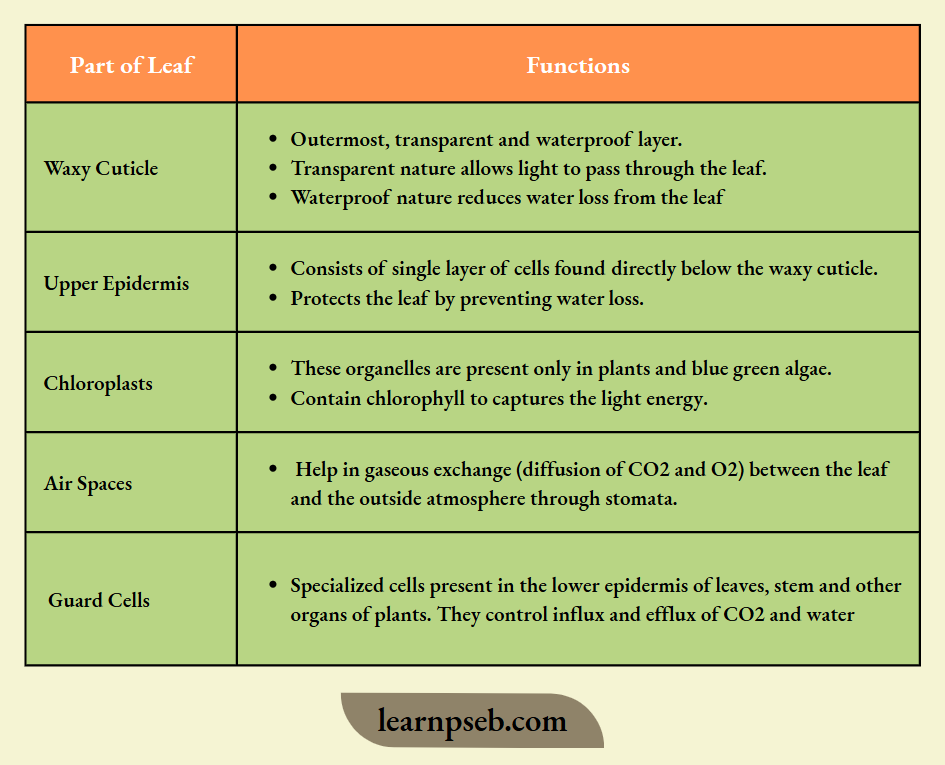
Summary Of Opening And Closing Of Stomata
Life processes class 10 notes
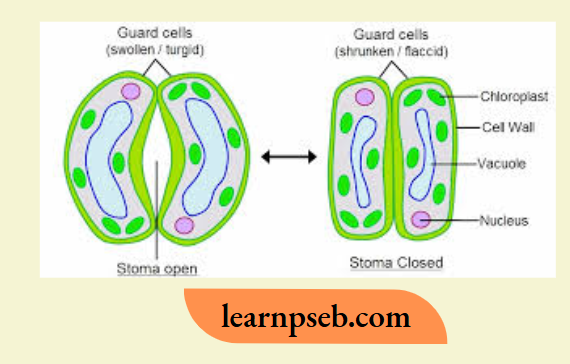
Five main factors that determine the opening and closing of stomata are:
- Light – Stomata open in blue and red light. This is because blue and red light stimulate the production of malic acid by converting starch into sugar. UV light and green light do not result in stomatal opening because aforementioned conversion does not occur.
- Temperature – Stomatal opening is directly proportional to light. Therefore, stomata open in day and close at night.
- Carbon Dioxide Concentration – Stomatal opening is inversely proportional to carbon dioxide concentration. Therefore, stomata open at low CO2 concentration, and close at high CO2 concentration.
- Water Concentration – Swelling of guard cells due to absorption of water increases turgor pressure resulting in opening of stomatal pores, while shrinking of guard cells due to loss of water closes the stomatal pores (cells become flaccid).
- Abscisic Acid (ABA) COncentration – ABA is called the stress hormone of plants. When there is a deficiency of water in leaves. ABA concentration increases leading to closure of stomata. In this way, ABA helps the plant to survive during unfavourable conditions of the environment.
Difference Between Function Of Stomata And Guard Cells
PSEB Class 10 Biology Solutions Chapter 1
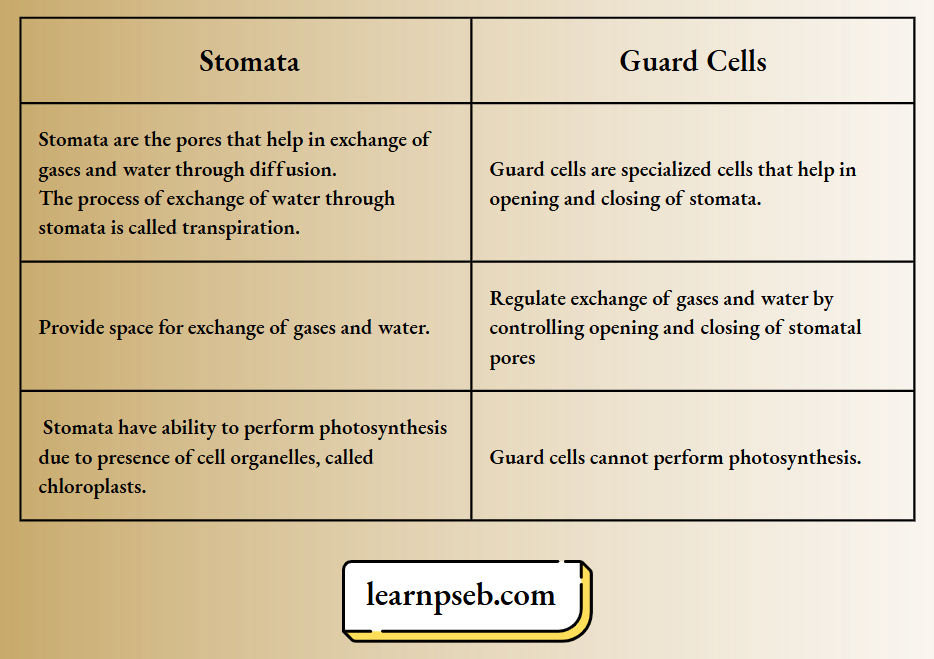
Flow Chart And Summary Of Holozoic Nutrition
Life processes class 10 notes
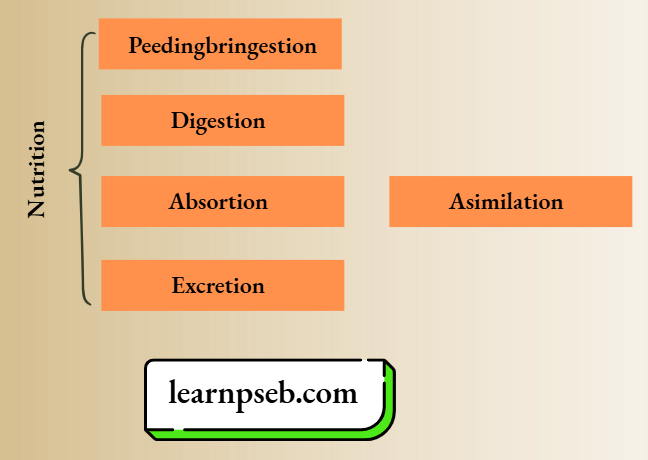
Please Note: See the bracket in above flow chart covers onlyfour steps, i.e., excretion or eaestion is not considered to be a part of nutrition.
- Ingestion means process of taking in food.
- Digestion means breaking down of complex food substances into smaller soluble substances with the help of enzymes.
- Absorption means process by which the products of digestion are absorbed by the blood for supplying to the rest of the body.
- Assimilation means absorbed food is utilized to provide energy and help in growth and development of cells and tissues.
- Excretion means removal of undigested waste from the body.
Life processes class 10 full chapter explanation
Holozoic Nutrition In Unicellular Organisms- Amoeba Vs Paramecium
1. Difference Amoeba Vs Paramecium
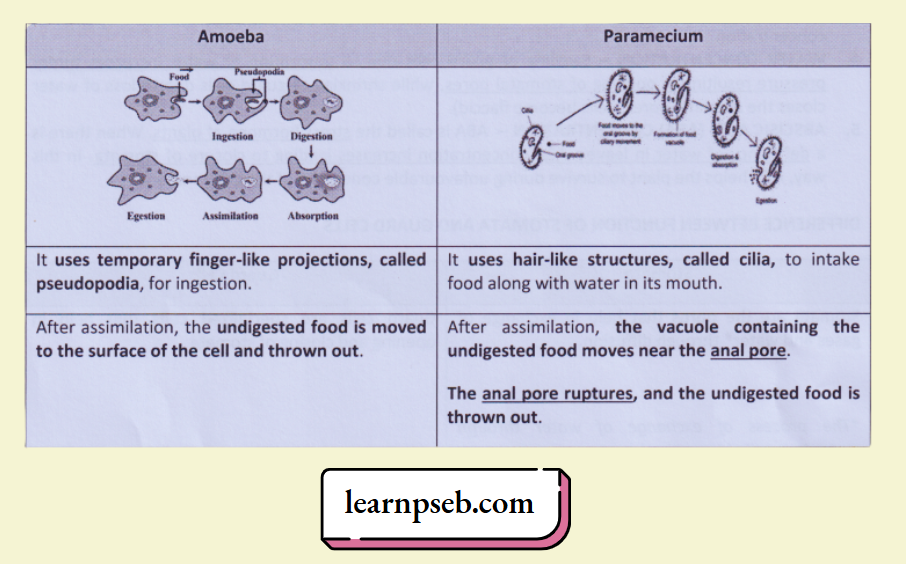
2. Similarity Between Amoeba And Paramecium
- Both follow holozoic mode of nutrition, i.e., in both organisms, the process of nutrition involves ingestion, digestion, absorption, assimilation and egestion.
- Both organisms undergo intracellular digestion.
Life processes class 10 full chapter explanation
Flow Chart Of Nutrition In Multi-Cellular Organisms- Human Beings
Life Processes PSEB Class 10 Notes
- In human beings, the nutrition is performed by alimentary canal and the associated glands.
- Alimentary canal consists of mouth (or buccal cavity), oesophagus (or food pipe), stomach, small intestine, large intestine, rectum and anus.
- Four Glands associated with the process of nutrition are salivary glands, gastric glands, liver and pancreas.
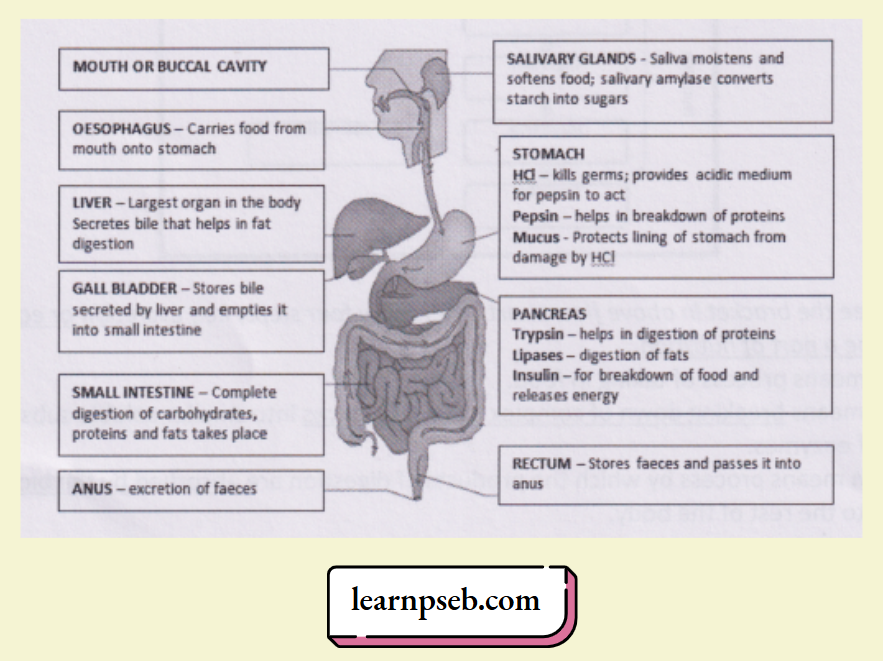
Flow Chart Showing Dental Caries Or Tooth Decay
- Dental caries or tooth decay occurs when bacteria acting on sugars produce acids due to which food particles stick to the teeth to form dental plaque.
- When plaque covers the teeth, saliva (which is alkaline in nature) cannot reach the tooth surface to neutralise the acid.
- This may cause gradual softening of enamel and dentine.
- If untreated, microorganisms may invade the pulp, causing inflammation and infection.
- Dental caries can be prevented by regularly brushing the teeth after eating. This removes the plaque before the bacteria produce acids.
Life processes class 10 full chapter explanation
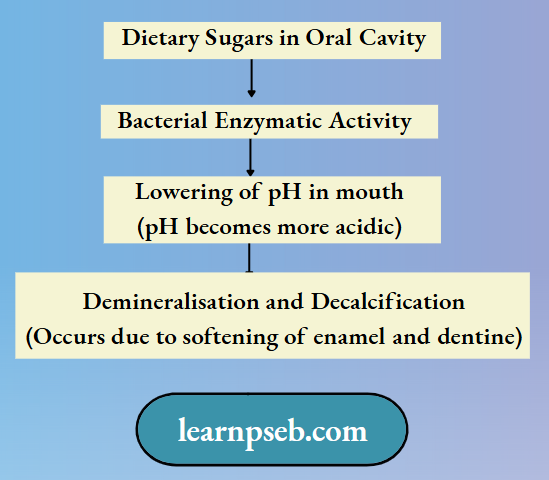
Starch Iodide Test To Check The Presence Of Starch In Saliva- In this test, when a solution of iodine is added to saliva (containing starch), a blue black colour is obtained as shown in figure:
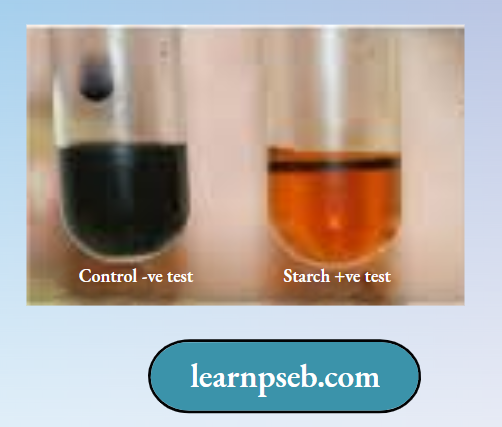
Respiration
It is the process in which oxidation of complex organic substances takes place by taking in oxygen and giving out carbon dioxide to obtain energy in the form of ATP molecules. Respiration is a catabolic process because it involves breakdown of glucose molecules.
Life processes definition and examples
Types Of Respiration
Note: The first step of respiration is same in all the cases, i.e., it involves the break-down of glucose (a 6- carbon molecule) into pyruvate (a 3-carbon molecule). This process takes place in the cytoplasm.
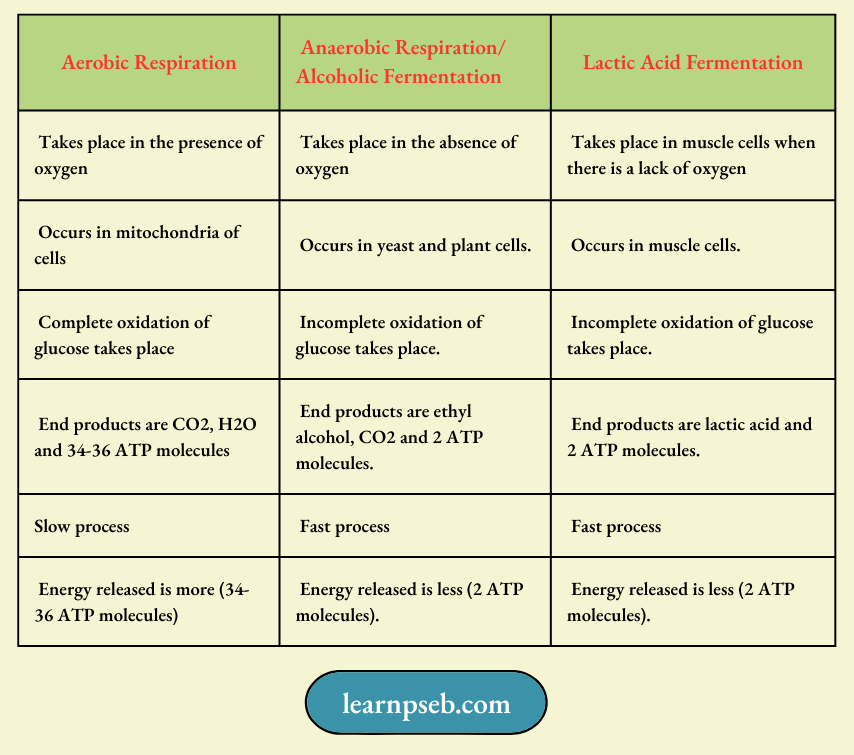
Summary Of Three Types Of Glucose Breakdown Pathways
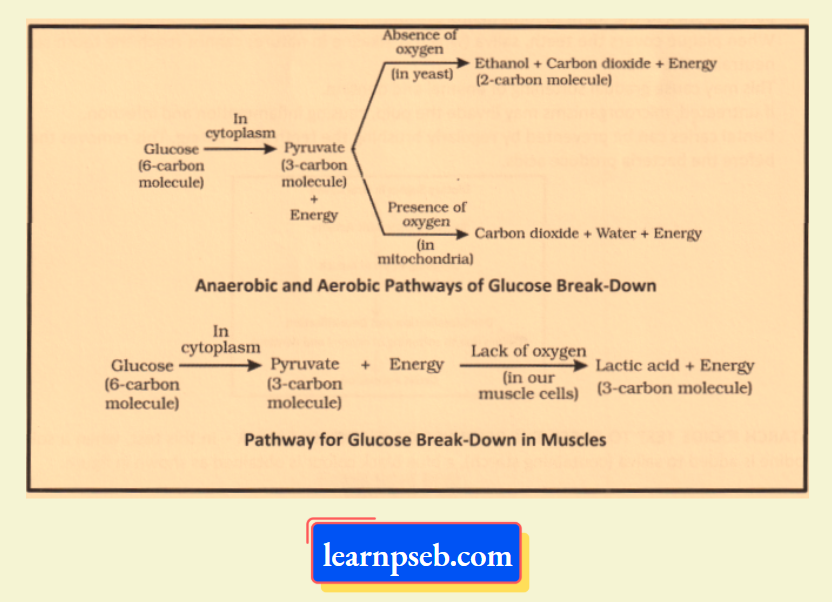
Flow Chart Of Human Respiratory System
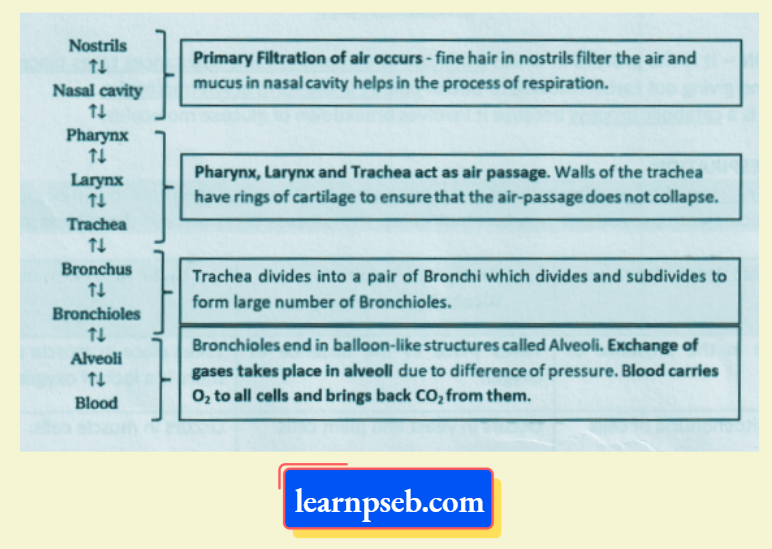
Breathing Mechanism In Humans- It is a three-step process.
- Step 1: Inhalation of oxygen through nostrils.
- Step 2: Exchange of gases (oxygen and carbon dioxide) takes place in alveoli with the help of respiratory pigment, called hemoglobin.
- Step 3: Exhalation of carbon dioxide through nostrils.
Life processes definition and examples
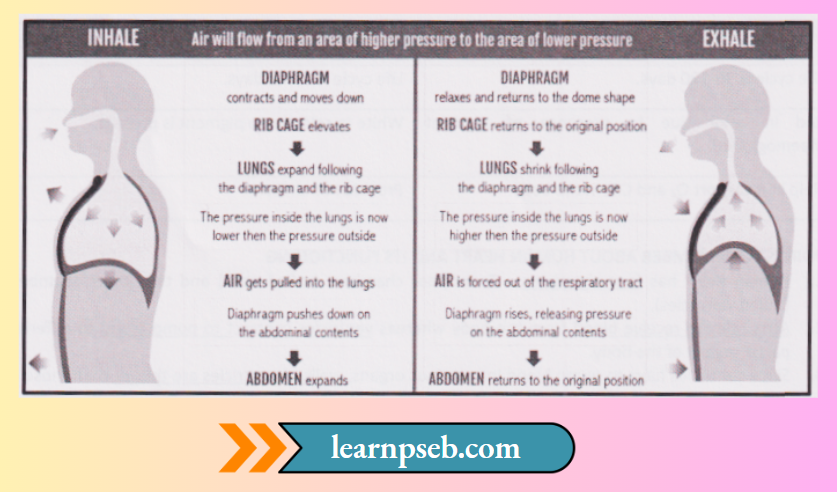
Diagram Showing Exchange Of Gases In Humans
PSEB Class 10 Biology Important Questions Chapter 1
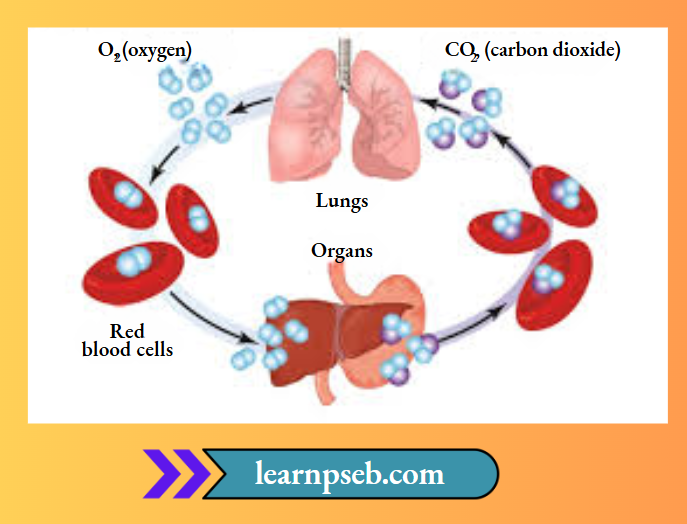
Transportation
- In animals,plants,transportation is carried out through the circulatory system which includes the heart, blood, and blood vessels.
- In plants, it occurs through specialized tissues called xylem(transports water and minerals) and phloem (transports food).
Life processes definition and examples
Blood
Blood is a connective tissue. It performs the functions of transport of food, oxygen and waste materials in the body. Blood has three main components, viz., plasma, blood cells (red and white blood cells), and platelets.
Functions Of Components Of Blood
- Plasma- Transport of nutrients, waste products, antibodies, clotting proteins and hormones.
- Blood Cells- RBCs (transport of O2 and CO2), WBCs (provide immunity)
- Platelets- help in blood clotting.
Difference Between Red Blood Cells (Rbcs) And White Blood Cells (Wbcs)
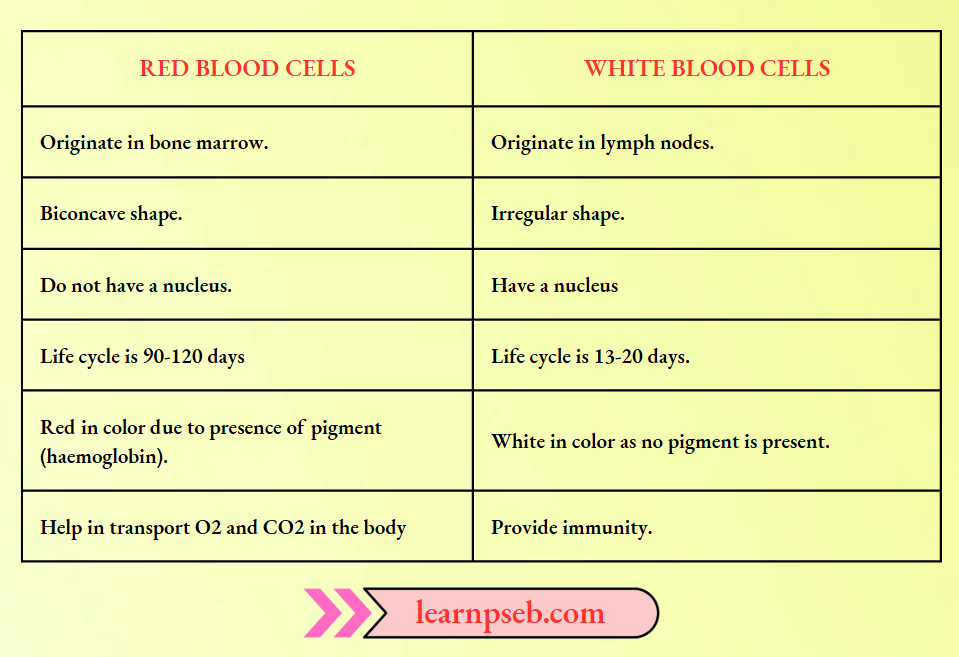
Points To Remember About Human Heart And Its Functioning
- Human heart has four chambers – Two upper chambers (called atria) and two lower chambers (called ventricles).
- Atria relax to receive blood from the body whereas ventricles contract to pump blood to different parts/ organs of the body.
- Since ventricles have to pump blood into various organs, walls of ventricles are thicker than those of atria.
- Valves in the heart ensure that blood does not flow backwards when the atria or ventricles contract.
- Blood pressure is the force exerted by blood on the walls of a blood vessel. It is greater in arteries than in veins. Blood pressure of blood inside the artery during ventricular contraction is called systolic pressure and pressure in artery during ventricular relaxation is called diastolic pressure.
- Normal systolic pressure is about 120 mm of He and diastolic pressure is 80 mm of He. It is measured with an instrument called sphygmomanometer.
Life processes class 10 diagram
Flow Chart Of Blood Circulation In Human Beings
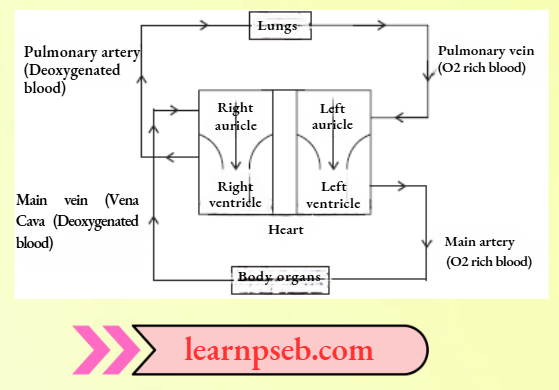
Double Circulation In Humans And Its Advantages
In human beings, blood passes through the heart twice during one cardiac cycle. The deoxygenated blood comes to the heart and goes to the lungs for oxygenation. Simultaneously, the oxygenated blood comes to the heart from lungs and goes to different organs.
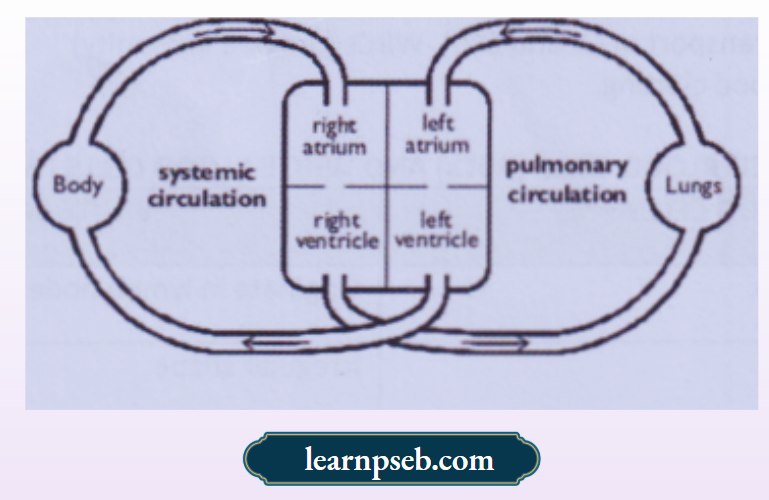
Difference Between Pulmonary Circulation And Systemic Circulation
Life processes class 10 diagram
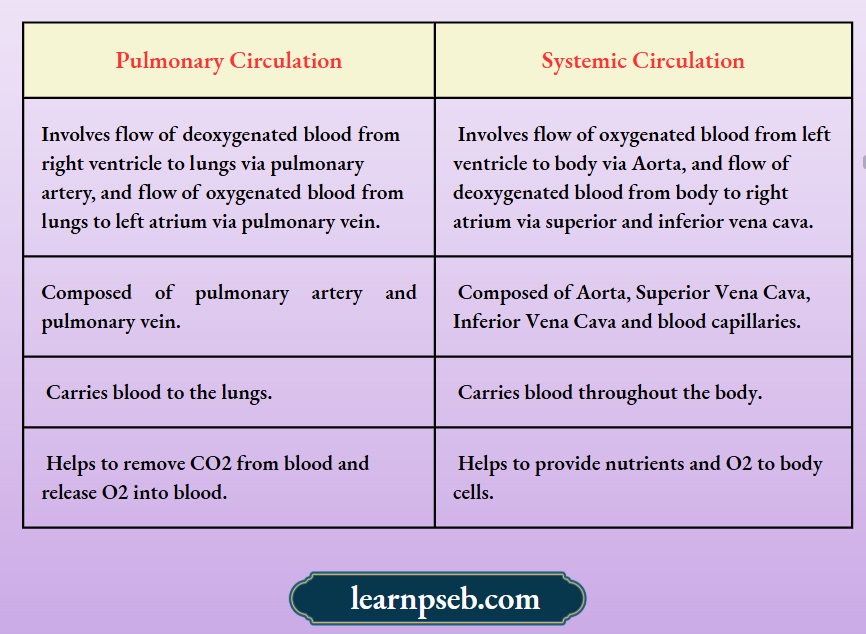
Difference Between Arteries And Veins
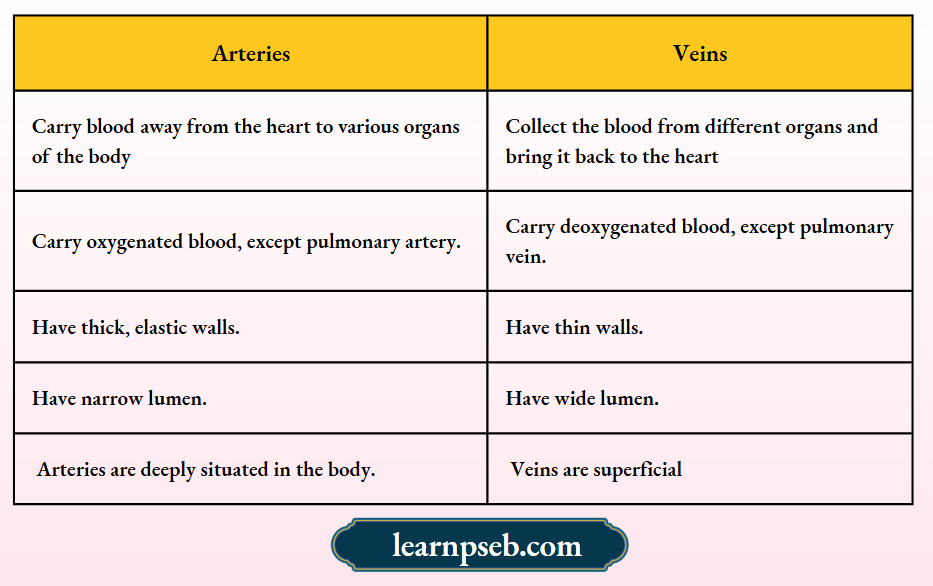
Lymph Or Tissue Fluid
It is a colourless fluid that contains a high concentration of white blood cells and plays an important role in the immune response. It is similar to the plasma of blood but it contains less protein compared to plasma.
Life processes class 10 diagram
Difference Between Blood And Lymph
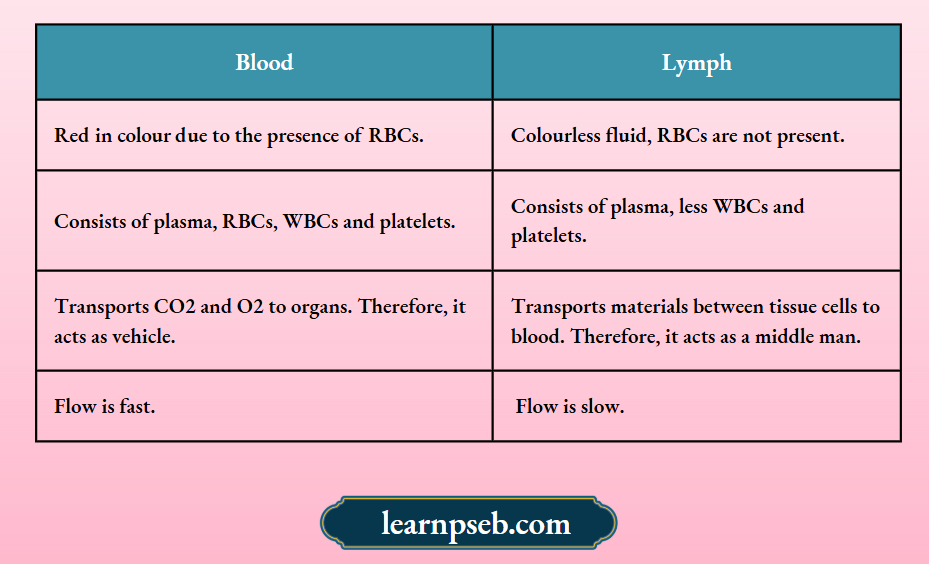
Transportation In Plants
Two types of conducting tissues in plants are:
- Xylem helps in the transport of water and minerals (obtained from the soil).
- Phloem helps in the transport of products of photosynthesis (from leaves to other parts of the plant), respectively.
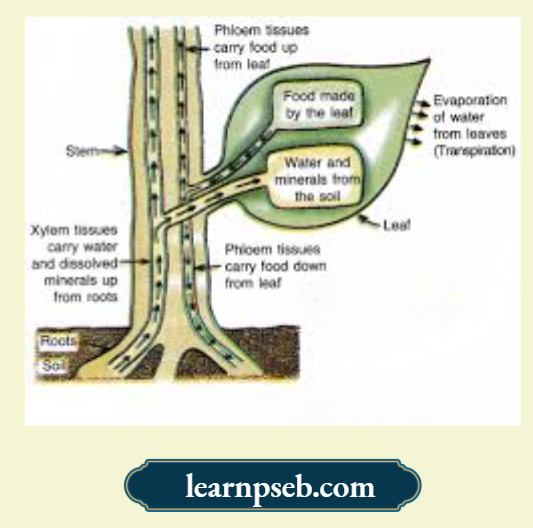
Differences Between Xylem And Phloem
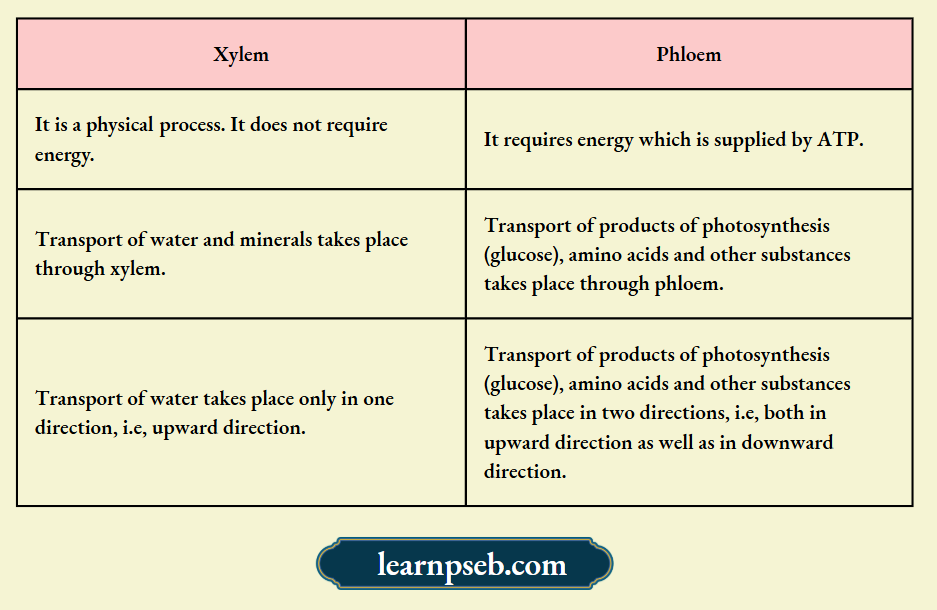
Ascent Of Sap – The upward movement of water and minerals from roots to different plant parts is called ascent of sap.
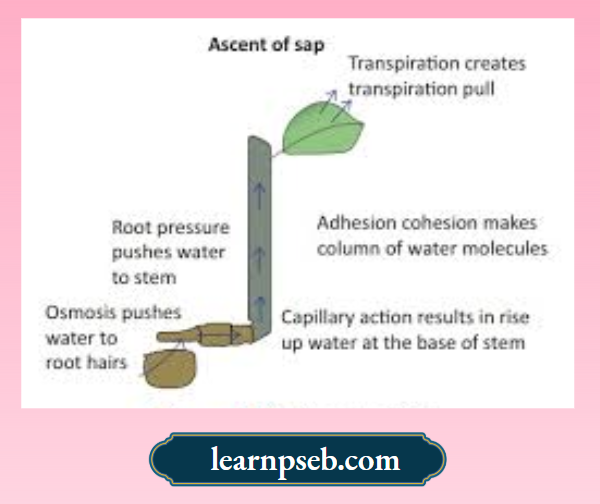
Factors affecting ascent of sap are:
- Osmosis- It pushes water from soil to root hair.
- Root pressure- It pushes water from root hair to base of stem.
- Capillary action- Water rises up to some height of stem due to capillary action.
- Adhesion-cohesion of water molecules – Water molecules make a continuous column in the xylem because of these forces.
- Transpiration- Loss of water vapour through stomata creates vacuum resulting in suction of water, called transpiration pull. The transpiration pull sucks the water column from the xylem tubes, and thus, water is able to rise to great heights in even the tallest plants.
Life processes class 10 NCERT solutions
Excretion
Excretion is the process of removal of gaseous wastes (produced during photosynthesis or respiration) and nitrogeneous wastes (produced during metabolic activities) from the body of an organism.
PSEB Class 10 Science Chapter 1 Solutions
Mode of excretion depends upon the level of structural organization of the organism.
- In Unicellular Organisms, they are removed by simple diffusion.
- In Multicellular Organisms, they are removed by a set of organs which together form the excretory system.
Excretory Organs In Human Beings
Excretory organs in human beings are broadly classified into two categories, viz. main excretory organ (Kidneys) and accessory excretory organs (lungs, liver and skin).

Points To Remember About Human Excretory System
- Nephron is the functional unit of the kidney. It produces urine and cleanses blood by removing waste and excess substances from it. Each kidney has millions of nephrons in it.
- Nephron is composed of a renal corpuscle (glomerulus within Bowman’s capsule), a proximal tubule, an intermediate tubule (loop of Henle), a distal convoluted tubule and connecting ducts.
- If one kidney is damaged or removed, then the other kidney alone can fulfil excretory needs.
- In case of failure of both the kidneys, the function of kidneys needs to be performed artificially with the help of a machine. The process is called hemodialysis.
- Function of hemodialysis is similar to kidneys, except that there is no reabsorption involved.
- Kidney transplantation is the long term solution in case of failure of both the kidneys.
- Kidneys can be donated while the donor is still alive irrespective of his/her age, sex or religion.
Life processes class 10 NCERT solutions
Flow Diagram Of Human Excretory System
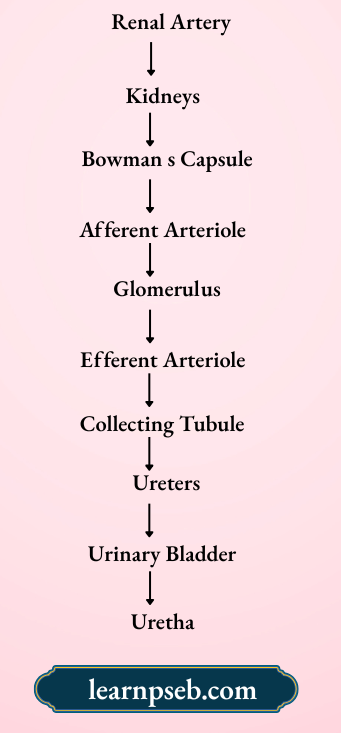
Important Points About Excretion In Plants
Plants use the following ways for excretion:
- Gaseous wastes (excess carbon dioxide and oxygen) are excreted through the stomata.
- Excess water is excreted by transpiration through stomata.
- Many plant waste products are stored in cellular vacuoles in leaves that fall off.
- Some waste products are stored as resins and gums, especially in old xylem.
- Aquatic plants excrete metabolic wastes through diffusion. Terrestrial plants excrete metabolic wastes into the soil.
Chapter 1 Life Processes Reason- Assertion Questions And Answers
For question provided below, two statements are given—one labelled Assertion (A) and the other labelled Reason (R). Select the correct answer to these questions from the codes (1), (2), (3) and (4) as given below:
- Both A and R are true, and R is the correct explanation of the assertion.
- Both A and R are true, but R is not the correct explanation of the assertion.
- A is true, but R is false.
- A is false, but R is true.
Question 1. Assertion: Bile helps in the emulsification of fats.
Reason: Bile makes acidic food coming from the stomach alkaline so that pancreatic enzymes can act on it.
Answer: 2. Both A and R are true, but R is not the correct explanation of the assertion.
Question 2. Assertion: Lymph is a light-yellow liquid which flows only in one direction.
Reason: Lymph protects the body by making antibodies.
Answer: 2. Both A and R are true, but R is not the correct explanation of the assertion.
Question 3. Assertion: Diffusion does not meet the high energy requirements of multicellular organisms.
Reason: Diffusion is a fast process but only occurs at the surface of the body.
Answer: 3. A is true, but R is false.
Question 4. Assertion: Saliva contains an enzyme called amylase.
Reason: Amylase helps to break down simple sugars like glucose into complex molecules like starch.
Answer: 1. Both A and R are true, and R is the correct explanation of the assertion.
Question 5. Assertion: Phloem tissue transports the food from the leaves to the other parts of the plant.
Reason: The movement of food in phloem takes place by diffusion.
Answer: 3. A is true, but R is false.
Question 6. Assertion: Arteries are thick walled and elastic in nature.
Reason: Arteries have to transport blood away from the heart.
Answer: 2. Both A and R are true, but R is not the correct explanation of the assertion.
Question 7. Assertion (A): Plants lack excretory organs.
Reason (R): Plants usually absorb essential nutrients.
Answer: 2. Both A and R are true, but R is not the correct explanation of the assertion.
Question 8. Assertion (A): In anaerobic respiration, one of the end product is alcohol.
Reason (R): There is an incomplete breakdown of glucose.
Answer: 1. Both A and R are true, and R is the correct explanation of the assertion.
Question 9. Assertion (A): In plants there is no need of specialised respiratory organs.
Reason (R): Plants do not have great demands of gaseous exchange.
Answer: 1. Both A and R are true, and R is the correct explanation of the assertion.
Question 10. Assertion (A): Bile is essential for digestion of lipids.
Reason (R): Bile juice contains enzymes.
Life processes class 10 questions and answers
Answer: 3. A is true, but R is false.
Question 11. Assertion (A): Carbohydrate digestion mainly takes place in small intestine.
Reason (R): Pancreatic juice contains the enzyme lactase.
Answer: 3. A is true, but R is false.
Question 12. Assertion (A): Aerobic respiration requires less energy as compared to anaerobic respiration.
Reason (R): Mitochondria is the powerhouse of the cell.
Answer: 4. A is false, but R is true.
Question 13. Assertion (A): Human heart is four-chambered.
Reason (R): Vena cava is the only artery that supplies deoxygenated blood to the heart.
Answer: 3. A is true, but R is false.
Question 14. Assertion (A): Energy is required to carry out different life processes.
Reason (R): Energy is obtained in the form of ATP in the mitochondria.
Answer: 1. Both A and R are true, and R is the correct explanation of the assertion.
Question 15. Assertion (A): Rings of cartilage are present in the throat.
Reason (R): These ensure that the air-passage does not collapse.
Answer: 1. Both A and R are true, and R is the correct explanation of the assertion.
Question 16. Assertion (A): Pyruvate is a six-carbon molecule.
Reason (R): It is prepared in the cytoplasm as the first step to cellular respiration.
Answer: 4. A is false, but R is true.
Life processes class 10 questions and answers
Chapter 1 Life Processes Case Or Source Based Question And Answers
Question 1. The growing size of the human population is a cause of concern for all people. The rate of birth in a given population will determine its size. Reproduction is the process by which organisms increase their population. The process of sexual maturation for reproduction is gradual and takes place while general body is still going on. Some degree of sexual maturation does not necessarily mean that mind or body is ready for sexual acts or for having and bringing up children. Various contraceptive devices are being used by human beings to control the size of population.
1. Which of the following is a common sign of sexual maturation in both boys and girls?
- Development of breasts
- Growth of pubic hair
- Adam’s apple
- Broadening of hips
Answer: 2. Growth of pubic hair
2. Which of the following is an IUCD?
- Copper-T
- Diaphragm
- Oral pill
- Tubectomy
Answer: 1. Copper-T
3. Which among the following is not a sexually transmitted disease?
- Gonorrhoea
- AIDS
- Syphilis
- Cholera
Answer: 4. Cholera
4. A couple wants to space the birth of their second child. Which of the following preventive measure could be taken by the husband?
- Oral pills
- Diaphragms
- Tubectomy
- Condoms
Answer: 4. Condoms
Life processes class 10 questions and answers
5. A pregnant woman visits the doctor to determine the sex of the child. Why is she denied of this testing?
- It is a complicated test.
- It may result in female foeticide.
- It is an expensive test.
- It is harmful test for the developing foetus
Answer: 2. It may result in female foeticide.
Question 2. Blood vessels are the channels or conduits through which blood is distributed to body tissues. The vessels make up two closed systems of tubes that begin and end at the heart. One system, the pulmonary vessels, transports blood from the right ventricle to the lungs and back to the left atrium. The other system, the systemic vessels, carries blood from the left ventricle to the tissues in all parts of the body and then returns the blood to the right atrium.
1. Which system carries blood from the right ventricle to the lungs?
- Pulmonary
- Systemic
- Hepatic
- Gastric
Answer: 1. Pulmonary
Life processes class 10 important questions
2. Systemic vessels carry blood from:
- Right ventricle to lungs
- Left ventricle to body tissues
- Body tissues to left ventricle
- Lungs to right ventricle
Answer: 2. Left ventricle to body tissues
3. Which blood vessels carry blood away from the heart?
- Veins
- Capillaries
- Arteries
- Venules
Answer: 3. Arteries
4. The exchange of materials between the blood and tissue cells is done by:
- Capillaries
- Veins
- Venules
- Arteries
Answer: 1. Capillaries
5. Which blood vessels carry blood towards the heart?
- Veins
- Capillaries
- Arteries
- Venules
Answer: 1. Veins
Life processes class 10 assertion and reason questions
Question 3. The food material taken in during the process of nutrition is used in cells to provide energy for various life processes. Diverse organisms do this in different ways – some use oxygen to breakdown glucose completely into carbon dioxide and water, some use other pathways that do not involve oxygen.
1. Which three carbon molecule is formed during the breakdown of glucose?
- Lactic acid
- Glyceraldehyde
- Acetic acid
- Pyruvate
Answer: 4. Pyruvate
2. The process in which pyruvate may be converted into ethanol and carbon dioxide is:
- Germination
- Fermentation
- Cellular respiration
- Oxidation
Answer: 2. Fermentation
3. Breakdown of pyruvate using oxygen takes place in the:
- Cytoplasm
- Stroma
- Mitochondria
- Cellular matrix
Answer: 3. Mitochondria
4. The breakdown of pyruvate in the absence of oxygen producing lactic acid occurs primarily in the:
- Muscle cells
- Brain cells
- Cardiac cells
- Nerve cells
Answer: 1. Muscle cells
5. Observe the graph and interpret which of the following is true w.r.t. rate of respiration?
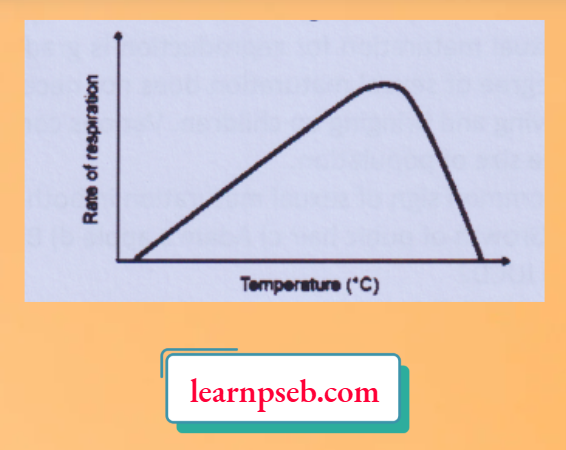
- Increases with an increase in temperature
- Increases first and then decreases with an increase in temperature
- Decreases with an increase in temperature
- Decreases first and then increases with an increase in temperature
Answer: 2. Increases first and then decreases with an increase in temperature
Question 4. The human respiratory system consists of a group of organs and tissues that help us to breathe. Lungs are the primary organs of the respiratory system which help in the exchange of gases. The other main parts of this system include a series of airways for air passages, blood vessels and the muscles that facilitate breathing.
Life processes class 10 quick revision
1. Which are the primary organs of respiration in humans?
- Lungs
- Bronchi
- Trachea
- Pharynx
Answer: 1. Lungs
2. Nostrils are divided by a framework of cartilaginous structure termed as:
- Flaps
- Cartilage
- Septum
- Rings
Answer: 3. Septum
3. Respiration in humans is primarily:
- Aerobic
- Anaerobic
- Partially anaerobic
- Partially aerobic
Answer: 1. Aerobic
4. Exchange of gases takes place in the:
- Bronchi
- Alveoli
- Trachea
- Bronchioles
Answer: 2. Alveoli
5. The percentage of nitrogen in exhaled air is:
- 78%
- 0.3%
- 21%
- 0.03%
Answer: 1. 78%
Question 5.
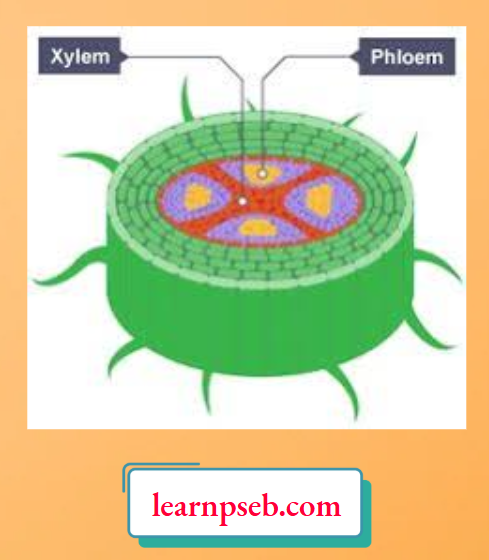
Plants have tissues to transport water, nutrients and minerals. Xylem transports water and mineral salts from the roots up to other parts of the plant, while phloem transports sucrose and amino acids between the leaves and other parts of the plant.
Life processes class 10 quick revision
1. Which of the following processes will not occur in the absence of xylem?
- Transport of water
- Conduction of food
- Transport of minerals
- Both a) and c)
Answer: 4. Both a) and c)
2. Transport of food by the phloem is called
- Transpiration
- Translocation
- Guttation
- Adhesion
Answer: 1. Transpiration
3. Which of the following is not a characteristic of xylem?
- Living cells
- Lack of cytoplasm
- Impermeable to water
- Presence of lignin
Answer: 2. Lack of cytoplasm
4. In phloem, transport occurs between where the substances are made, i.e. ______ and where they are used or stored, i.e. ______
- Sink, source
- Source, sink
- Origin, destination
- Destination, origin
Answer: 2. Source, sink
5. ___________ is the process which involves transport of water and minerals.
- Transpiration
- Translocation
- Guttation
- Adhesion
Answer: 1. Transpiration
Question 6. The carbon and energy requirements of the autotrophic organism are fulfilled by photosynthesis. It is the process by which autotrophs take in substances from the outside and convert them into stored forms of energy.
1. Which of the following acts as an internal energy reserve in plants?
- Starch
- Glycogen
- Chitin
- Cellulose
Answer: 1. Starch
2. Which of the following processes are not a part of the process of photosynthesis?
- Absorption of light energy by chlorophyll
- Conversion of light energy to chemical energy and splitting of water molecules
- Oxidation of carbon dioxide to carbohydrates
- Reduction of carbon dioxide to carbohydrates
Answer: 3. Oxidation of carbon dioxide to carbohydrates
Life processes class 10 quick revision
3. Which of the following structures is absolutely essential for the process of photosynthesis?
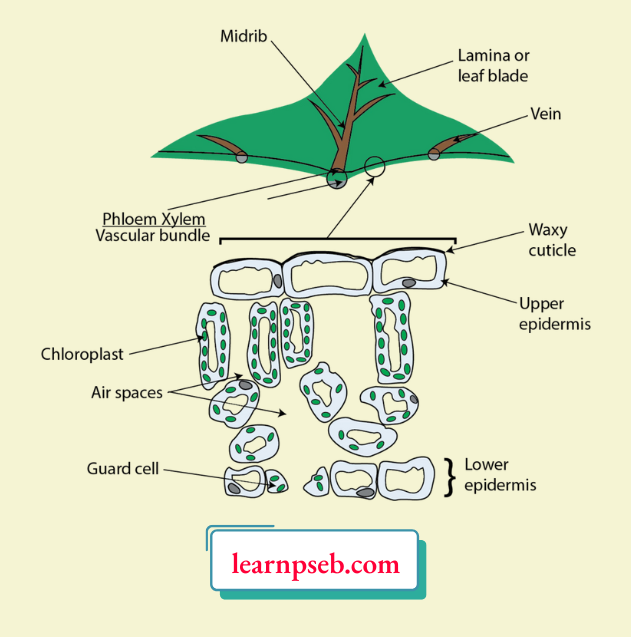
- Lower epidermis
- Chloroplasts
- Phloem
- Waxy cuticle
Answer: 2. Chloroplasts
4. What is the role of stomata in process of photosynthesis?
- Gaseous exchange
- Absorption of light
- Transfer of nutrients
- Emission of light
Answer: 1. Gaseous exchange
Question 7. Tooth decay starts when the pH of the mouth is lower than 5.5. Tooth enamel, made up of calcium phosphate is the hardest substance in the body. It does not dissolve in water, but is corroded when the pH in the mouth is below 5.5. Bacteria present in the mouth produce acids by degradation of sugar and food particles remaining in the mouth after eating. The best way to prevent this is to clean the mouth after eating food. Using toothpastes, which are generally basic, for cleaning the teeth can neutralise the excess acid and prevent tooth decay.
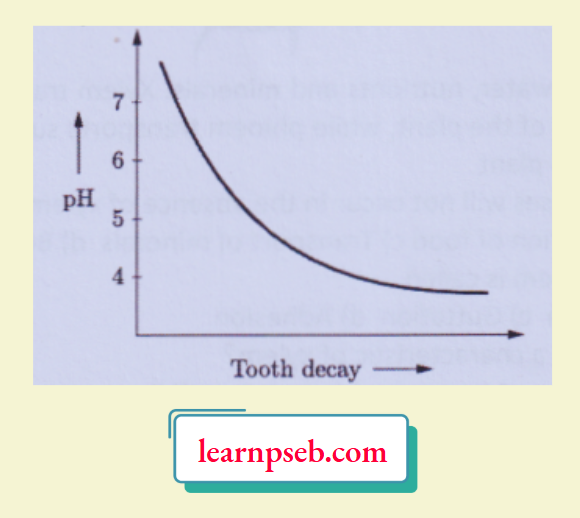
1. The tooth decay be prevented:
- By rinsing mouth with excess of water after eating.
- By using basic toothpaste.
- Both (a) and (b)
- Preventing use of acidic substances like lemon, etc.
Answer: 3. Both (a) and (b)
2. Teeth enamel is made of a substance called:
- Aluminium
- Calcium phosphate
- Iron
- Diamond
Answer: 2. Calcium phosphate
3. Tooth decay in the mouth starts when:
- pH of mouth is below 5.5
- pH of mouth is 7.6
- pH of mouth is 7.5
- pH of mouth is 7.52.
Answer: 1. pH of mouth is below 5.5
4. The acidity in the mouth is due to:
- Undigestion of food.
- Degradation of sugar and food particles remaining in the mouth by bacteria.
- Drinking of Mosambi juice.
- Eating of acidic substances like tomatoes, oranges etc.
Answer: 2. Degradation of sugar and food particles remaining in the mouth by bacteria.
PSEB Class 10 Biology Solutions For Chapter Chapter 5 Our Environment
PSEB Class 10 Biology Solutions For Chapter Chapter 5: Our Environment
Ecosystem
A system consisting of all living organisms and their physical environment, functioning together as a unit, is called an ecosystem.
Flow Chart Of Components Of Ecosystem
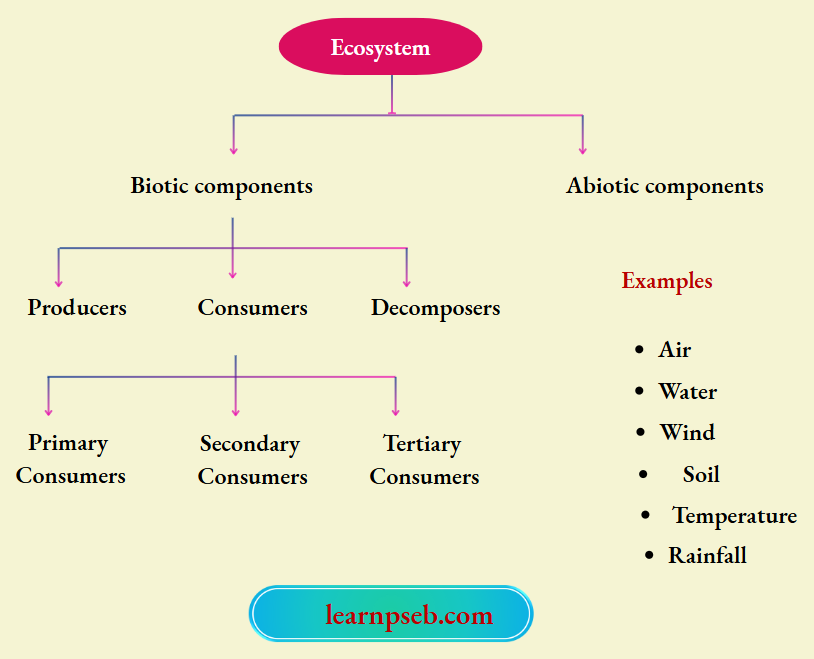
Flow Chart Of Biotic Components
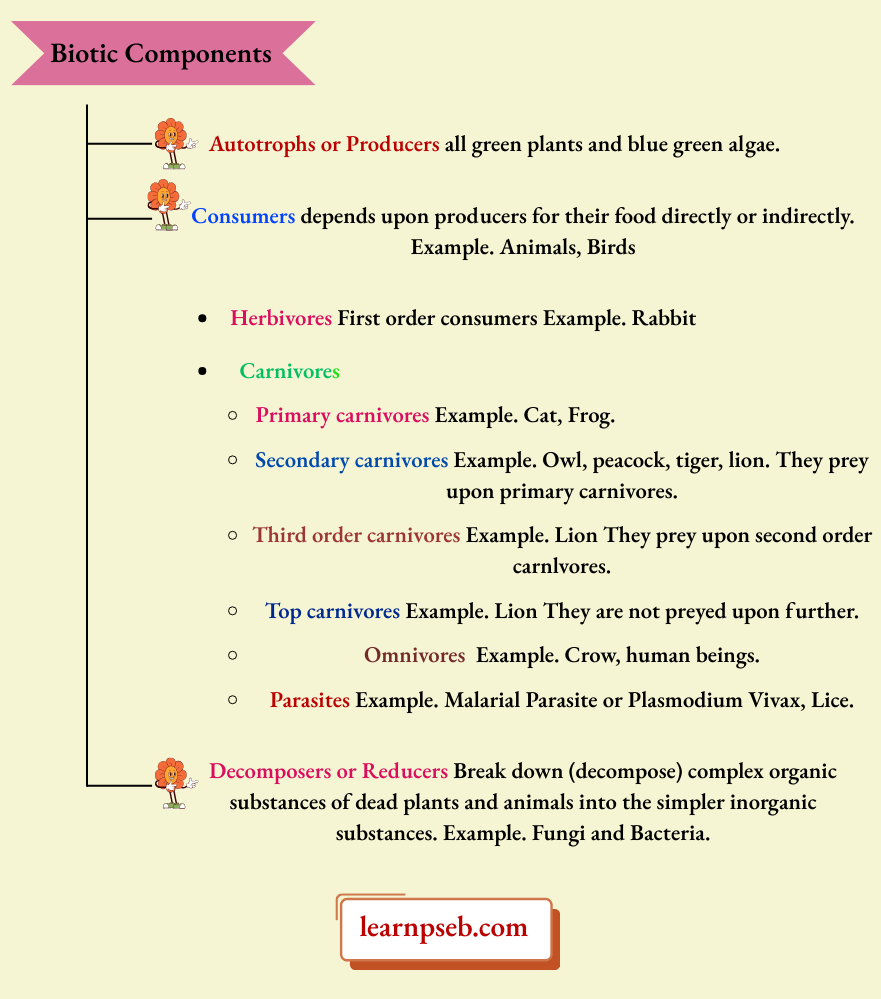
Importance Of Decomposers
- Act as Natural Scavengers by disposing of the wastes and dead bodies of plants and animals. In this way decomposers clean the environment and create space for a living of newer generations of organisms.
- Help in Maintaining Fertility of Soil by releasing minerals and other raw materials trapped in organic matter into the soil.
- Decomposers produce some acids which are useful in solubilization of some minerals.
- Decomposers help in recycling the materials in the biosphere.
Types Of Ecosystems
Two types, viz. Natural Ecosystem and Artificial Ecosystem.
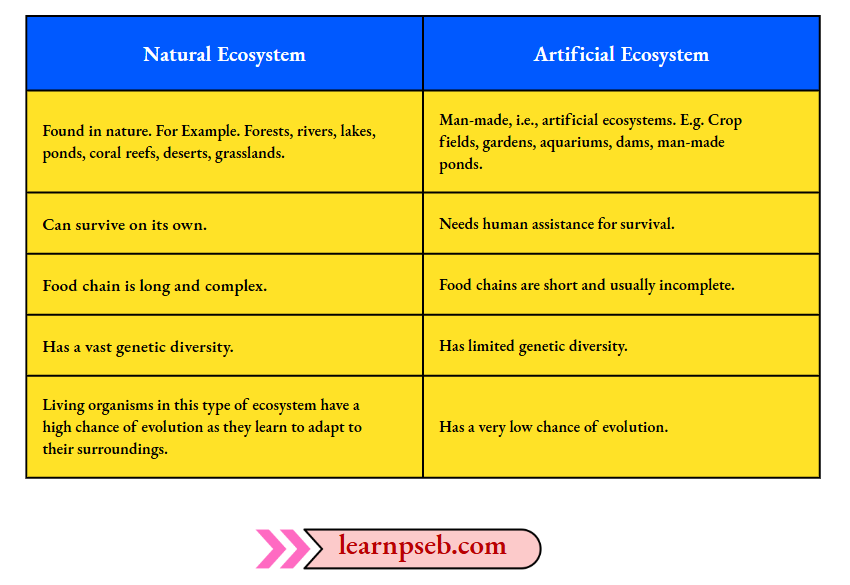
Food Chain
A food chain describes the flow of energy and nutrients through an ecosystem.
Read And Learn More PSEB Class 10 Biology
Important Points About Food Chain
1. Flow of energy in a food chain is unidirectional as shown in diagram.
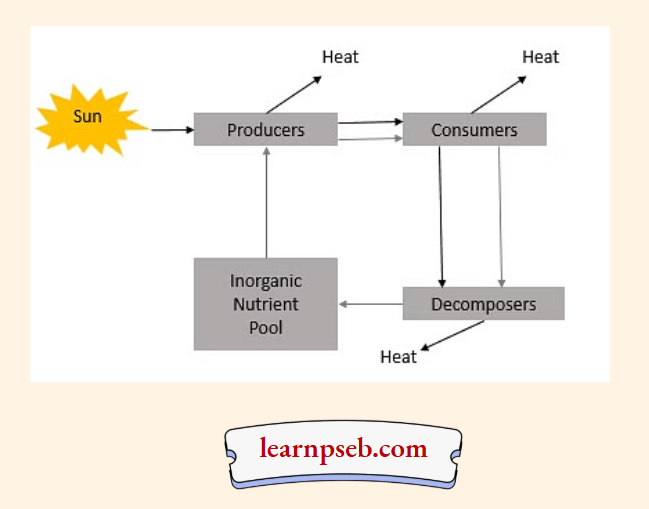
2. Each step or level of the food chain forms a trophic level. Flow of energy in trophic levels of a food chain obeys TEN PERCENT LAW.
According to Ten Percent Law law, there is a gradual decrease in the amount of energy transfer from one trophic level to the next trophic level in a food chain, i.e., only 10% of energy is transferred to next trophic level while 90% of energy is used by that particular trophic level in its life processes. This is shown in diagram below:
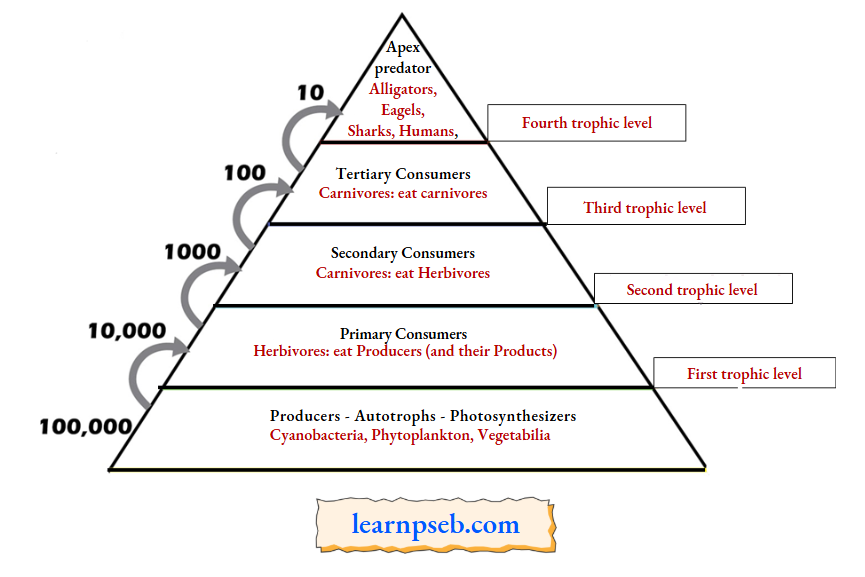
3. Since very less amount of energy is available for the next level of consumers, food chains generally consist of only three or four steps.
4. There are generally a greater number of individuals at the lower trophic levels than at the higher trophic levels.
Food Web – It is defined as a network of organisms which are dependent on each-other.

Difference Between Food Chain And Food Web

Biological Magnification
The increase in concentration of harmful chemical substances like pesticides in the body of living organisms at each trophic level of a food chain is called biological magnification.
An example of biological magnification indicating increase in mercury concentration in aquatic life and humans is provided below:
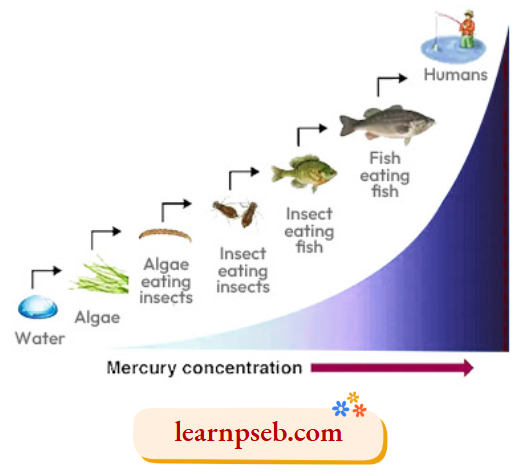
Since human beings occupy the top level in any food chain, the maximum concentrations of these chemicals get accumulated in our bodies.
Environmental Problems – Two main causes of environmental problems are:
- Changes in Environment
- Human Activities
Major Environmental Problems
Depletion of Ozone layer and Pollution (Waste or Garbage Disposal).
Ozone Layer Depletion
- Ozone layer depletion means the thinning of the ozone layer present in the upper atmosphere.
- The decline of Ozone layer thickness in Antarctica was first discovered in 1985 and was termed as OZONE HOLE.
- Ozone Layer Depletion primarily occurred due to excessive use of CFCs (Chloro Flouro Carbon. Freon) used as refrigerants and also in fire extinguishers. It also occurs due to environmental pollution.
- Although ozone is deadly poison, ozone, present at the higher levels of atmosphere, shields the surface of the earth from ultraviolet (UV) radiation from the Sun. Ozone is essential for all aerobic forms of life. Thus, ozone is essential for survival of forms of life in one wav or the other.
- At the higher levels of the atmosphere, higher energy UV radiations split apart some oxygen molecules (O2) into free oxygen (O) atoms. These atoms then combine with the other oxygen molecules to form ozone.
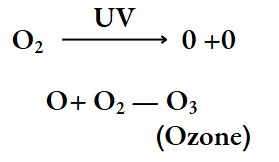
This Ozone, present at the higher levels of atmosphere, shields the surface of the earth from ultraviolet (UV) radiation from the Sun.
However, due to atmospheric pollution, the thickness of the ozone layer is depleting, resulting in poor shielding from UV rays.
Steps Taken To Control Ozone Layer Depletion
In 1987, an agreement was arrived at the United Nations Environment Program (UNEP) with regards to freezing CFC production at 1986 levels.
- It is now mandatory for all the manufacturing companies to make CFC-free refrigerators throughout the world.
- Modern refrigerators usually use a refrigerant called HFC-134a (1.1,1.2-Tetrafluoroethane) instead of Freon. It does not deplete the ozone layer.
Garbage Disposal
Materials generated during our daily activities and in industrial processes that are not useful to us are called waste materials. They can be broadly categorized into two categories, viz. Biodegradable waste and Non-Biodegradable waste.
Differences Between Biodegradable And Non-Biodegradable Waste
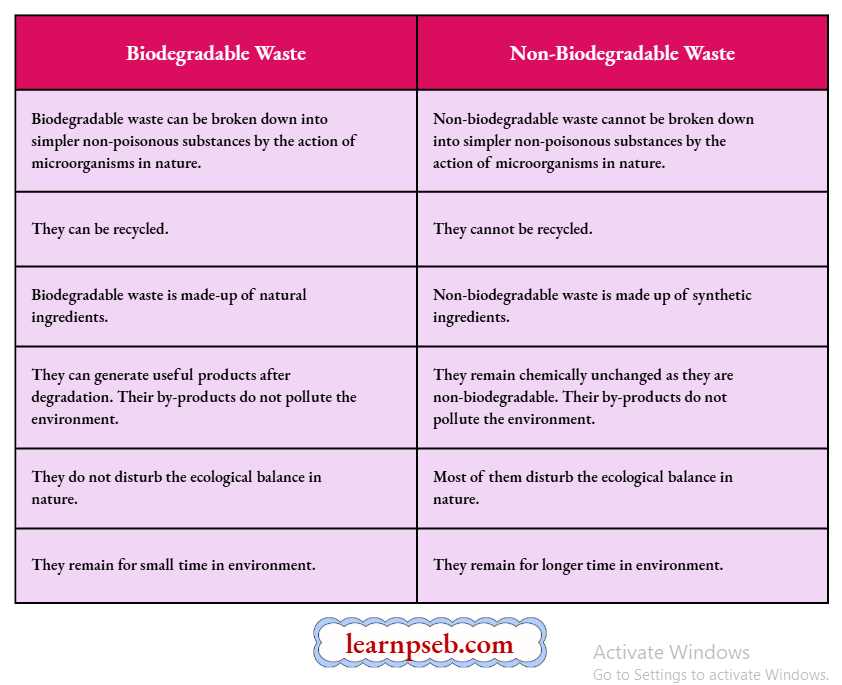
5R’S To Save The Environment
- Refuse means “saying no” to the use of materials which have a harmful effect on the environment. For Example. No to plastics.
- Reduce means we should minimise our use of natural resources, sources of energy and food materials.
- Recycle means that we should collect materials like paper, plastics, glass and metal items. These waste materials should be recycled to obtain these materials again for use.
- Reuse means to encourage to use things again and again instead of throwing them away. For Example. plastic bottles .Re-use is better than recycling as it saves energy.
- Repurpose means using the waste product if one material as an input material for the production of some other material, For Example. Sugarcane waste obtained from sugar industry is being used for the manufacture of paper.
Chapter 5 Our Environment Reason- Assertion Questions And Answers
Following questions consist of two statements – Assertion (A) and Reason (R). Answer these questions selecting the appropriate option given below:
- Both ‘A’ and ‘R’ are true and ‘R’ is correct explanation of the Assertion.
- Both ‘A’ and ‘R’ are true but ‘R’ is not correct explanation of the Assertion.
- ‘A’ is true but ‘R’ is false.
- ‘A’ is false but ‘R’ is true.
Question 1. Assertion (A): Polythene bags and plastic containers are non-biodegradable substances.
Reason (R): They can be broken down by microorganisms in natural simple harmless substances.
Answer: 3. ‘A’ is true but ‘R’ is false.
Question 2. Assertion (A): The concentration of harmful chemicals is least in human beings.
Reason (R): Man is at the apex of the food chain.
Answer: 4. ‘A’ is false but ‘R’ is true.
Question 3. Assertion (A): Ozone is formed in upper atmosphere by 02 in presence of UV radiations.
Reason (R): Ozone depletion will lead to UV rays reaching earth which may cause skin cancer.
Answer: 2. Both ‘A’ and ‘R’ are true but ‘R’ is not correct explanation of the Assertion.
Question 4. Assertion (A): The various components of an ecosystem are interdependent
Reason (R): Food chain and web are formed due to linkage in organisms.
Answer: 1. Both ‘A’ and ‘R’ are true and ‘R’ is correct explanation of the Assertion.
Question 5. Assertion (A): Each step in a food chain is called a trophic level.
Reason (R): Trophic levels are formed by both plants and animals.
Answer: 1. Both ‘A’ and ‘R’ are true and ‘R’ is correct explanation of the Assertion.
Question 6. Assertion (A): Food web consists of only producers.
Reason (R): Specific enzymes are required for breakdown of substances in environment.
Answer: 4. ‘A’ is false but ‘R’ is true.
Question 7. Assertion (A): The function of consumers is to convert organic compound into inorganic compound.
Reason (R): Green plants are called the producers.
Answer: 4. ‘A’ is false but ‘R’ is true.
Chapter 5 Our Environment Case Or Source Based Questions And Answers
Question 1. Plastic bags cause many minor and major ecological and environmental issues. The most general issue with plastic bags is the amount of waste produced. Many plastic bags end up on streets and subsequently pollute major water sources, rivers, and streams. Even when disposed of properly, they take many years to decompose and break down, generating large amounts of garbage over long periods of time. Improperly discarded bags have polluted waterways, clogged sewers and been found in oceans, affecting the ecosystem of marine creatures.
1) Which of the following is non-biodegradable?
- Plastic
- Tea leaves
- Spoilt bread
- Paper
Answer: 1. Plastic
2) Which of the following is likely to cause most pollution?
- Plastic cups
- Paper bags
- Dried leaves
- Broken glassware
Answer: 1. Plastic cups
3) What is the most general issue with plastic bags?
- They are biodegradable
- They are heavy
- They produce a lot of waste
- They are cheaper.
Answer: 3. They produce a lot of waste
4) Which of the following is the effect of plastic pollution?
- Clogging of drains
- Death of marine life
- Loss of aesthetic beauty
- All of these
Answer: 4. All of these
5) Which of the following is the most eco-friendly option?
- Use of paper bags for shopping
- Use of steel plates for dining
- Use of kulhads for tea
- All of these
Answer: 4. All of these
Question 2. All living things need air to breathe. Contamination of air with particles, gases and chemicals that have the potential to adversely affect the health of humans and animals, vegetation and human assets is called air pollution. Major air pollutants are SO2, nitrogen oxides, CO, CFCs, etc. Refer to the given graph showing air quality of three cities.
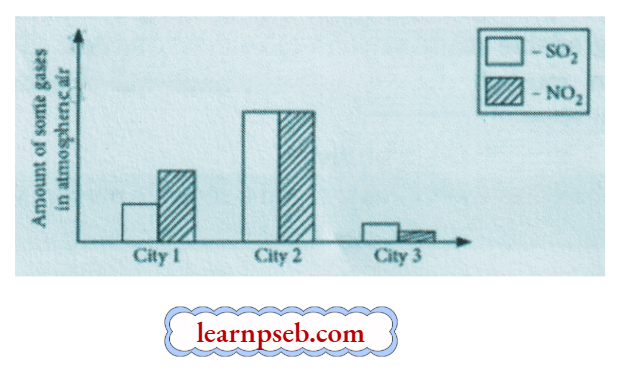
- What can be inferred from the given graph?
- What will be the effect of high concentration of SO2 and NO2 in atmospheric air of city 2?
- What are the harmful effects of acid rain?
Answer:
- Air of city 2 is most polluted as maximum amount of oxides of sulphur and nitrogen are present in its atmospheric air.
- When the rainwater contains large quantities of acids like nitric acid and sulphuric acid formed by dissolution of oxides of nitrogen and sulphur in water it is called acid rain.
- Acid rain damages the foliage thereby decreasing the growth and yield of plants. Soil microbes get killed due to low pH of the soil and results in disturbing the terrestrial ecosystem. Buildings and monuments get corroded and damaged.
Question 3. Several interconnected food chains form a food web. A food web is similar to a food chain but the food web is comparatively larger than a food chain. When there are more cross interactions between different food chains, the food web gets more complex. This complexity in a food web leads to a more sustainable ecosystem.
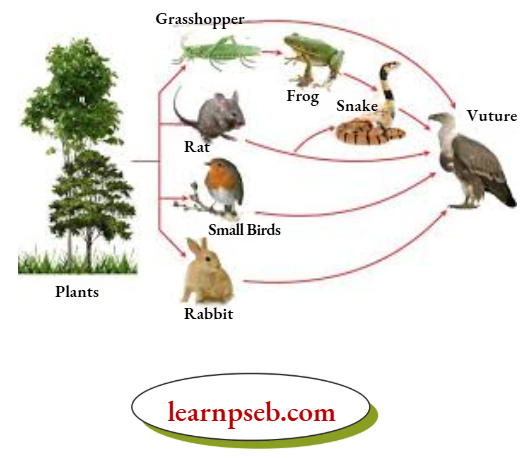
1) Which living being occupies the lowest level in the above web?
Plants
Small birds
Frog
Vulture
Answer: 1. Plants
2) What forms the food of a snake?
- Frog and small birds
- Rat and frog
- Small birds and grasshopper
- Grasshopper and rat
Answer: 2. Rat and frog
3) Which link would get directly disturbed if the population of grasshopper is wiped out?
- Frog
- Snake
- Vulture
- Small birds
Answer: 1. Frog
4) Which organisms in the above food web do not act as herbivores?
- Small birds
- Grasshoppers
- Rat
- Snake
Answer: 4. Snake
5) In the given food web, vulture is said to be
- Herbivore
- Omnivores
- Apex carnivore
- Producer
Answer: 3. Apex carnivore
Question 4. Raman went to picnic with her friends to a nearby park. All of them took with themselves, eatables packed either in aluminium foils, polythenes, paper bags, plastic bottles, cans or in paper cups. They enjoyed their picnic and when teacher called them to be ready for going back, her friends picked up their bags and left all the waste material scattered here and there. But, Raman called them and asked each one to pick up the left over things and put them in the bins marked ‘biodegradable’ and ‘nonbiodegradable’. She also explained the advantages of doing so. Her friends accepted her advice and cleaned the park. Read the given passage and answer the following questions:
- Mention the value reflected by Raman’s initiative.
Answer:
- Raman is good observer, takes initiative and a sensible person, who applies and understands the value of nature.
Question 5. Rohit got into a quarrel with some farmers who were spraying DDT in their field. Many people gathered at the spot to see and enjoy the incident. The angry mob demanded that Rohit should not interfere with the farmers’ job. Rohit tried to explain his point and finally succeeded. The farmers gave up spraying DDT.
- What did Rohit explain to the farmers?
- What is biomagnification? Explain with an example.
- What values did Rohit promote?
Answer:
- Rohit explained the health hazards of using DDT on our environment and other animals to farmers, i.e. DDT is a non-biodegradable substance and it persists in environment for long time and cause environmental pollution, DDT could enter into a food chain and everyone associated would be affected due to its accumulation in their body.
- Biomagnification refers to increase in concentration of the toxicant at successive trophic levels. This happens because this toxic substance gets accumulated in the organism which cannot be metabolised or excreted and is thus, passed onto the next higher trophic level.
- Rohit promotes health awareness, eco-friendly nature, sympathy and determination to support the right cause.
PSEB Class 10 Biology Solutions For Chapter 4 Control And Coordination
PSEB Class 10 Biology Solutions For Chapter 4: Control And Coordination
Control And Coordination In Animals
In animals, control and coordination is provided by two tissues, viz. Nervous tissues and Muscular tissues.
Read And Learn More PSEB Class 10 Biology
Nervous System- It is made-up of organized network of specialized cells, called nerve cells or neurons which conduct information via electrical impulses from one part of the body to another part of the body.
Neuron- Neuron is the structural and functional unit of nervous system. It consists of three main parts, viz. Dendrites, Cell Body and Axon.
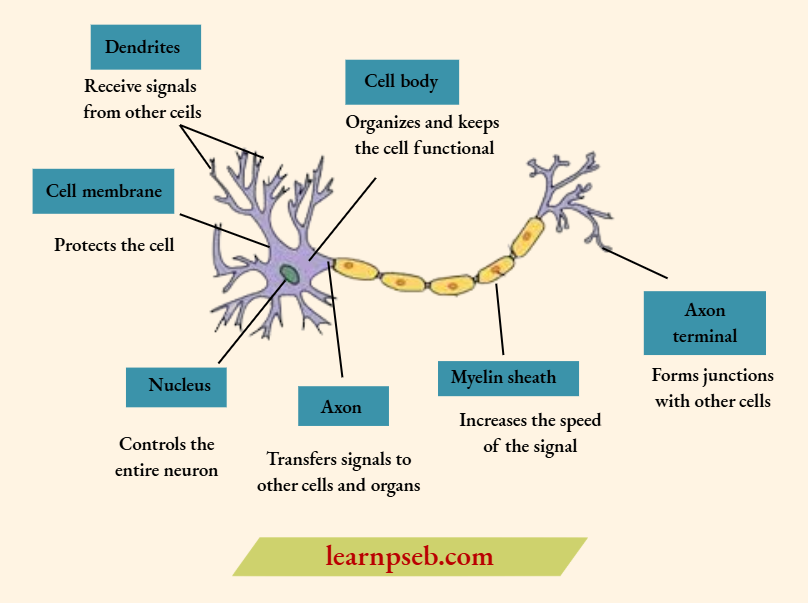
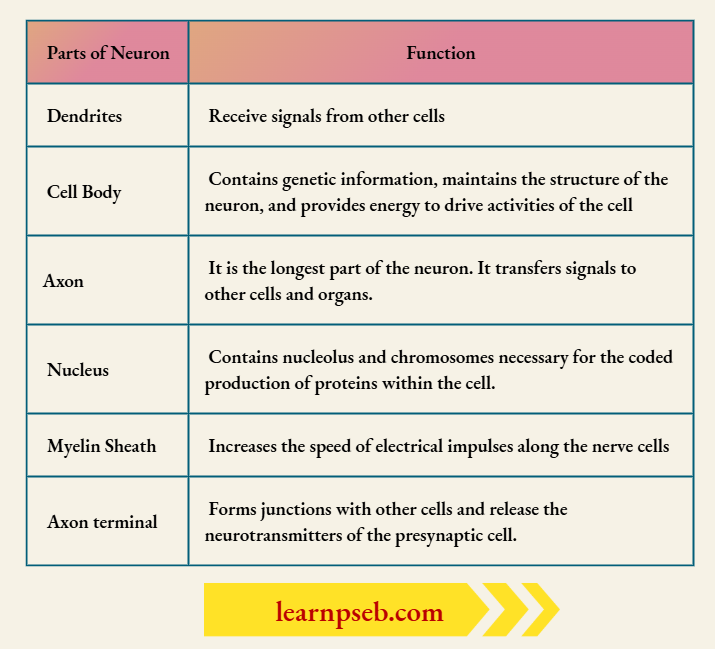
Types Of Neurons And Their Functions
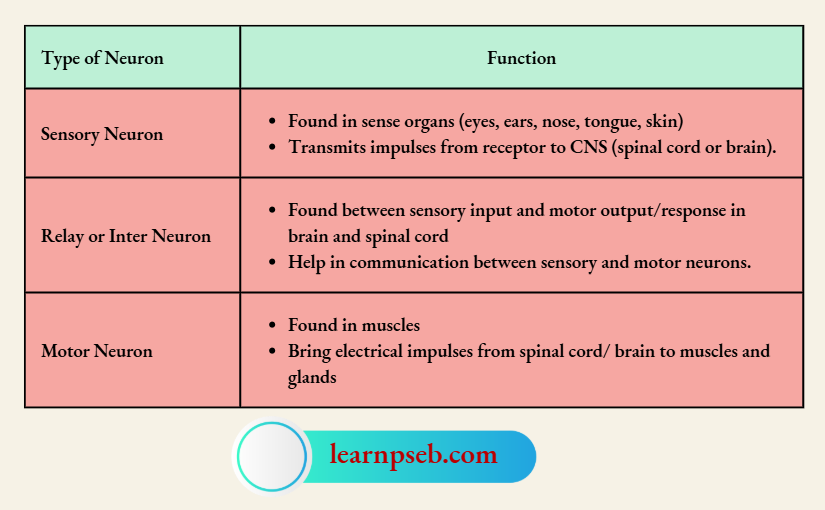
Synapse Or Neuronal Junction – It is the site of transmission of electric nerve impulses between two nerve cells (neurons) or between a neuron and a gland or muscle cell.
Pathway Of Nerve Impulse
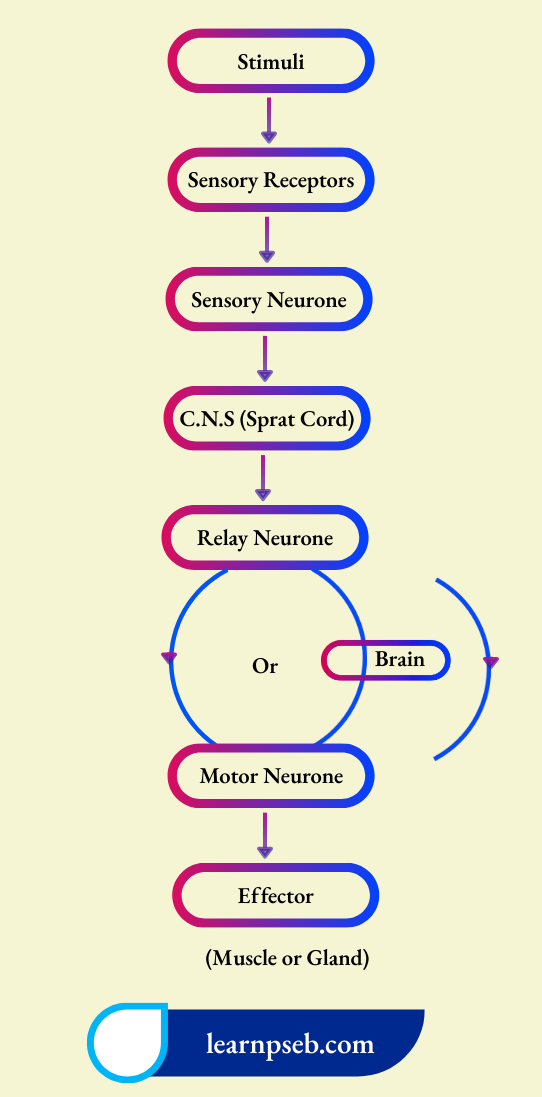
Examples of the two pathways are provided below:
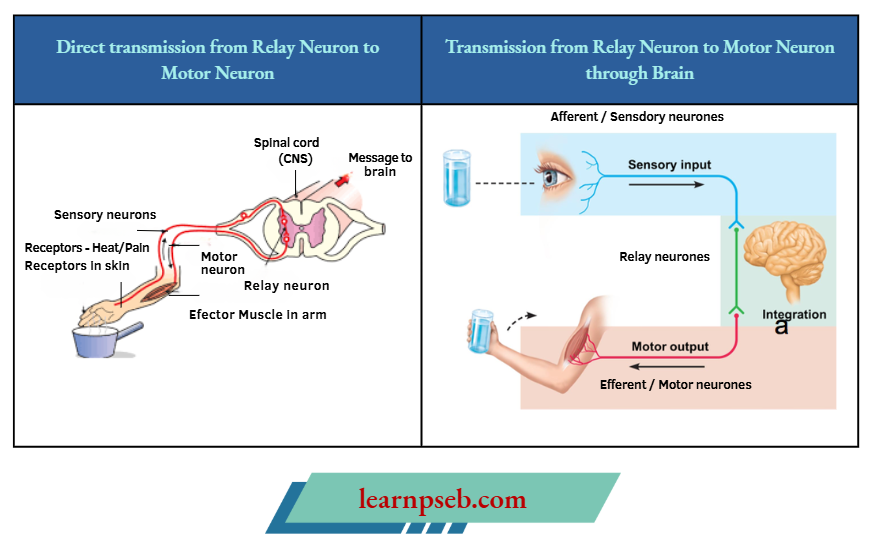
Diagram Of Synapse And Transmission Of Nerve Impulse At Synapse
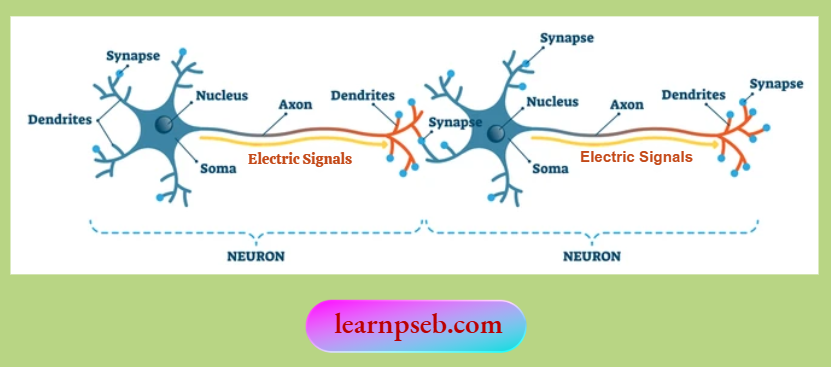
Steps involved in the transmission of nerve impulse at synapse are as follows:
- Receptors present on dendrites collect information from environment, and set off a chemical reaction that creates an electrical impulse.
- This electrical impulse travels to the cell body and then along the axon to its end.
- At the end of the axon, the electrical impulse sets off the release of some chemicals.
- These chemicals cross the gap, or synapse, and start a similar electrical impulse in a dendrite of the next neuron. In this way, nervous impulses travel in the body as shown in diagram.
- A similar synapse finally allows delivery of such impulses from neurons to muscles cells or glands at the neuromuscular junction.
Release Of Chemicals From Neuron To Muscle Cells At Neuromuscular Junction
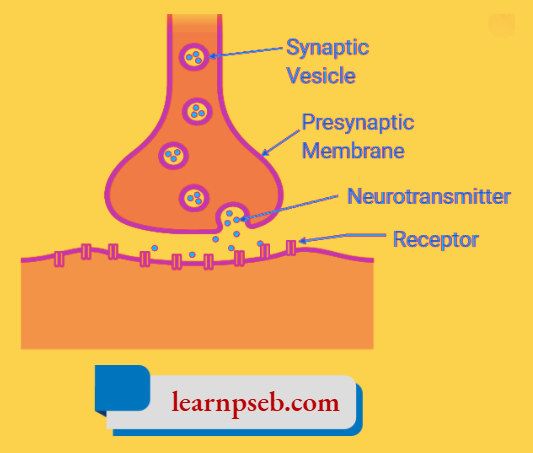
Receptors- Receptors are specialized tips of some nerve cells located in our sense organs that detect information from the environment.
Types Of Receptors, Their Location And Functions
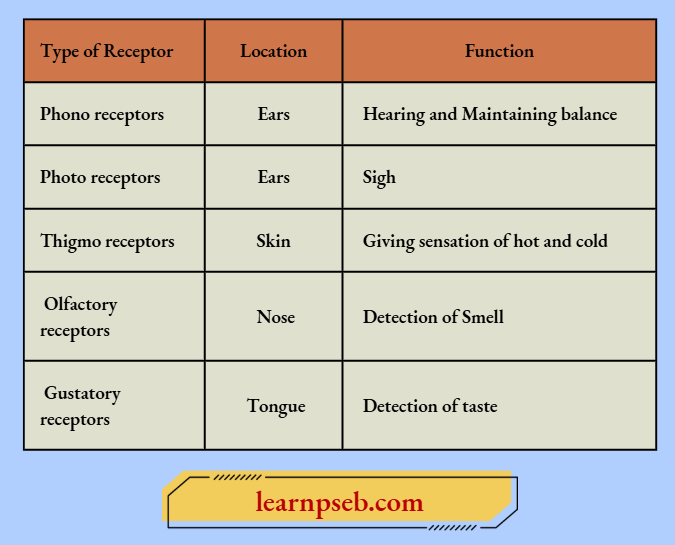
Reflex Action- A quick, sudden and immediate response of the body to a stimulus is called reflex action. Reflex actions are controlled by spinal cord and not by brain, Example
- Pulling back of hand on touching a hot object.
- Blinking of eyes when bright light is focussed on eyes is also a reflex action. This is controlled by brain. The sequence of events that occur when bright light is focussed on eyes are:
Receptor (receives message) → Sensory neuron → Brain → Motor neuron → Eye → Eye muscle contracts.
Reflex Arc- The pathway through which a nerve impulse travels during a reflex action Is called reflex arc. Nerves from all over the body meet in a bundle in the spinal cord on their way to the brain. Reflex arcs are formed in the spinal cord. Although the information is still sent to the brain, brain doesn’t have a significant response to it.
Stimulus – A stimulus is a thing or an event that evokes a specific functional reaction in an organ or tissue.
Response- The response to a stimulus can be of three main types-
- Voluntary Response- Controlled by Fore brain, e.g. running, writing, etc.
- Involuntary Response- Controlled by Mid brain and Hind brain, For Example. vomiting, heartbeat, respiration, etc.
- Reflex Action- Controlled by Spinal cord. e.g. withdrawal of hand on touching a hot object, blinking of eyes, etc.
Human Nervous System – It consists of two parts, viz. Central Nervous system (CNS) and Peripheral Nervous system (PNS).
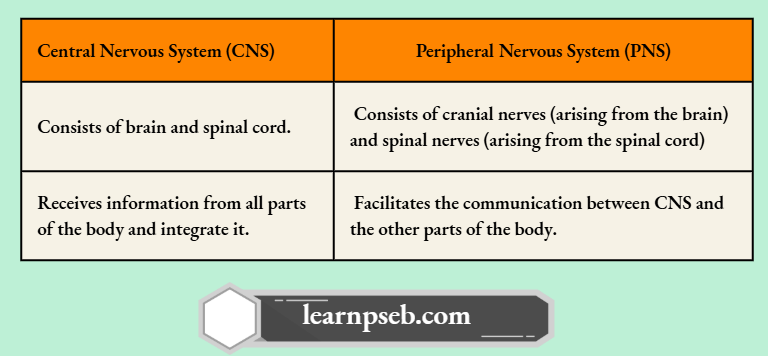
Human Brain
- Brain is the main coordinating centre of the body.
- It is contained in a bony cage (skull or cranium) which is further filled with cerebrospinal fluid for further shock absorption.
- A hard, bumpy structure at the back of the neck (vertebral column or backbone) protects the spinal cord.
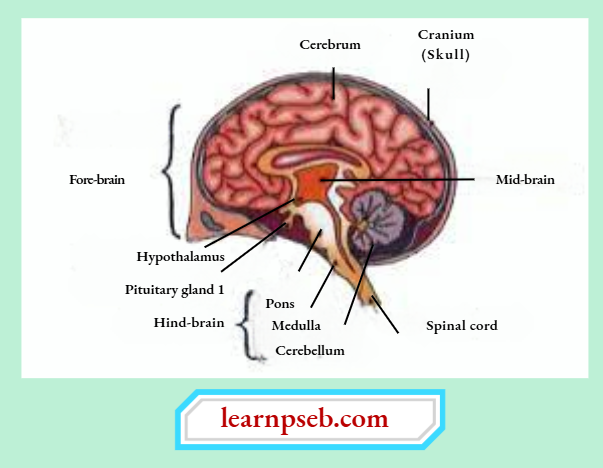
Flow Chart Of Human Nervous System And Functions Of Parts Of Brain
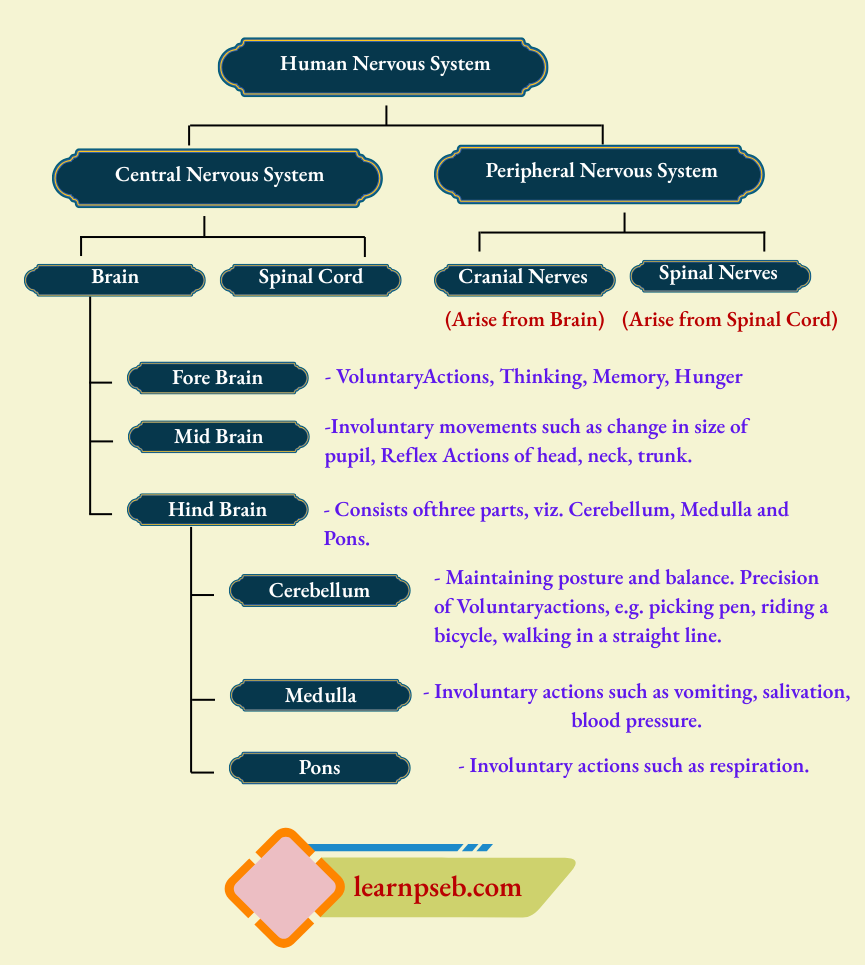
Flow Chart Of Coordination Between Nervous Tissue And Muscular Tissue
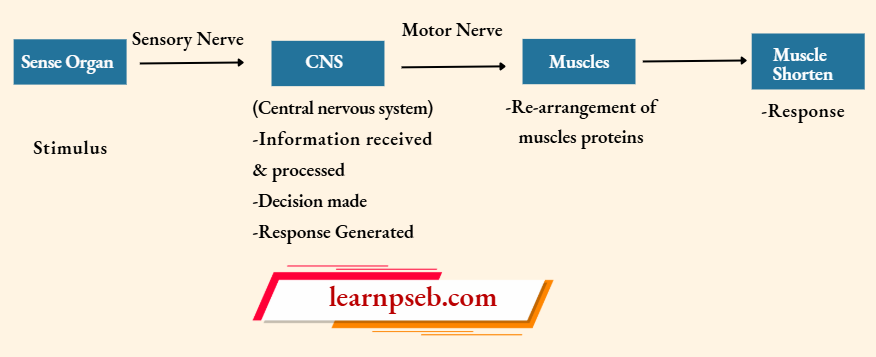
When a nerve impulse reaches the muscle, the muscle cells move by changing their shape, i.e., by shortening their length. This shortening of muscle cells occurs due to changes in chemical composition of the proteins present in the muscle cells in response to the stimulus.
Limitations Of Nervous System/ Coordination Through Electrical Impulses
- Electrical impulses will reach only those cells that are connected by nervous tissue. Since all cells in the animal body are not connected by nervous tissue, electrical impulses will not be able to reach each and every cell of the body.
- Once an electrical impulse is generated in a cell and transmitted, the cell will take some time to reset its mechanisms before it can generate and transmit a new impulse. Therefore, cells cannot continually create and transmit electrical impulses.
- Plants do not have any nervous tissue for control and coordination of their movements.
Chemical Communication In Human Beings And Plants
- In chemical communication, the cells release a chemical compound (hormone) in response to the stimulus, which diffuses all around the original cell.
- The other cells around the cells releasing the hormone have the means to detect, recognise and transmit the hormone using special molecules on their surfaces.
- In animals, chemical communication takes place through hormones secreted by various glands of the endocrine system.
- Chemical communication is a slower process.
- Advantages of chemical communication is that it can potentially reach all cells of the body, regardless of nervous connections, and it can be done steadily and persistently.
Hormones – Hormones are the chemical secretions from the endocrine glands. They are released directly into the blood. Their function is to coordinate growth and activities of the living organisms. The timings and amount of hormone released are regulated by feedback mechanisms, e.g. If the sugar levels in blood rise, it is detected by the cells of the pancreas which respond by producing more insulin. As the blood sugar level falls, insulin secretion is reduced.
Important Human Hormones And Their Functions
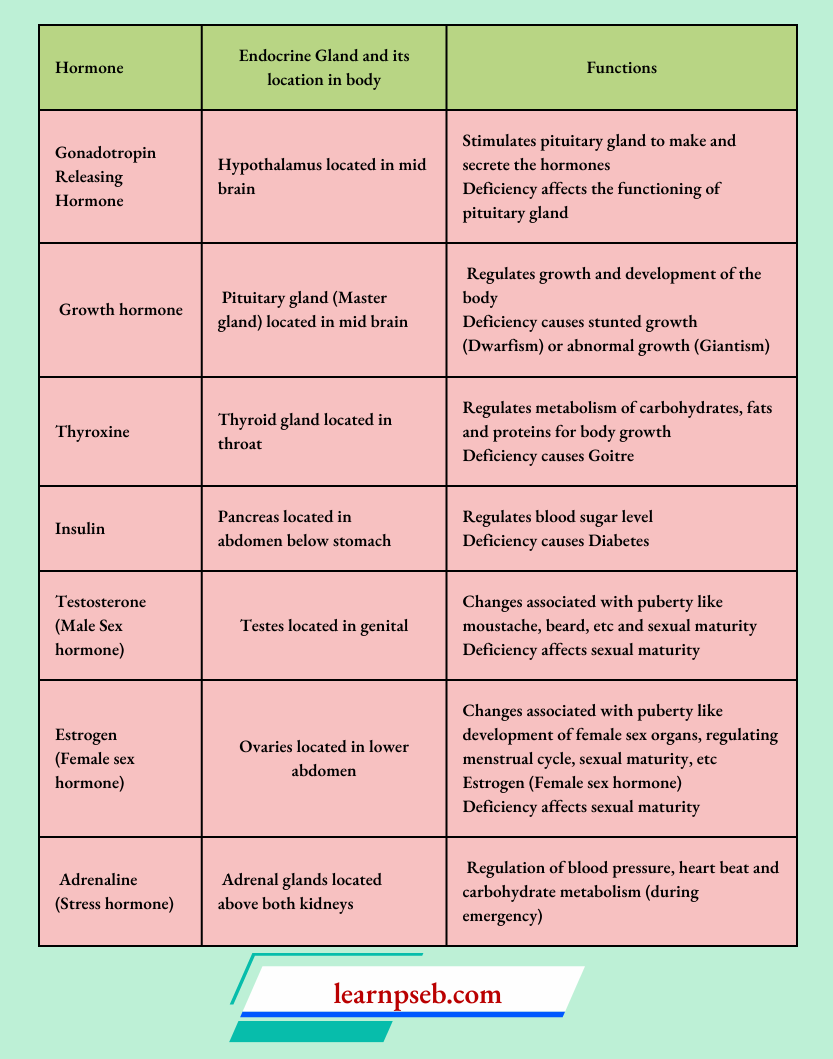
Adrenaline hormone acts on heart. In emergency situations such as fight or fear adrenaline hormone is secreted which results in faster heart beats, thus, resulting in supply of more oxygen (through blood) to our skeletal muscles. The increase in blood supply to the skeletal muscles is achieved by reducing the blood supply to the digestive system and skin by contraction of muscles around small arteries in these organs. The breathing rate also increases because of the contractions of the diaphragm and the rib muscles. All these responses together enable the animal body to be ready to deal with the emergency situation.
Flow Chart Of Human Endocrine Glands, Hormones And Their Functions
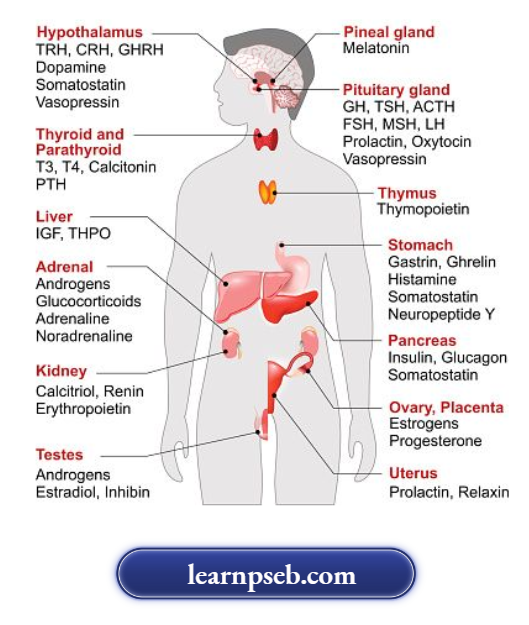
Coordination In Plants- Coordination in plants takes place through two types of movements, viz. Nastic Movements and Tropic Movements.
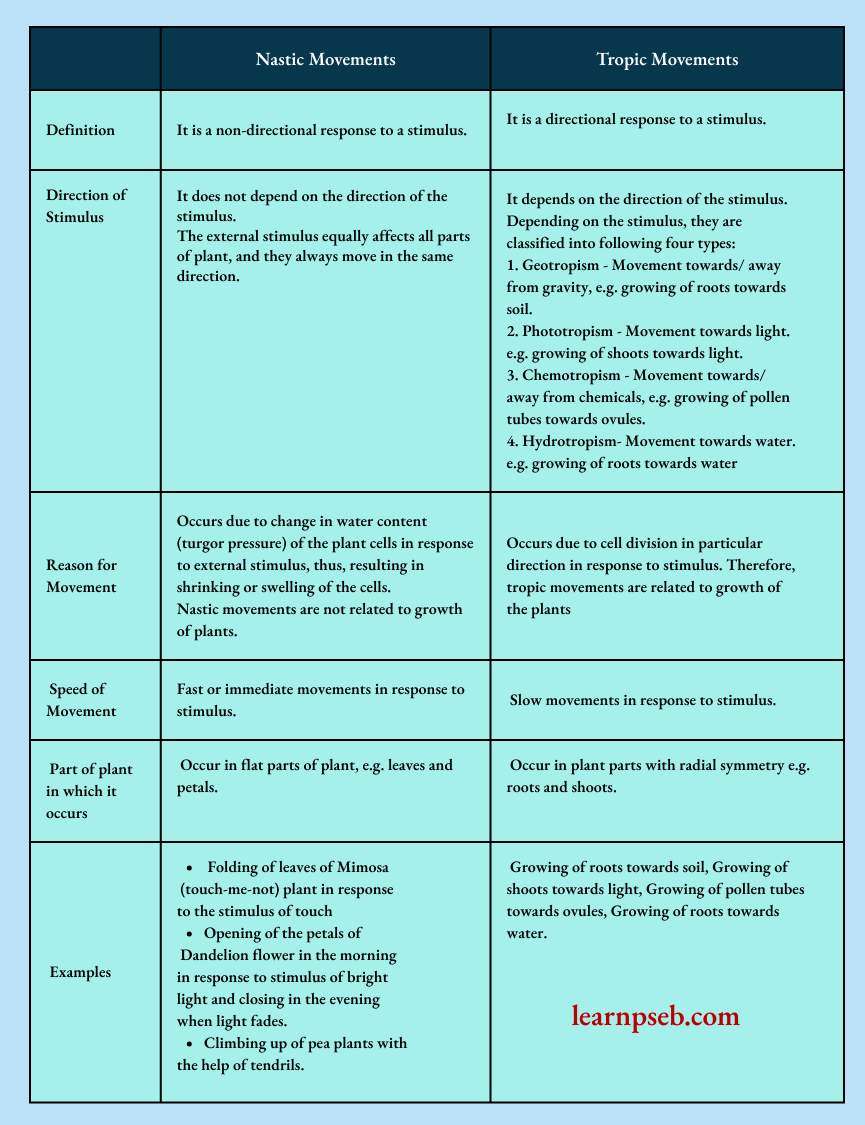
Chemical Communication In Plants- Plant Hormones
Plant Hormones Or Pheromones – These are the chemicals that help in growth, development, coordination and responses to the environmental changes in plants.
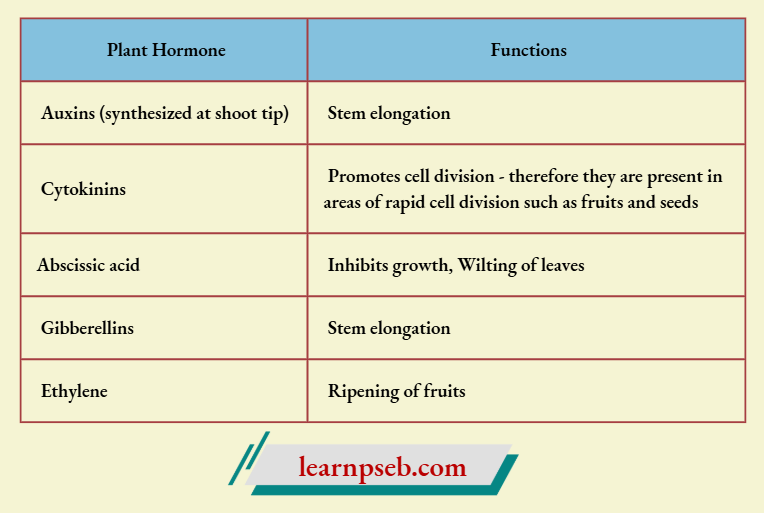
Simple Trick To Learn Plant Hormones And Their Functions
Remember the mnemonics “A CAGE” for sequence of plant hormones and “Go Come Ate Sleep Repeat” for the functions of plant hormones. Now using these two mnemonics, we can write the functions of all plant hormones as follows:
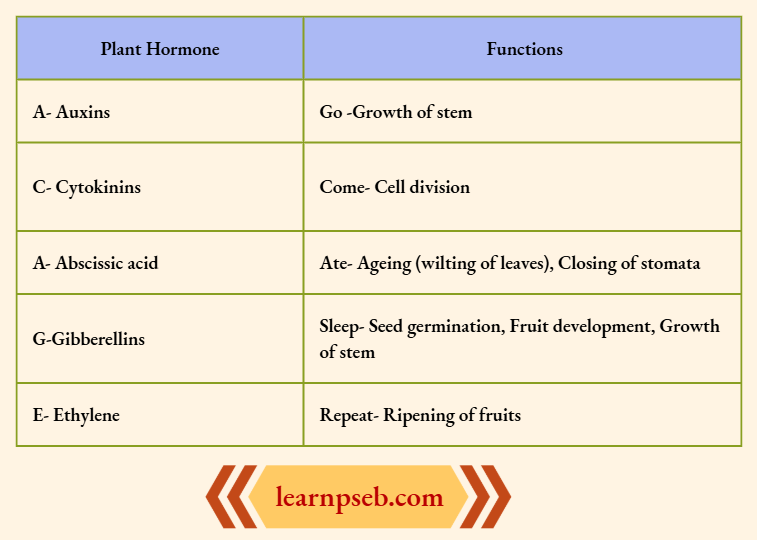
Flow Chart Of Plant Growth Promoters And Inhibitors
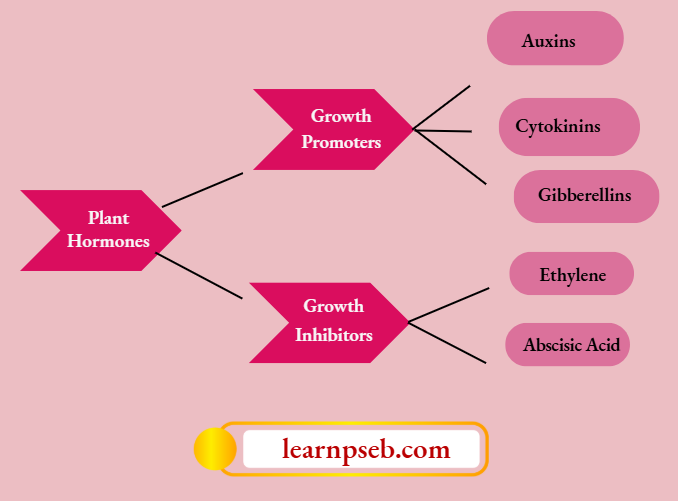
Chapter 4 Control And Coordination Case or Source Based Questions And Answers
Question 1.
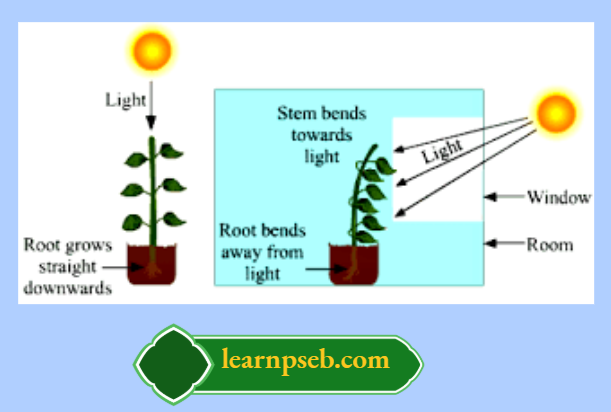
A growth movement of a plant part in response to an external stimulus in which the direction of stimulus determines the direction of response is called tropism. Thus, tropism is a directional movement of the part of a plant caused by its growth. The growth of a plant part in response to a stimulus can be towards the stimulus (in the direction of stimulus) or away from the stimulus (against the direction of stimulus) due to which we can have a positive tropism or negative tropism, respectively.
1. If the growth (or movement) of a plant part is towards the stimulus, it is called ______ tropisim.
- Positive
- Negative
Answer: 1. Positive
2. If the growth (or movement) of a plant part is away from the stimulus, then it is called ______ tropisim.
- Positive
- Negative
Answer: 2. Negative
3. The bending of the plant stem (or shoot) towards light is actually ______ phototropism.
- Positive
- Negative
Answer: 1. Positive
4. Tropism is a directional movement of the part of a plant caused by its growth.
- True
- False
Answer: 2. False
Question 2. To carry out a simple function such as eating food there has to be coordination of the eyes, hands and the mouth. The eyes have to focus on the food, the hands have to pick it up and take it to the mouth where it will be chewed. All these actions have to be coordinated in such a manner that they follow a particular sequence and the action is completed. A similar mechanism is also needed for internal functions of the body.
This function is carried out by the nervous system. It is composed of (a) Specialised cells which can detect, receive and transmit different kinds of stimuli. These are called neurons, (b) Nerve fibres which are certain bundles of extended processes of nerve cells. The individuals also have to adjust to the changing conditions around them and vary their responses. At the same time, the internal conditions of the body should be maintained constant. This is called homeostasis. The internal conditions of the body are maintained at a constant by controlling the physiology of the organisms.
1. What will the correct sequence in which conduction of information through nerves take place?
Answer: Dendrites → Cell body Axon → Nerve endings at the tip of axon → Synapse → Dendrite of next neuron
2. How homeostasis is said to maintain the equilibrium of the body?
Answer: Homeostasis helps in keeping the constant internal environment within a cell or a body and hence maintains the equilibrium of the body
3. What function does the central nervous system perform?
Answer: The central nervous system is comprised of the brain and the spinal cord which process the information received from the receptors on/in the body.
4. What happens when the dendrite tip of a nerve cell receives a signal?
Answer: Upon receiving a signal, the dendrite tip of a nerve cell sets off a chemical reaction which creates an electrical impulse in the them.
Question 3. The neural system of all animals is composed of highly specialised cells called neurons which can detect, receive and transmit different kinds of stimuli. The neural organisation is very simple in lower invertebrates. For example, in Hydra it is composed of a network of neurons. The neural system is better organised in insects, where a brain is present along with a number of ganglia and neural tissues. The vertebrates have a more developed neural system.
The human neural system is divided into two parts
- The central neural system (CNS)
- The peripheral neural system (PNS)
The CNS includes the brain and the spinal cord and is the site of information processing and control. The PNS comprises of all the nerves of the body associated with the CNS (brain and spinal cord). The nerve fibres of the PNS are of two types: Afferent fibres and Efferent fibres.
The afferent nerve fibres transmit impulses from tissues/organs to the CNS and the efferent fibres transmit regulatory impulses from the CNS to the concerned peripheral tissues/organs. The PNS is divided into two divisions called somatic neural system and autonomic neural system.
The somatic neural system relays impulses from the CNS to skeletal muscles while the autonomic neural system transmits impulses from the CNS to the involuntary organs and smooth muscles of the body. The autonomic neural system is further classified into sympathetic neural system and parasympathetic neural system. Visceral nervous system is the part of the peripheral nervous system that comprises the whole complex of nerves, fibres, ganglia, and plexuses by which impulses travel from the central nervous system to the viscera and from the viscera to the central nervous system.
1. The afferent nerve fibres transmit impulses from __________
- Tissues to the CNS
- Organs to the CNS
- CNS to tissues
- Both a and b
Answer: 4. Both a and b
2. The efferent nerve fibres transmit impulses from __________
- Tissues to the CNS
- Organs to the CNS
- CNS to tissues
- Organ to organ
Answer: 3. CNS to tissues
3. How many types of nerve fibres do PNS have? Name them.
Answer: The nerve fibres of the PNS are of two types: Afferent fibres and Efferent fibres
4. Give the divisions of peripheral nervous system and their function?
Answer: The PNS is divided into two major divisions called somatic neural system and autonomic neural system. The somatic neural system relays impulses from CNS to the skeletal muscles while ANS transmits impulses from CNS to the smooth muscles.
5. How impulses travel from the central nervous system to the viscera and from the viscera to the central nervous system?
Answer: Visceral nervous system is the part of the peripheral nervous system that comprises the whole complex of nerves, fibres, ganglia, and plexuses by which impulses travel from the central nervous systemtet/?ewsceraandfromMe viscera to the centrafnervous system.
Question 4.
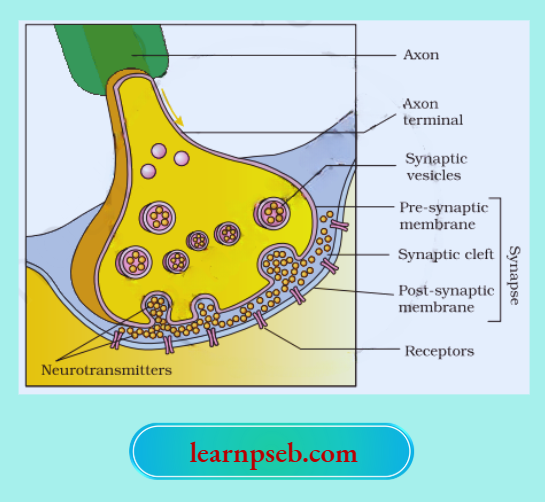
A nerve impulse is transmitted from one neuron to another through junctions called synapses. A synapse is formed by the membranes of a pre-synaptic neuron and a post-synaptic neuron, which may or may not be separated by a gap called synaptic cleft. There are two types of synapses, namely, electrical synapses and chemical synapses. At electrical synapses, the membranes of pre- and post-synaptic neurons are in very close proximity. Electrical current can flow directly from one neuron into the other across these synapses. Transmission of an impulse across electrical synapses is very similar to impulse conduction along a single axon. Impulse transmission across an electrical synapse is always faster than that across a chemical synapse. Electrical synapses are rare in our system.
At a chemical synapse, the membranes of the pre- and post-synaptic neurons are separated by a fluidfilled space called synaptic cleft. Chemicals called neurotransmitters are involved in the transmission of impulses at these synapses. The axon terminals contain vesicles filled with these neurotransmitters. When an impulse (action potential) arrives at the axon terminal, it stimulates the movement of the synaptic vesicles towards the membrane where they fuse with the plasma membrane and release their neurotransmitters in the synaptic cleft. The released neurotransmitters bind to their specific receptors, present on the post-synaptic membrane. This binding opens ion channels allowing the entry of ions which can generate a new potential in the post-synaptic neuron. The new potential developed may be either excitatory or inhibitory.
1. Impulse transmission across an electrical synapse is always
- Slower than
- Faster than
- Greater than
- Leaser than
Answer: 2. Faster than
2. Identify the incorrect statement
Statement 1- Impulse transmission across an electrical synapse is always slower.
Statement 2- A nerve impulse is transmitted from one neuron to another through junctions.
Statement 3- Electrical synapses are common in our system.
Statement 4- Chemical synaptic neurons are separated by synaptic cleft.
- Only 1
- Both 2 & 3
- Only 3
- None of the above
Answer: 1. Only 1
3. Give the name of components by which synapses is formed?
Answer: Synapse is formed of the membranes of a pre-synaptic neuron and a post-synaptic neuron, this membrane may or may not be separated by a gap called synaptic cleft,
4. Explain how neurotransmitters are released in synaptic cleft?
Answer: When an impulse comes at the axon terminal, it stimulates the movement of the synaptic vesicles towards the membrane where they fuse with the plasma membrane and release their neurotransmitters in the synaptic cleft.
5. How action potential is responsible for the formation of new potential?
Answer: When an action potential arises at the axon terminal, it stimulates the movement of the synaptic vesicles towards the membrane and release their neurotransmitters in the synaptic cleft. The released neurotransmitters bind to their specific receptors, present on the post-synaptic membrane. This binding opens ion channels allowing the entry of ions which can generate a new potential in the post-synaptic neuron. The new potential developed may be either excitatory or inhibitory.
PSEB Class 10 Biology Solutions For Chapter 2 How Do Organisms Reproduce?
PSEB Class 10 Biology Solutions For Chapter 2: How Do Organisms Reproduce?
Reproduction
The process by which living organisms produce new individuals similar to themselves is called reproduction. It can occur in two ways – Asexual and Sexual.
Difference Between Asexual And Sexual Reproduction
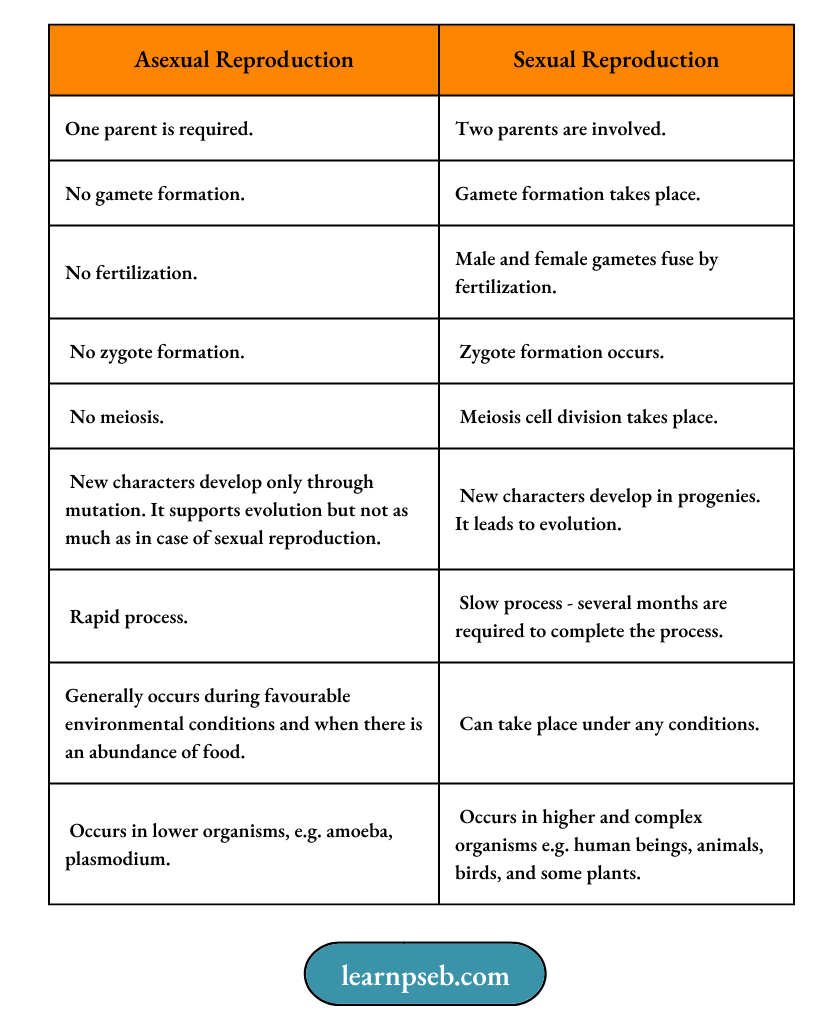
Note:
- Both kind of reproduction, i.e., asexual and sexual, can take place both in unicellular and multicellular organisms.
- Irrespective of the type by which an organism reproduces, the first step in reproduction always involves division of nucleus. This is followed by division of cytoplasm.
Life processes class 10 notes
Advantages Of Sexual Reproduction
- Variations In Characters- Since sexual mode of reproduction allows more variation, and variations ensure survival of species in changing environments, sexual mode of reproduction is beneficial and desirable.
- Ability To Adapt In Changing Environments – More variations means greater ability to adapt in changing environments, which in turn is beneficial for survival.
- Evolution of New Traits – Variations in genetic material (characters) arise due to errors in DNA copying mechanism. In this way, each new variation is made in a DNA copy that already has variations accumulated from previous generations. Combining variations from two or more individuals leads to creation of new combinations leading to evolution of species.
- Suppression of Harmful Traits – During DNA copying, the harmful traits often remain naturally suppressed due to reshuffling of gene pairs that occur during formation and fusion of gametes.
PSEB Class 10 Biology Solutions Chapter 2
Read And Learn More PSEB Class 10 Biology
Limitations Of Sexual Reproduction
- It takes time and energy to find a mate and reproduce.
- Reproduction through sexual means is uncertain as some mates may be infertile or fertilization of gametes may not occur despite numerous attempts.
- Favourable genetics might not be passed to the offspring.
- Fewer offspring are typically produced.
Asexual Reproduction In Unicellular Organisms
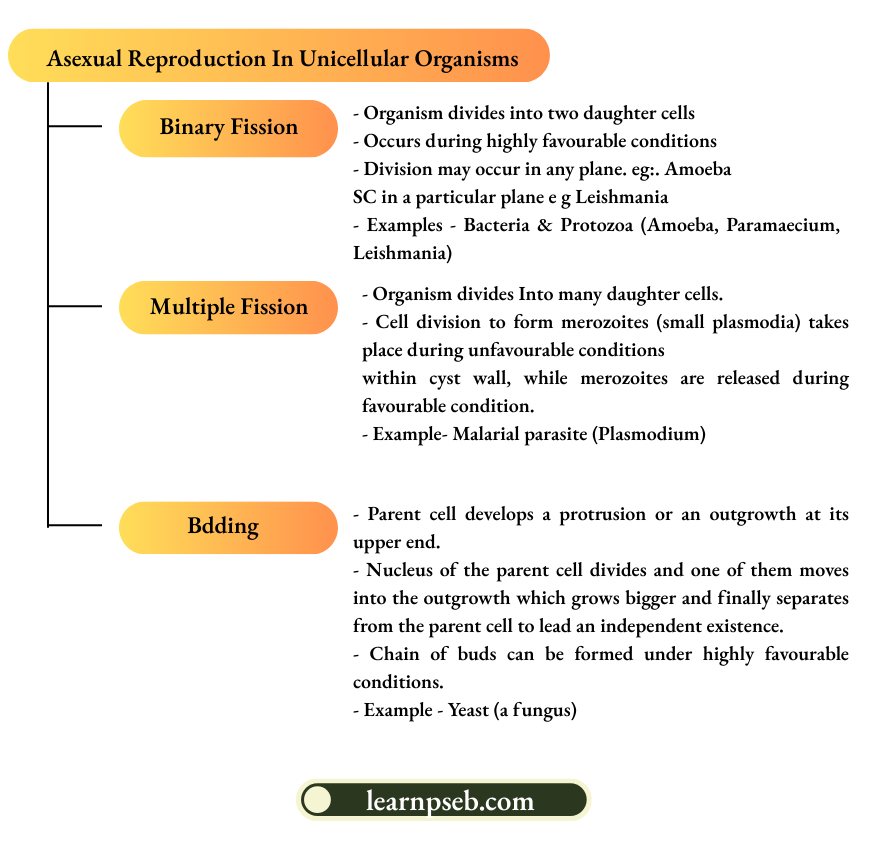
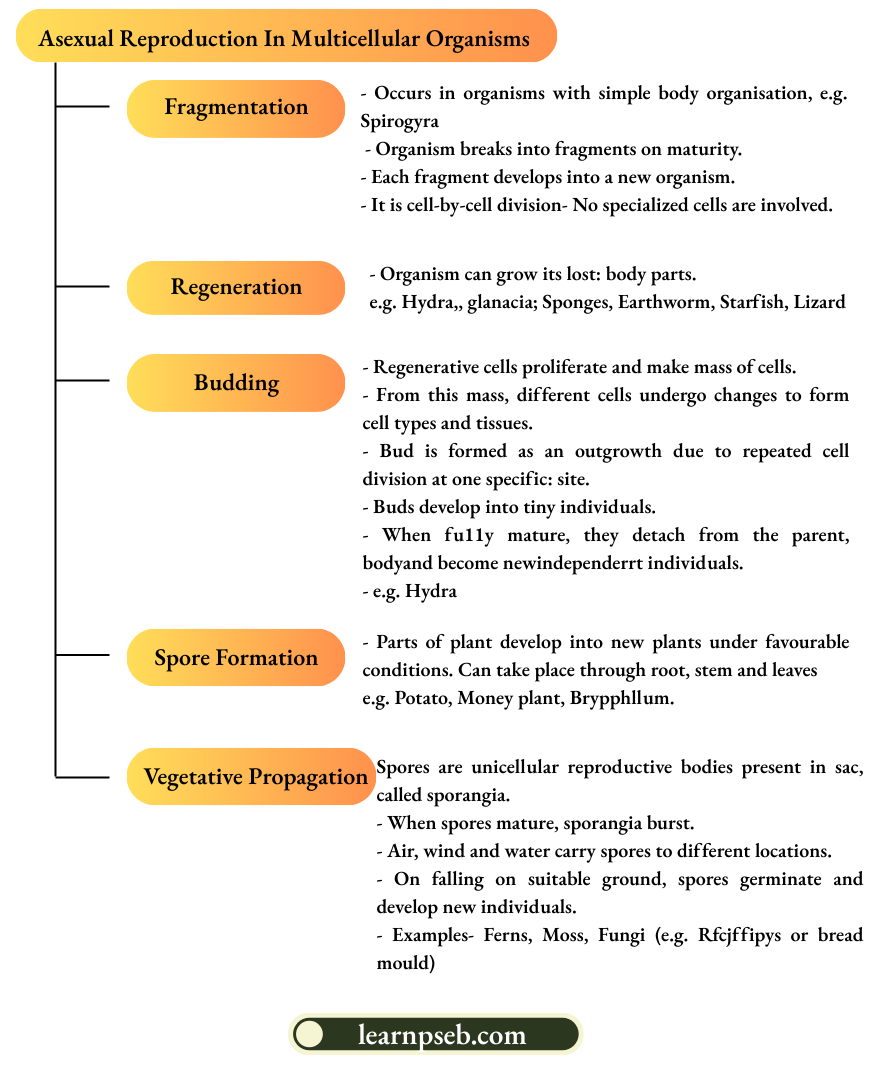
Advantages Of Vegetative Propagation
- Vegetative propagation is used to grow many plants like sugarcane, roses, or grapes for agricultural purposes.
- Plants raised by vegetative propagation can bear flowers and fruits earlier than those produced from seeds.
- Vegetative propagation is useful for propagation of plants such as banana, orange, rose and jasmine that have lost the capacity to produce seeds.
- All plants produced by vegetative propagation are genetically similar to the parent plant and have all its characteristics.
Life processes class 10 PSEB solutions
Maintenance Of Number Of Chromosomes In Sexual Reproduction
Maintenance of number of chromosomes in sexual reproduction occurs with the help of meiosis. Meiosis is a process where a single cell divides twice to produce four cells containing half the original amount of genetic information.
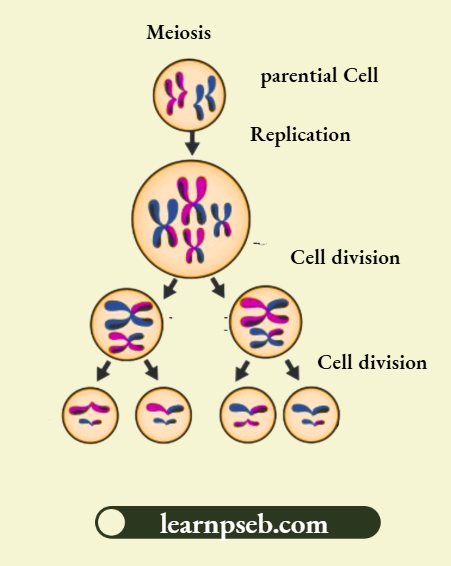
- Sexually reproducing organisms have two kinds of cells, viz. somatic cells (or non-reproductive cells) and reproductive cells.
- Somatic cells have 22 pairs of chromosomes – one member of each pair comes from father and the other comes from mother, i.e., somatic cells are diploid in nature.
- Reproductive cells (called gametes) have only half the number of chromosomes and half the amount of DNA as compared to somatic cells, i.e., reproductive cell is haploid in nature.
- Reduction in number of chromosomes in reproductive cells is achieved by meiosis.
- Two different reproductive cells (one male and the other female) unite together (n+n) to form a zygote (2n). In humans, each gamete (egg and sperm) contains 23 chromosomes, and the zygote formed by their union has 23+23 = 46 chromosomes, thereby resulting in re-establishment of the number of chromosomes and the DNA content in the new generation.
Life processes class 10 PSEB solutions
Parts Of A Flower And Their Functions
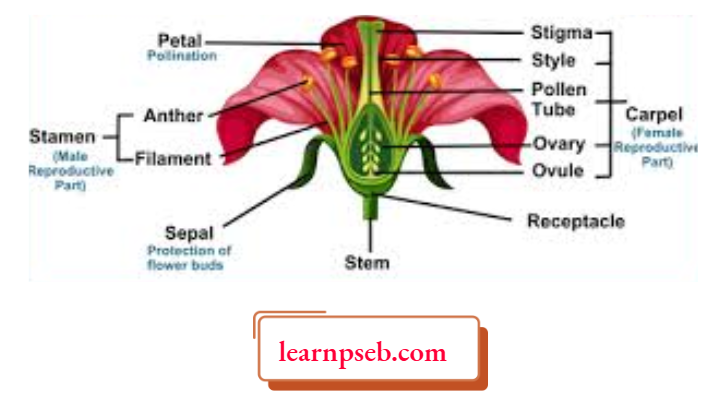
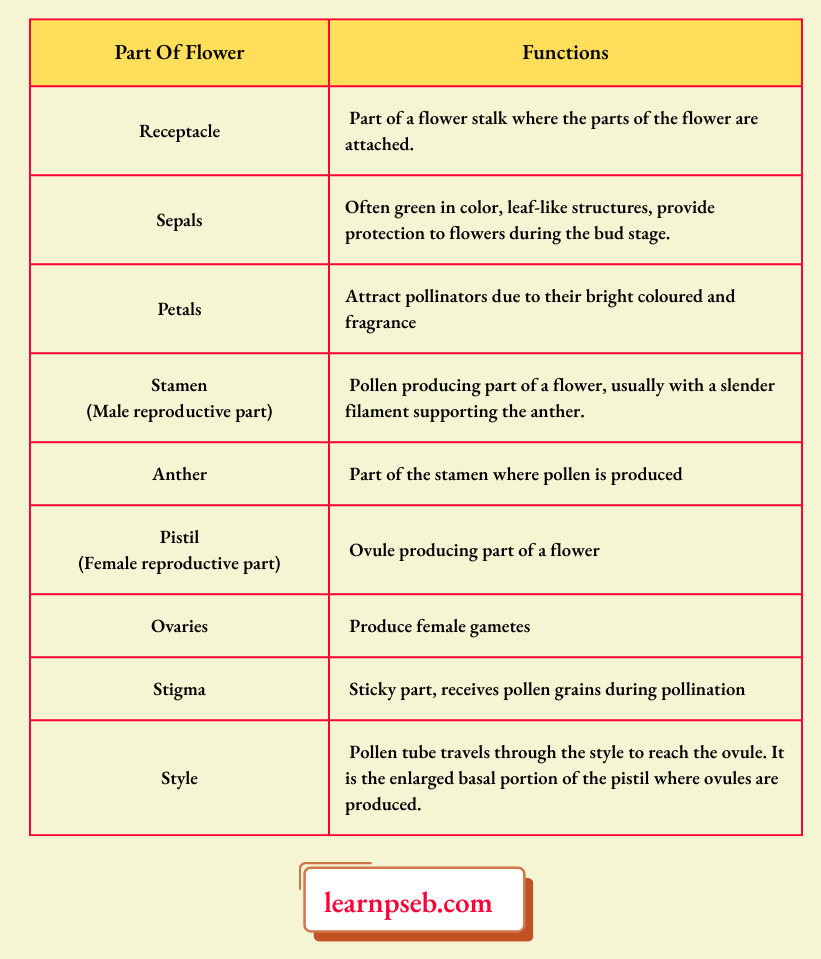
How Do Organisms Reproduce PSEB Class 10 Notes
Steps Involved In Reproduction In Flowering Plants (Angiosperms)
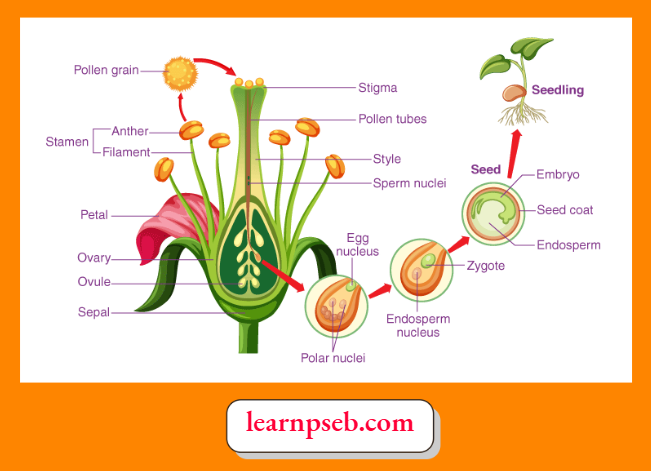
- Reproduction in flowering plants begins with pollination, the transfer of pollen from anther to stigma of the flower.
- If the transfer takes place to the stigma of flower of the same plant, it is called self-pollination.
- If the transfer takes place to the stigma of flower of another plant, it is called cross-pollination.
- Once the pollen grain reaches the stigma, a pollen tube grows from the pollen grain to an ovule.
- Two sperm nuclei develop. One of them unites with the egg nucleus and produces a zygote. The other unites with two polar nuclei to produce an endosperm that stores food for the development of a plant.
- Zygote develops into seed and seedling.
Life processes class 10 PSEB solutions
Male And Female Reproductive Organs Of Flowering Plants (Angiosperms)
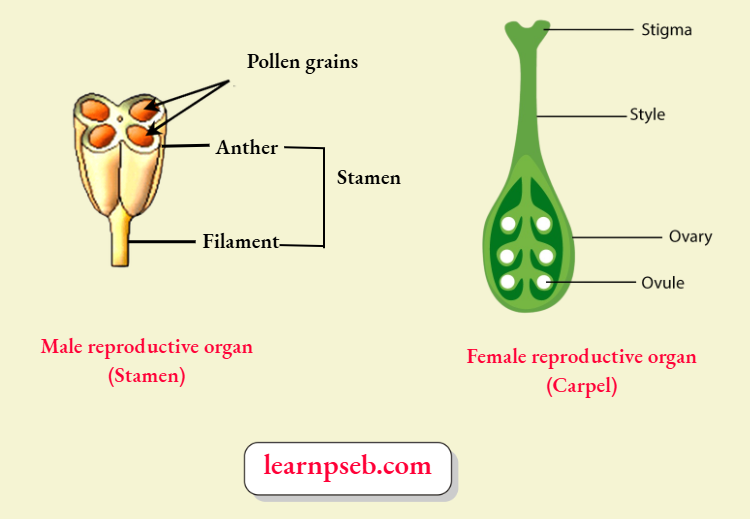
Five Stages In Germination Of Seed
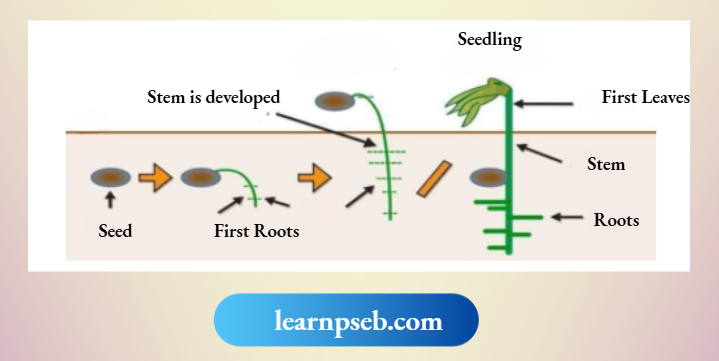
- Water fills the seed. This is called Imbibition.
- Water activates the enzymes that begin the growth of the plant.
- Seed grows a root to access water underground.
- Seed grows shoots that grow towards the sun.
- Shoots grow leaves, etc.
Life processes class 10 extra questions
Difference Between Self-Pollination And Cross-Pollination
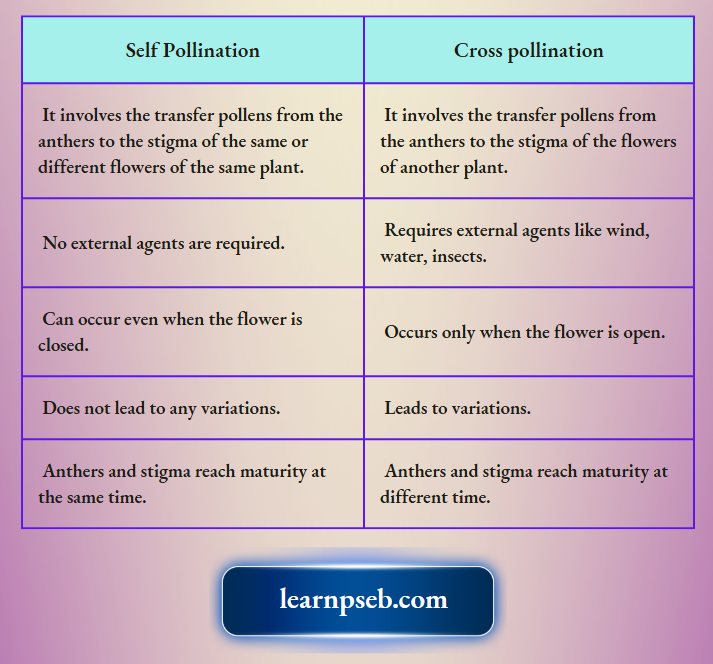
Difference Between Radicle And Plumule
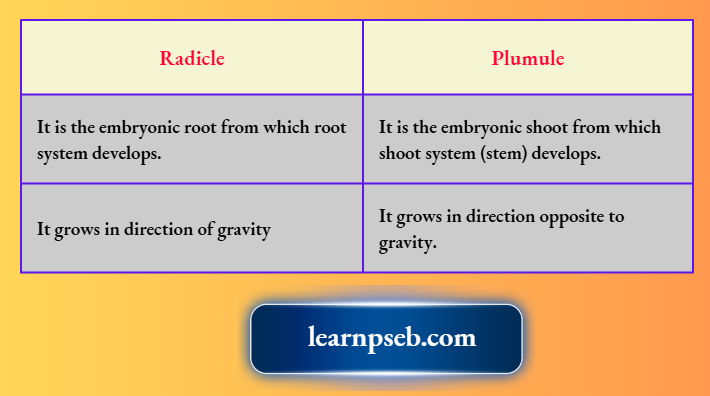
Points To Remember About Sexual Reproduction In Human Beings
- Human beings become reproductively active from the onset of puberty.
- Puberty is the period during adolescence when the rate of general body firowth begins to slow down and reproductive tissues begin to mature. A boy or girl becomes sexually mature in puberty.
- Puberty is a slow process spread over months and years. This is because while the body of the individual organism is growing to its adult size, the resources of the body are mainly directed at achieving this growth. While that is happening, the maturation of the reproductive tissue is not likely to be a major priority.
- Onset of puberty in males occurs between 11 to 13 years of age, while in females it occurs between 10 to 12 years of age.
- Puberty is associated with many physical, mental, emotional and psychological changes.
PSEB Class 10 Biology Important Questions Chapter 2
Life processes class 10 MCQ with answers
The physical changes that occur during puberty are called secondary sexual characters.
- Secondary sexual characters common to both boys and girls – Growing of thick dark hair in arm pits and genital area; appearance of thinner hair on legs, arms and face; skin becomes oily and appearance of pimples on face.
- Secondary sexual characters that occur only in boys – Appearance of beard and moustache, voice begins to crack, reproductive organs develop and start producing releasing sperms, penis occasionally begins to become enlarged and erect.
- Secondary sexual characters that occur only in girls – Increase in breast size, darkening of the skin of nipples, and start of menstruation.
Life processes class 10 MCQ with answers
Parts Of The Male Reproductive System And Their Functions
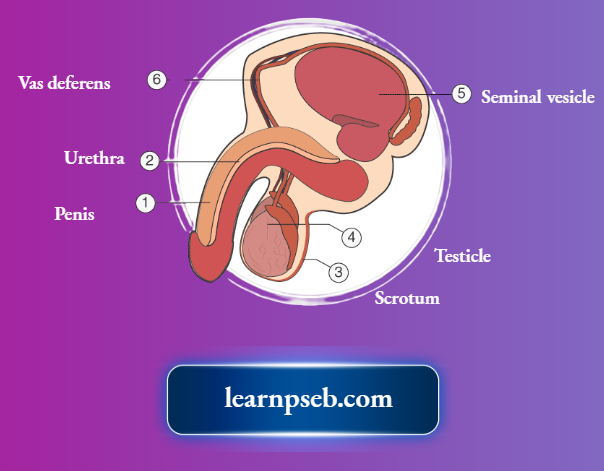
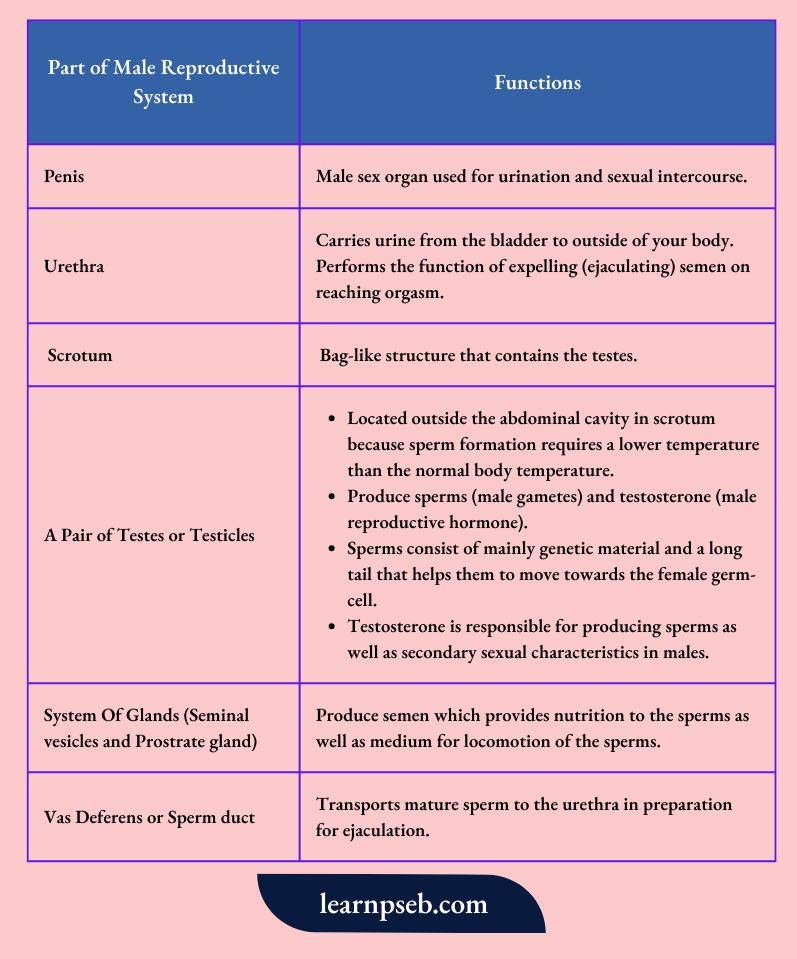
Parts Of The Female Reproductive System And Their Functions
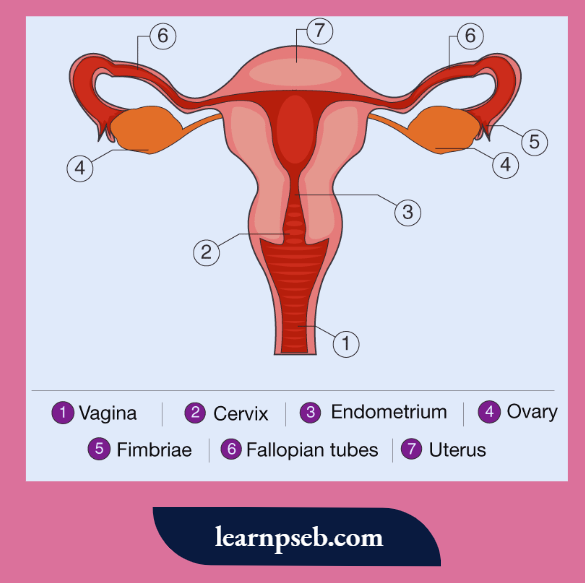
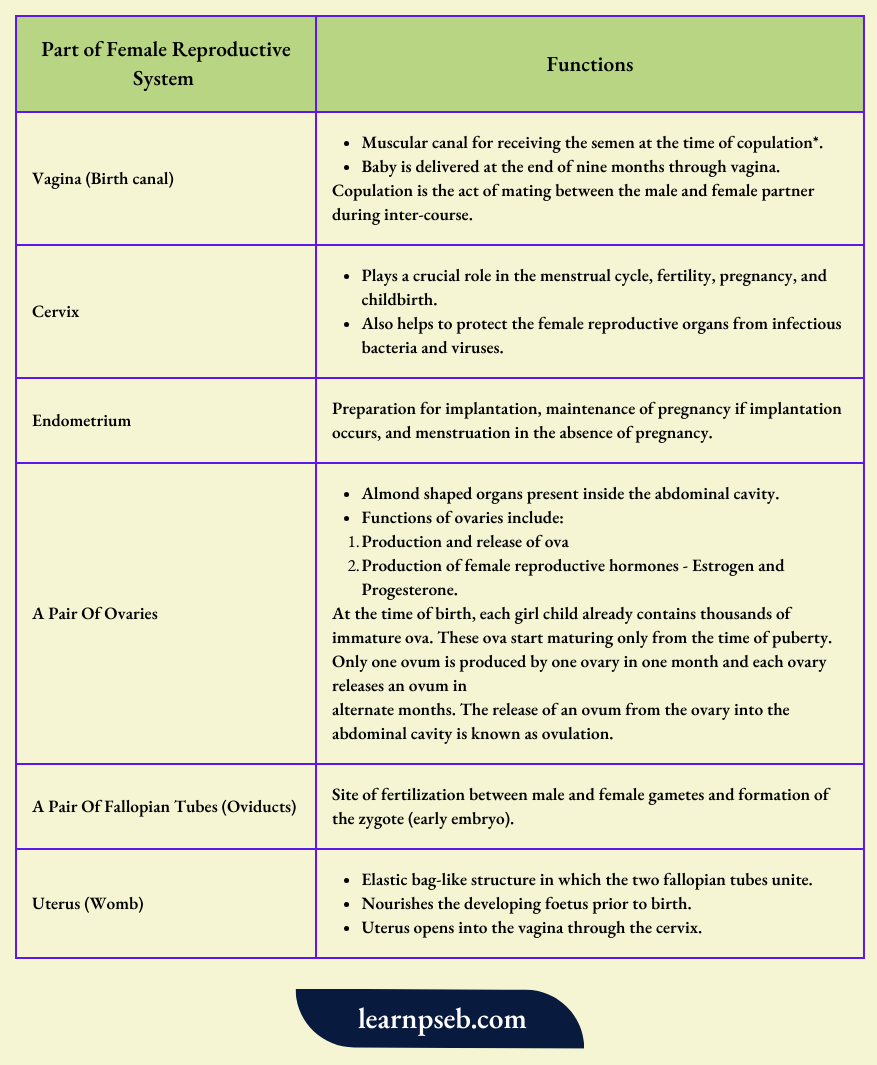
Steps Involved In Reproduction In Human Beings
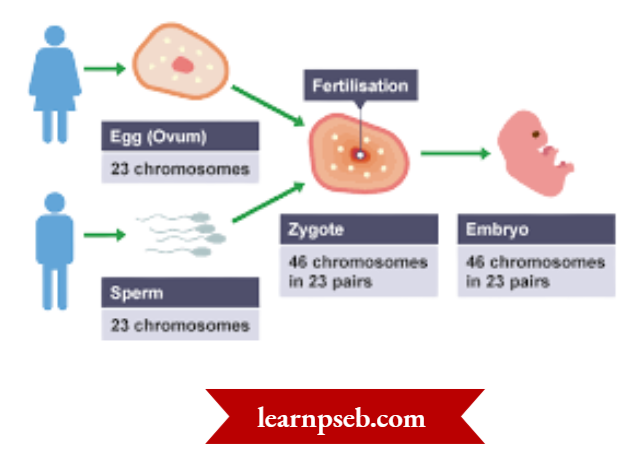
- In Males, testes produce male gametes (sperms).
- In Females, ovaries produce female gametes (ova).
- During sexual intercourse, sperms enter the vaginal passage and travel upwards to reach the oviduct. Here, they may encounter the egg, and fertilization may occur. Fertilisation occurs in the fallopian tube. Fertilization is the process of fusion of nuclei of the sperm and egg.
- After fertilization, zygote is formed. A fertilized egg is called a zygote.
- The zygote starts dividing and form a ball of cells and tissues called embryo.
- The embryo is implanted in the inner lining of the uterus (called endometrium; Endometrium is richly supplied with blood vessels and provides nutrients for the growing embryo) where the embryo continues to grow and develop organs to become foetus (When all body parts of the embryo can be fully identified, it called foetus).
- The embryo gets nutrition from the mother’s blood with the help of a special tissue called placenta. Placenta is a disc which is embedded in the uterine wall. It contains villi on the embryo’s side of the tissue. On the mother’s side are blood spaces, which surround the villi. This provides a large surface area for glucose and oxygen to pass from the mother to the embryo.
- Functions of Placenta include:
- Providing nutrition to the growing embryo from the mother’s blood.
- Removal of waste substances by transferring them into the mother’s blood.
- Functions of Placenta include:
- The development of the child inside the mother’s body takes approximately nine months.
- The child is born as a result of rhythmic contractions of the muscles in the uterus.
Life processes definition and examples
Difference Between Zygote, Embryo And Fetus
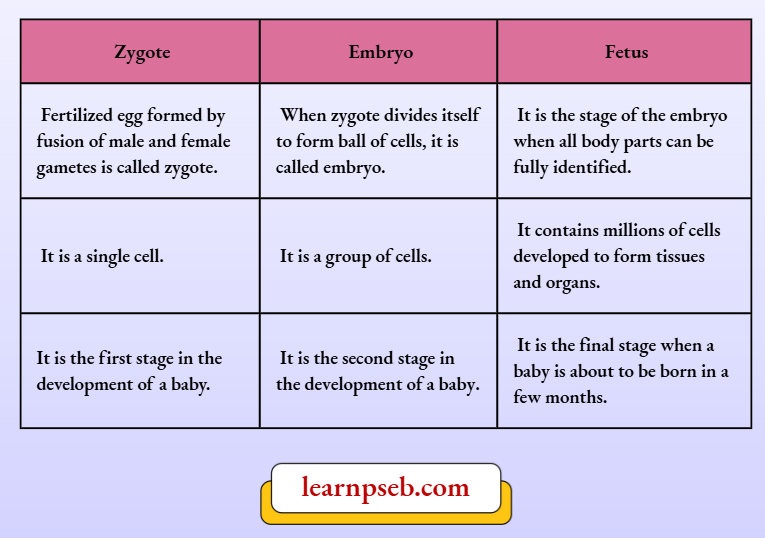
Menstruation
It is the monthly process of shedding of the lining of a woman’s uterus as blood and mucus along with the unfertilized ovum and the ruptured cells and tissues of the endometrium through the vagina of the female. Menstruation occurs if fertilization of egg does not occur. It is a 28-dav cycle which occurs in every reproductively active female (from puberty). The flow of blood continues for 2 to 8 days.
PSEB life processes class 10 questions answer
Difference Between Menarche And Menopause
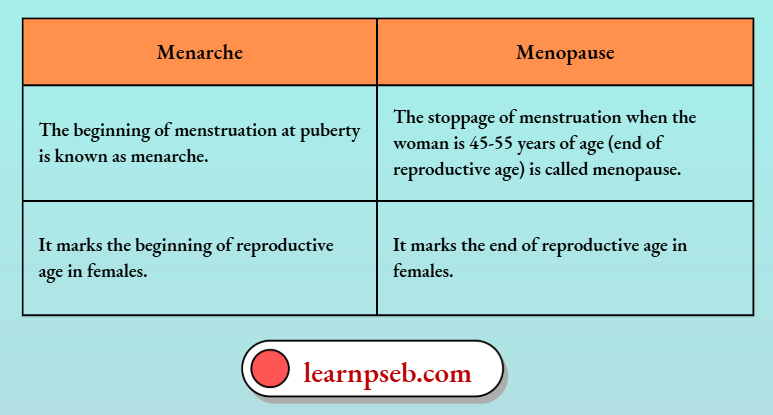
Comparison Between Sexual Reproductive System Of Plants And Animals
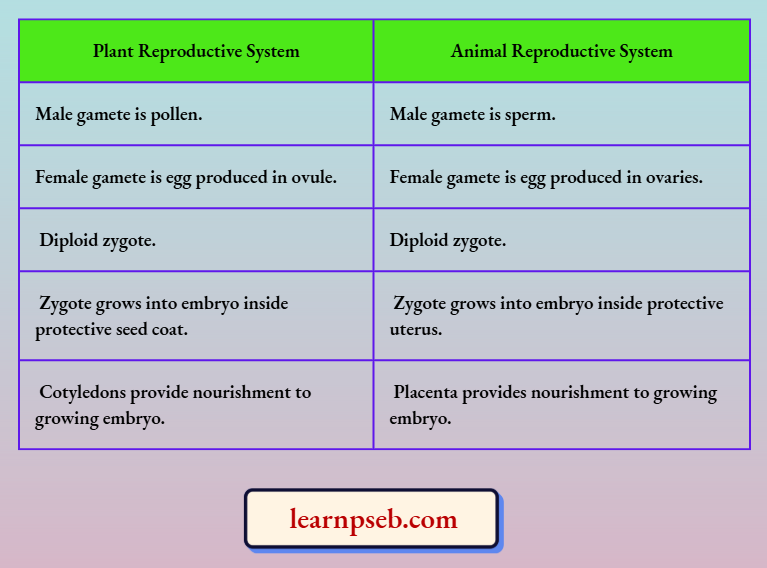
Reproductive Health
Reproductive health refers to a state of complete physical, mental and social well-being of males and females during their entire reproductive age. The physical well-being refers to healthy reproductive organs and healthy hormone producing glands.
Reproductive health is important because it protects both the mother and the child from infectious diseases. It also ensures delivery of a healthy baby.
Four pillars of reproductive health are:
- Responsible Parenthood
- Respect for Life
- Birth Spacing
- Informed Choice – Informed choice means giving options to a person to choose from several diagnostic tests or treatments, knowing the details, benefits, risks and expected outcome of each.
PSEB life processes class 10 questions answer
Sexually Transmitted Diseases (STDs) – Sexually transmitted diseases can be bacterial or viral.
Bacterial STDs – Gonorrhoea and Syphilis.
Viral STDs – Warts and HIV-AIDS.
Birth Control Measures – Birth control measures means methods to prevent pregnancy. Birth control measures are important for facilitating family planning/spacing of births, reducing unintended pregnancies and abortions. They provide both health and social benefits to mothers and their children.
PSEB Class 10 Science Chapter 2 Solutions
Types Of Birth Control Measures
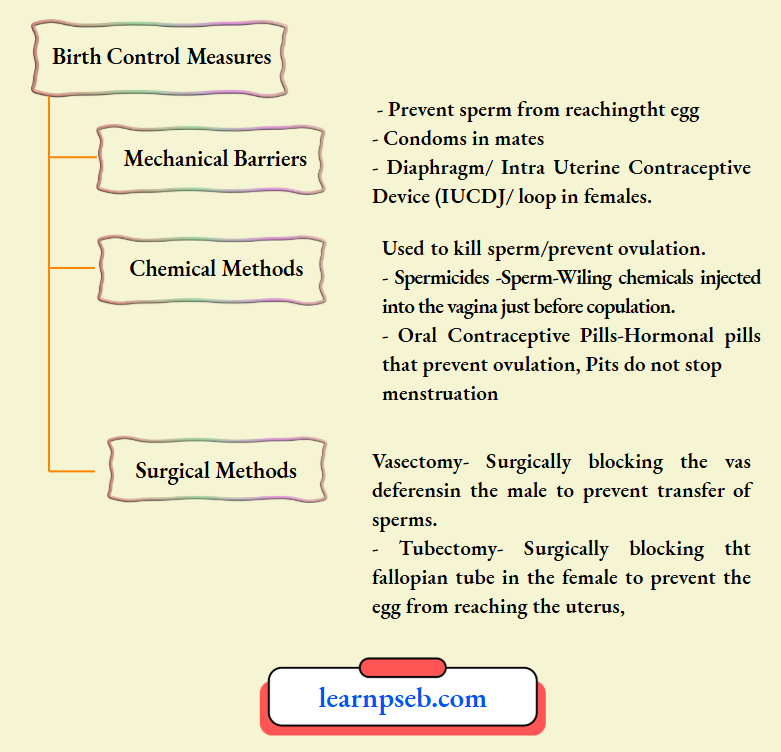
Chapter 2 How Do Organisms Reproduce Reason- Assertion Questions And Answers
For question provided below, two statements are given—one labelled Assertion (A) and the other labelled Reason (R). Select the correct answer to these questions from the codes (a), (b), (c) and (d) as given below:
- Both A and R are true, and R is the correct explanation of the assertion.
- Both A and R are true, but R is not the correct explanation of the assertion.
- A is true, but R is false.
- A is false, but R is true.
Question 1. Assertion: Sexual reproduction generates recombination.
Reason: Sexual reproduction involves crossing over.
Answer: 1. Both A and R are true, and R is the correct explanation of the assertion.
Question 2. Assertion: Reproduction enables the continuity of life for generations.
Reason: Reproduction is a biological process in which an organism gives rise to young ones similar to itself.
Answer: 1. Both A and R are true, and R is the correct explanation of the assertion.
Question 3. Assertion: Sexual reproduction generates recombination.
Reason: Sexual reproduction involves crossing over
PSEB life processes class 10 questions answer.
Answer: 1. Both A and R are true, and R is the correct explanation of the assertion.
Question 4. Assertion: Asexual reproduction requires only female animals.
Reason: Male animals are not capable for asexual reproduction.
Answer: 1. Both A and R are true, and R is the correct explanation of the assertion.
Question 5. Assertion: The zygote developed from sexual reproduction is diploid.
Reason: In sexual reproduction, haploid gametes fuse and form zygote.
Answer: 1. Both A and R are true, and R is the correct explanation of the assertion.
Question 6. Assertion (A): Spores are unicellular bodies.
Reason (R): The parent body simply breaks up into smaller pieces on maturation.
Answer: 3. A is true, but R is false.
Question 7. Assertion (A) : The offspring produced by sexual reproduction is likely to adjust better in environmental fluctuation.
Reason (R): During the fusion of gametes there is mixing of genetic material from two parents.
Answer: 1. Both A and R are true, and R is the correct explanation of the assertion.
Question 8. Assertion (A): Testes lie in penis outside the body.
Reason (R): Sperms require temperature lower than the body temperature for development.
Answer: 4. A is false, but R is true.
Question 9. Assertion (A): Amoeba reproduces by fission.
Reason (R): All unicellular organisms reproduce by asexual reproduction.
Answer: 1. Both A and R are true, and R is the correct explanation of the assertion.
Chapter 2 How Do Organisms Reproduce Case Or Source-Based Questions
Question 1. Contraception is an artificial method or other techniques, mainly used to prevent pregnancy as a consequence of sexual intercourse. When a sperm reaches the ova in women, she may become pregnant. Contraception is a method that prevents this phenomenon by stopping the egg production or by keeping the egg distinct from the sperm or by stopping the fertilized egg attaching to the lining of the womb.
- What happens if an egg is not fertilized?
- How does the embryo get nourishment inside the mother’s body?
- Why do we need to adopt contraceptive measures?
- How does contraception work?
Answer:
- If an egg is not fertilized by a sperm then blood along with cellular debris comes out through the vagina and this process is called menstruation.
- The embryo gets nourishment inside the mother’s body with the help of placenta
- We need to adopt contraceptive measures:
- To prevent unwanted pregnancies,
- To prevent sexually transmitted diseases,
- Spacing between children
- Contraception is a method that prevents unwanted pregnancies by stopping the egg production or by keeping the egg distinct from the sperm or by stopping the fertilized egg attaching to the lining of the womb.
Question 2. Different organisms reproduce in a different manner. The modes by which various organisms reproduce depend on the body design of the organisms.
Life processes class 10 MCQ with answers
1. Splitting up of a single cell into exactly two daughter cells occurs in:
- Multiple fission
- Binary fission
- Regeneration
- Segmentation
Answer: 2. Binary fission
2. Multiple fission occurs in:
- Paramoecium
- Euglena
- Leishmania
- Plasmodium
Answer: 4. Plasmodium
3. Spirogyra reproduces by:
- Fragmentation
- Fission
- Budding
- Regeneration
Answer: 1. Fragmentation
4. Regeneration is carried out by specialised cells called
- Bud cells
- Regenerative cells
Stem cells - Proliferative cells
Answer: 3. Stem cells
5. Which mode of reproduction is seen in the given picture?
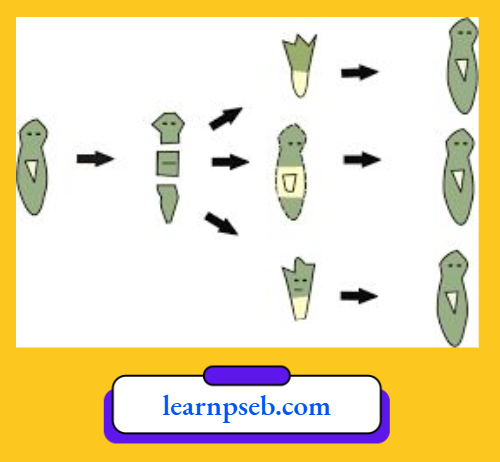
- Budding
- Regeneration
- Fission
- Segmentation
Answer: 2. Regeneration
Question 3. The most obvious outcome of the reproductive process still remains the generation of individuals of similar design. The rules of heredity determine the process by which traits and characteristics are reliably inherited.
1. Which type of reproduction would give rise to exact copies of parents?
Answer: Asexual Reproduction
2. The visible characteristic in an organism is known as:
- Prototype
- Stereotype
- Phenotype
- Genotype
Answer: 3. Phenotype
Life processes class 10 MCQ with answers
3. A plant with two ‘small’ genes breeds with a plant with two ‘tali’ genes to produce:
- Small plants and tall plants in the ratio 1:3
- All small plants
- All tall plants
- Tall plants and small plants in the ratio 3:1 17
Answer: 3. All tall plants
4. What are the “Factors” that Mendel talked about in his experiment?
- RNA Fragments
- Protein chains
- Similar forms of single gene
- Contrasting forms of single gene
Answer: 4. Contrasting forms of single gene
5. Offspring formed as a result of sexual reproduction exhibit more variations because
- Sexual reproduction is a lengthy process
- Genetic material comes from a single parent
- Genetic material comes from two parents of different species
- Genetic material comes from many parents
Answer: 3. Genetic material comes from two parents of different species
PSEB Class 10 Biology Solutions For Chapter 3 Heredity And Evolution
PSEB Class 10 Biology Solutions For Chapter 3: Heredity And Evolution
Heredity
Heredity means transmission of characters (traits) from parents to offsprings. These can be physical traits (e.g. eye colour, blood type or a disease), or behavioural traits.
Genetics- Branch of science that deals with heredity and variation.
Read And Learn More PSEB Class 10 Biology
Three Reasons For Variations During Reproduction
- Errors in DNA copying.
- Random fertilization.
- Crossing over during meiosis.
Reason For Variations In Asexual Reproduction
- Variations occur only due to defects in DNA copying.
- Since only one parent is involved, the genetic materials are transferred from only one parent. As a result, the frequency of variation among offspring is very less.
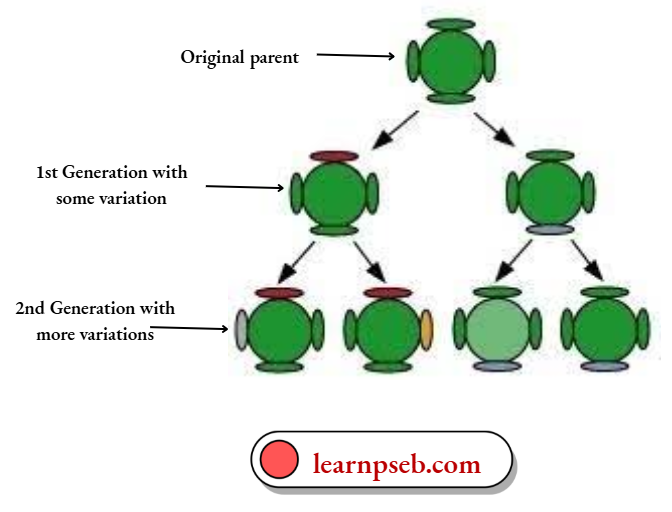
Reasons For Variations In Sexual Reproduction
- Variations can occur due to one or more of the following reasons – errors in DNA copying, random fertilization, crossing over during meiosis.
- Since gametes from two separate people are fused, variations take place at a higher frequency.
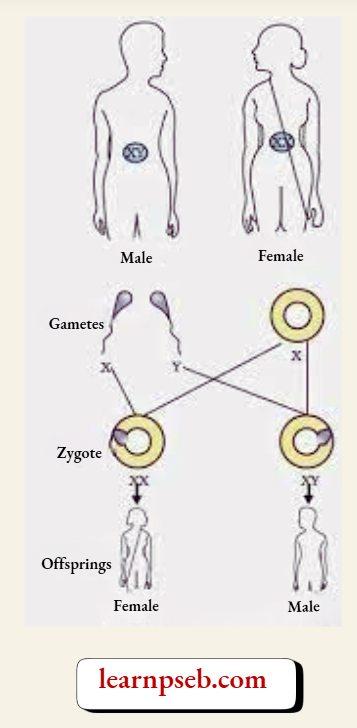
Mendel’s Contribution- Rules Of Inheritance Based On Experiments On Garden Peas
- Characters are transferred from the parents to the offsprings through genes. These genes are present in the DNA molecules in the chromosomes.
- Both the father and the mother contribute equal amounts of genetic material to the child. This means that each trait can be influenced by both paternal and maternal DNA. Thus, for each trait there will be two versions (one from the father and the other from the mother) in each child.
Simple Trick To Remember Seven Pairs Of Contrasting Characters Selected By Mendel
With the help of the mnemonic “SSCCPPF” one can easily remember the seven pairs of contrasting characters selected by Mendel for conducting experiments on pea plants
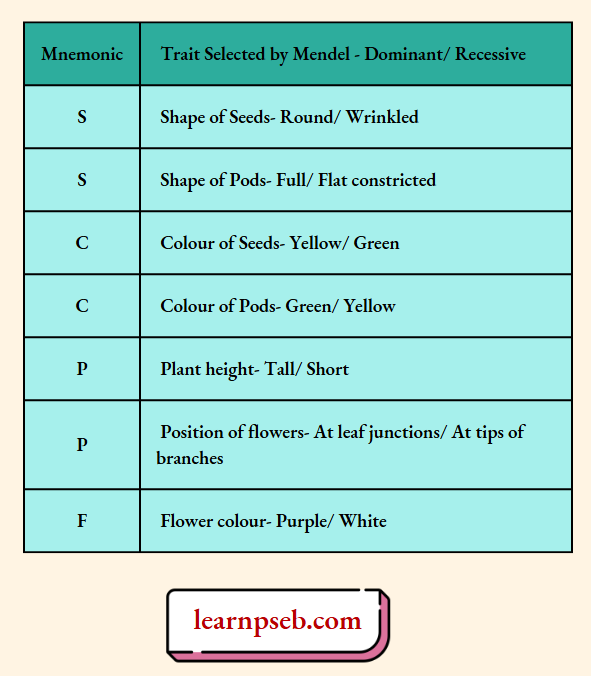
Mendel’s Experiments- Monohybrid Cross
- Cross pollination of plants having one pair of characters- a pure tall pea plant (TT) and a pure dwarf pea plant (tt).
- F1 generation- All tall plants were obtained.
- Self-pollination of plants of FI generation.
- F2 generation – Tall and dwarf plants obtained in the ratio 3:1 (Phenotypic ratio) and 1:2:1 :: TT: Tt: tt (Genotypic ratio).
- Trait expressed in FI generation is dominant trait, while the trait suppressed in FI generation is recessive trait.
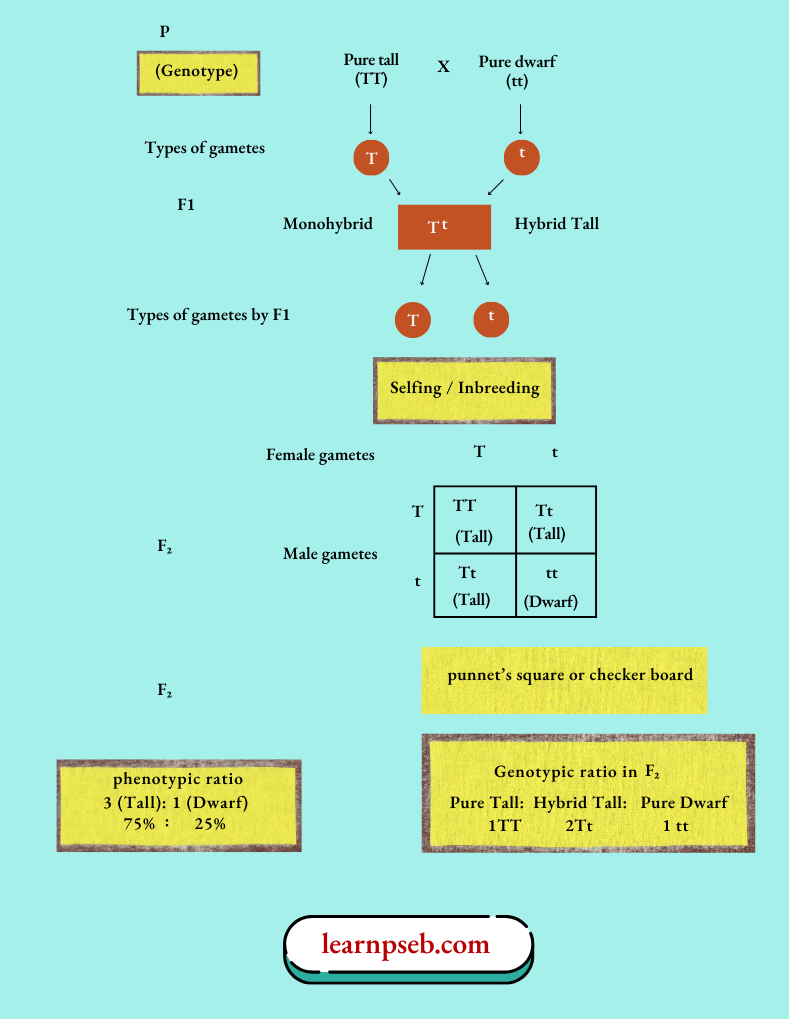
Mendel’s Experiments- Dihybrid Cross
- Cross pollination of plants having two pairs of characters, viz. colour and shape of seeds, i.e, Round Yellow seeds (RRYY) and Wrinkled Green seeds (rryy).
- F1 generation, all plants having round yellow seeds (RrYy) were obtained.
- Self-pollination of plants of F1 generation.
- F2 generation (16 plants were obtained) Phenotypic Ratio- 9:3:3:1 [9 had round yellow seeds (RrYy), 3 had round green seeds (Rryy), 3 had wrinkled yellow seeds (rrYy), and 1 had wrinkled green seeds (rryy)]. Genotypic Ratio (Nine genotypes were obtained)– 1:2:2:4:1:2:1:2:1
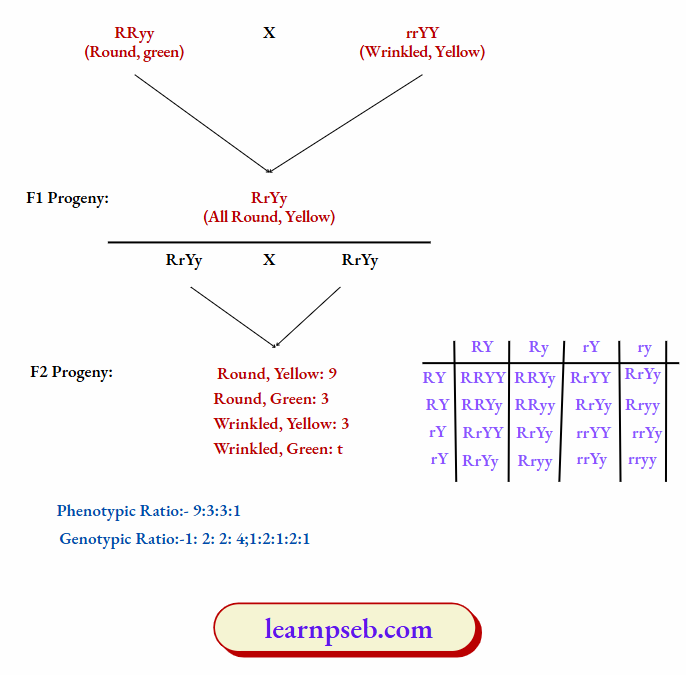
Simple Trick To Learn Genotypic Ratio In Dihybrid Cross
- Remember that there will be 9 genotypes in dihybrid cross.
- Now write the first gene combination 3 times each, i.e., RR, Rr and rr need to be written three times each.
- Write the other gene combination only once, i.e., YY, Yy and yy, and then repeat this three times.
- Write ratio as 1:2:1 from top, and 1:2:1 from bottom.
- In the middle three rows double the ratios written in the first three rows. This will give the genotypic ratio in dihybrid cross (1:2:1:2:4:2:1:2:1).
These steps are shown below:
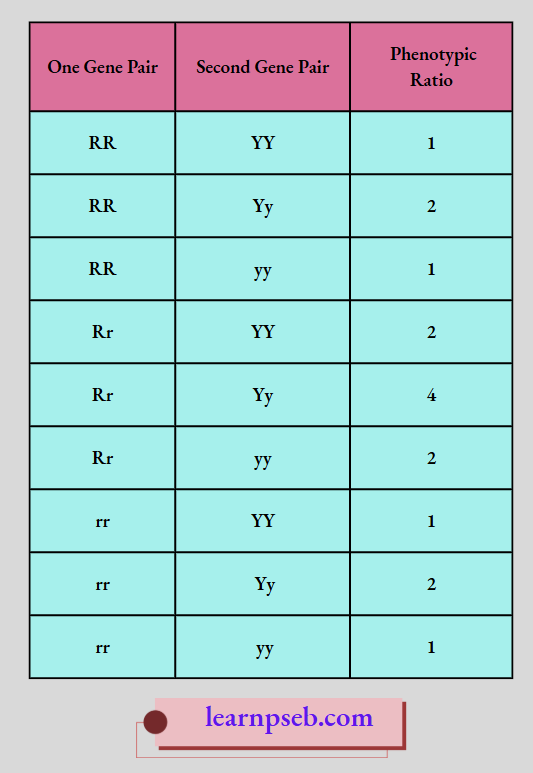
Mendel’s Laws Of Inheritance
- Law Of Dominance – If the set of alleles comes from parent (male and female) to offspring then, the dominant allele is expressed and the recessive allele has no noticeable effect.
- Law Of Segregation – The two alleles for a character separate during gamete formation (notice separation of alleles in FI and F2 generation of monohybrid and dihybrid cross).
- Law Of Independent Assortment or Inheritance – The two pair of alleles are inherited independently of each other.
Some Important Terms
- DNA- It is the information source for making proteins in the cell.
- Gene- A section of DNA that provides information for one protein is called the gene for that protein. Characteristics or traits of an organism are controlled by genes.
- Allele- An allele is one of two or more versions of a gene. e.g. TT, tt, Tt. An individual inherits two alleles for each gene, one from each parent.
- Homozygous- It means that the organism has two copies of the same allele for a gene. e.g. TT, tt.
- Heterozygous- It means that the organism has two different alleles of a gene. e.g. Tt.
- Phenotype- The trait which is visible in an organism is called its phenotype, e.g. Phenotypic ratio in F2 generation of monohybrid cross is 3:1.
- Genotype- The actual composition of genes present in an organism is called its genotype, e.g. Genotypic ratio in F2 generation of monohybrid cross is 1:2:1.
Sex Determination- The process of determining the biological sex of an offspring before its birth. Different strategies are used by different species for sex determination such as environmental factors and genetics.
Summary Of Sex Determination Methods In Different Species
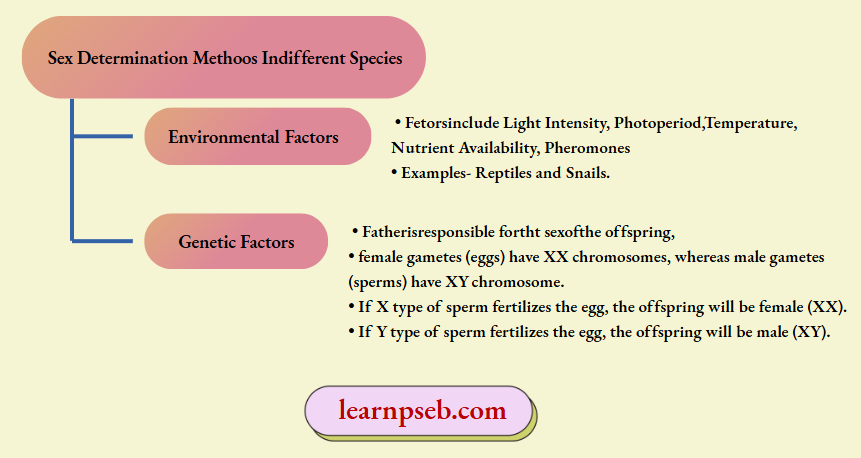
Sex Determination In Humans – Genetic Factors
- In human, sex of the offsprings is largely genetically determinied, and father is resp[onsible for the sex of the offspring.
- Humans have 23 pairs of chromosomes – 22 pairs of XX chromosomes (one X in each pair comes from mother and the other X comes from father) + 1 pair of sex chromosome (women have XX, while men have XY).
- During gamets formation, separation of chromosomes takes place. therefore, males produce two types of sperms X and Y, while female produces one type of egg X.
- If a X type of sperm fertilizes the egg then offspring will be female (XX). If Y type of sperm fertilizes the egg then offspring will be male (XY). Thus, the sex of the offspring will be determined by what they inherit from their father.
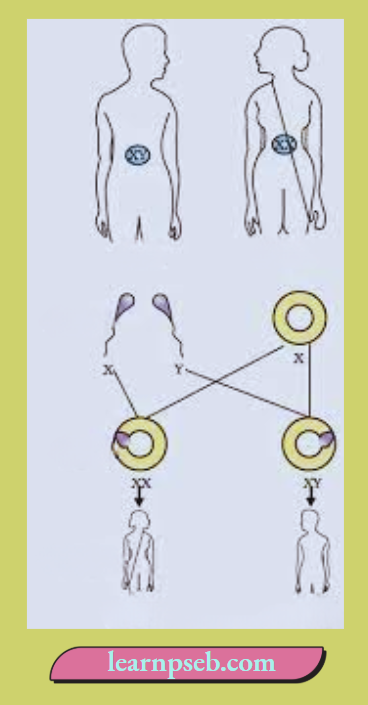
Chapter 3 Heredity And Evolution Reason-Assertion Questions And Answers
For question provided below, two statements are given—one labelled Assertion (A) and the other labelled Reason (R). Select the correct answer to these questions from the codes (a), (b), (c) and (d) as given below:
- Both A and R are true, and R is the correct explanation of the assertion.
- Both A and R are true, but R is not the correct explanation of the assertion.
- A is true, but R is false.
- A is false, but R is true.
Question 1. Assertion: Mendel chose pea plant for his experiments.
Reason: Pea plant provides diverse visible traits and has a short life span.
Answer: 1. Both A and R are true, and R is the correct explanation of the assertion.
Question 2. Assertion: When TT and tt pea plant were crossed, only tall plants were obtained in FI progeny.
Reason: This was because tall allele was dominant over the short allele.
Answer: 1. Both A and R are true, and R is the correct explanation of the assertion.
Question 3. Assertion: A geneticist crossed a pea plant having violet flowers with a pea plant with white flowers, he got all violet flowers in first generation.
Reason: White colour gene is not passed on to next generation.
Answer: 1. Both A and R are true, and R is the correct explanation of the assertion.
Question 4. Assertion: Acquired trait cannot be passed on from one generation to next generation.
Reason: Acquired trait cannot change the DNA of the germ cells.
Answer: 1. Both A and R are true, and R is the correct explanation of the assertion.
Question 5. Assertion: In some reptiles, the temperature at which fertilised egg is incubated before hatching plays a role in determining sex of offspring.
Reason: In turtle, high incubation temperature above 33°C leads to development of female offspring whereas in lizards high incubation temperature results in male offspring.
Answer: 2. Both A and R are true, but R is not the correct explanation of the assertion.
Question 6. Assertion (A): If mother has two dominant alleles for black hair and father has two recessive alleles for blonde hair then their child will inherit one dominant allele from mother and one recessive allele from father and will have black hair.
Reason (R): Progeny inherits one genes for each trait from its parents but the trait shown by progeny depends on inherited alleles.
Answer: 1. Both A and R are true, and R is the correct explanation of the assertion.
Question 7. Assertion (A): Genes present in every cell of an organism control the traits of the organisms.
Reason (R): Gene is specific segment of DNA occupying specific position on a chromosome.
Answer: 2. Both A and R are true, but R is not the correct explanation of the assertion.
Question 8. Assertion (A): A child which has inherited X chromosome from father will develop into a girl child.
Reason (R): Girl child inherits X chromosome from father and Y chromosome from mother.
Answer: 3. A is true, but R is false.
Question 9. Assertion (A): In human males all the chromosomes are perfectly paired except X and Y chromosomes.
Reason (R): X and Y are sex chromosomes.
Answer: 1. Both A and R are true, and R is the correct explanation of the assertion.
Question 10. Assertion (A): A heterozygous tall plant when crossed with homozygous dwarf plant will produce tall and dwarf plants in the ratio of 3:1.
Reason (R): A heterozygous tall plant will produce two types of gametes, i.e., one with T and other with t whereas homozygous dwarf plant produce all gametes with t only.
Answer: 4. A is false, but R is true.
Question 11. Assertion (A): Selfing of a plant for several generations helps plant breeders to obtain pure breeding varieties.
Reason (R): Pure breeding plants are heterozygous for many traits.
Answer: 3. A is true, but R is false.
Question 12. Assertion (A): In humans, height is a trait which shows variation.
Reason (R): Some humans are very tall, some have medium height whereas others are short heighted.
Answer: 2. Both A and R are true, but R is not the correct explanation of the assertion.
Question 13. Assertion (A): Evolution is an extremely slow process.
Reason (R): New characters are accumulated in an organism during its lifetime.
Answer: 3. A is true, but R is false.
Question 14. Assertion (A): Mutation is sudden change in the genetic material.
Reason (R): Variation is useful for the survival of species over time.
Answer: 2. Both A and R are true, but R is not the correct explanation of the assertion.
Chapter 3 Heredity And Evolution Case Or Source Based Questions
Question 1. Mendel proposed two general rules to consolidate his understanding of inheritance in monohybrid crosses. These are called the Principles or Laws of Inheritance: the First Law or Law of Dominance and the Second Law or Law of Segregation. The Law of Dominance is used to explain the expression of only one of the parental characters in a monohybrid cross in the FI and the expression of both in the F2.
It also explains the proportion of 3:1 obtained at the F2. The Law of Segregation is based on the fact that the alleles do not show any blending and that both the characters are recovered as such in the F2 generation though one of these is not seen at the FI stage. Though the parents contain two alleles during gamete formation, the factors or alleles of a pair segregate from each other such that a gamete receives only one of the two factors. A homozygous parent produces all gametes that are similar while a heterozygous one produces two kinds of gametes each having one allele with equal proportion.
1. In a dihybrid cross, pure homozygous plants will be
- 9
- 2
- 1
- 3
Answer: 2. 2
2. Mendel observed red flowers in FI generation, when he crossed red and white because of
- Dominance
- Recessive gene
- Law of independent assortment
- Law of segregation
Answer: 1. Dominance
3. The blood group containing anti A and anti B is
- Blood group A
- Blood group B
- Blood group AB
- Blood group O
Answer: 4. Blood group O
4. A typical genotypic monohybrid ratio is
- 9:3:3:1
- 1:2:1
- 3:1
- 9:7
Answer: 2. 1:2:1
5. Independent assortment of Mendel was proved by
- Monohybrid cross
- Dihybrid cross
- Incomplete dominance
- Back cross
Answer: 2. Dihybrid cross
Question 2. Pure bred pea plant with smooth seeds (dominated characteristic) were crossed with purebred pea plant with wrinkled seeds (recessive characteristic). The FI generation was self-pollinated to give rise to the F2 generation.
What will be the genotypic ratio of the given F2 generation?
If a genotype consists of different types of alleles, what is it called?
What is the alternative form of the gene?
Answer:
- In given case, genotypic ratio of F2 progeny will be 1:2:1 where, one is homozygous dominant, two are heterozygous dominant and one is homozygous recessive,
- Alleles
- Allele
Question 3. Mendel experimented on a pea plant and considered 7 main contrasting traits in the plants. In monohybrid experiment, Mendel took two pea plants of opposite traits (one short and one tall) and crossed them. He found the first generation offspring were tall and called it FI progeny. Then he crossed FI progeny and obtained both tall and short plants in the ratio 3:1.
In a dihybrid cross experiment, Mendel considered two traits, each having two alleles. He crossed wrinkled-green seed and round-yellow seeds and observed that all the first generation progeny (FI progeny) were round-yellow. This meant that dominant traits were the round shape and yellow colour. He then self-pollinated the FI progeny and obtained 4 different traits wrinkled-yellow, round-yellow, wrinkled-green seeds and round-green in the ratio 9:3:3:1.
1. Which of the following was not a trait considered by Mendel for his experiments?
- Flower colour
- Pod shape
- Stem height
- Seed type
Answer: 4. Seed type
2. What is the phenotypic ratio of the F2 progeny in a dihybrid cross?
- 3:1
- 1:2:1
- 9:3:3:1
- 3:4
Answer: 3. 9:3:3:1
3. What is the genotypic ratio of the F2 progeny in a monohybrid cross?
- 3:1
- 1:2:1
- 9:3:3:1
- 3:4
Answer: 3. 9:3:3:1
4. A cross between tall and dwarf plants will produce which type of plants in the F1 generation?
- Tall
- Dwarf
- Semi-dwarf
- Short
Answer: 1. Tall
5. Because of his contribution to the field of genetics, Mendel is known as the
- Father of genetics
- Father of botany
- Father of medicine
- Father of plant physiology
Answer: 1. Father of genetics
Question 4. In human, the allele for brown eyes (B) is dominant over that for blue eyes (b). A brown-eyed woman marries a blue-eyed man, and they have six children. Four of the children are brown-eyed and two of them are blue-eyed.
- What is the genotype of blue-eyed offspring?
- What is the woman’s genotype?
- What is the gene carried by the mother’s ovum regarding the eye colour?
- What is the gene carried by the man’s sperm regarding the eye color?
Answer:
- bb
- Bb According to the given passage some children show recessive trait, i.e., homozygous. So, the woman must be heterozygous.
- B or b Human ova are haploid, hence they only contain one copy of each gene. Since the woman has a Bb genotype her ova would contain either B or b allele.
- Human sperm is haploid, hence they only contain one copy of each gene. Since the man has a bb genotype, his sperm would contain allele b only.
Question 5. Mendel conducted dihybrid cross which involved two pairs of contrasting characters. The results obtained were amazingly unique. Mendel is known as the Father of Genetics.
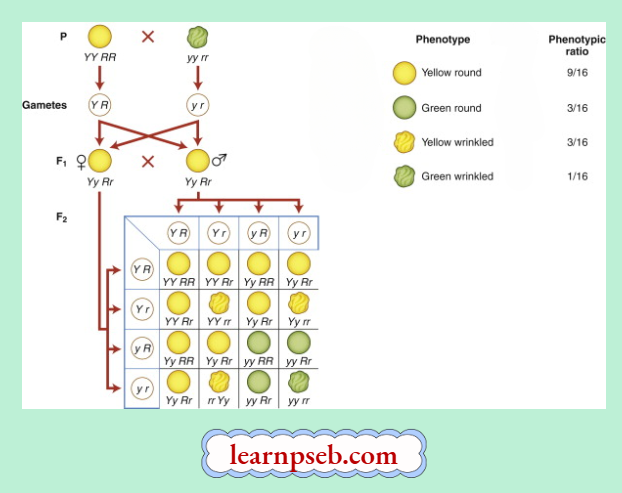
1. Which two pairs of contrasting characters are involved in the above parental cross?
- Round, yellow and green wrinkled
- Round green and yellow wrinkled
- Wrinkled yellow and round green
- Flat yellow and constricted green
Answer: 1. Round, yellow and green wrinkled
2. What is the genotype of the parent with round and wrinkled seeds?
- RRYY
- RRyy
- RrYy
- rrYY
Answer: 2. RRyy
3. In the FI generation, what is the phenotype of the offspring?
- Round and yellow
- Green and round
- Green and wrinkled
- Round and wrinkled
Answer: 1. Round and yellow
4. How many heterozygous offspring are produced in the F2 generation, if a total of 16 offspring are produced?
- 12
- 14
- 16
- 4
Answer: 2. 14
5. What is the ratio of parental combination to recombinants?
- 1:7
- 3:4
- 1:3
- 3:1
Answer: 1. 1:7
Question 6. Peter Norman, a leading UK podiatrist who has been treating the Royal Ballet for 16 years, has seen a lot in his days. He says it’s common for dancers to tape their feet simply and go on pointe with broken toes or stress fractures. He says it’s due to the pressure and insecurity of their jobs. People push their limits to keep their position. The constant pressure on the tip of their toes and the quick bursts of jumping in the air and landing perfectly, the stretching of their tendons and feet fit into impossible shaped shoes has altered the shape of their feet. But for a lot of dancers, this has become a part of them and a part of how they survive these shoes. Most of them won’t allow their doctors to remove the thickened skin at their toe-heads because that is how they survive the shoes. Norman claims he has seen patients whose feet require at least a few weeks to a month’s rest, but they refuse to take more than a night. Among men, it’s different for they wear soft canvas shoes. There’s a lot of jumping and lifting women involved and that results in ankle and tendon injuries.
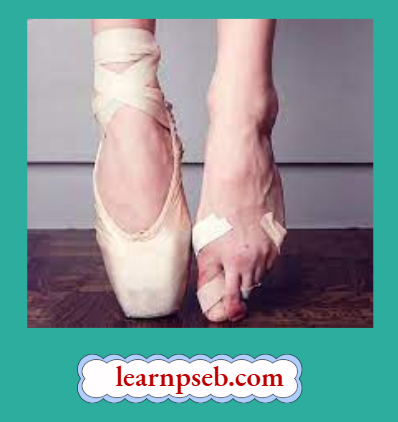
- Why do you think ballerinas are made to do this to their toes?
- Do you think these injuries will make any changes in their DNA Or genes?
- Will their offspring be born with such feet?
- Is it an acquired or inherited trait?
Answer:
- There’s a lot of jumping and lifting women involved and that results in ankle and tendon injuries. However, due to the pressure and insecurity of their jobs, they refuse to take proper treatment and rest and push their limits to keep their position.
- No.
- No, because this is not an inherited trait.
- Acquired trait.
Question 7. Haemophilia is an X-linked disorder characterized by the inability to properly form blood clots. Until recently, haemophilia was untreatable, and only a few haemophiliacs survived to reproductive age because any small cut or internal haemorrhaging after even a minor bruise were fatal. Now haemophilia is treated with blood transfusions and infusions of a blood derived substance known as antihemophilic factor. However, the treatment is very expensive and occasional problems can arise because of a patient’s allergic reactions or other transfer complications. Haemophilia affects males much more frequently (1 in 10,000) than females (1 in 100,000,000). This occurs because a critical blood clotting gene is carried on the X chromosome. Since males only carry one X chromosome, if that is defective, haemophilia will immediately show up. An early death is likely. Females, on the other hand, carry two X chromosomes. If only one is defective, the other normal X chromosome can compensate. The woman will have normal blood clotting; she will simply be a carrier of the recessive defective gene. This fact will be discovered if some of her children are haemophiliacs. Naturally, women haemophiliacs are rare because it takes two defective X chromosomes in order for the condition to be seen.
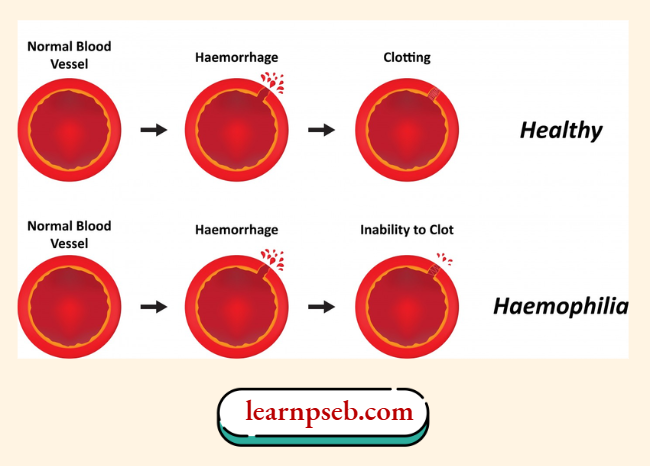
- What are the problems associated with haemophilia?
- How does this disease gets transferred?
- Do you think these will make any changes in the DNA/ genes?
- Can the offspring be born with such a disease? Does the female have more chances to get the disease or the male?
- Is it an acquired or inherited trait?
Answer:
- Inability to properly form blood clots.
- Since the blood clotting gene is carried on the X chromosome, t gets transferred from parents to offsprings through chromosomes.
- Yes. Blood clotting gene is carried on the X chromosome. Since males only carry one X chromosome, if that is defective, haemophilia will immediately show up. An early death is likely. Females, on the other hand, carry two X chromosomes. If only one is defective, the other normal X chromosome can compensate. The woman will have normal blood clotting; she will simply be a carrier of the recessive defective gene. This fact will be discovered if some of her children are haemophiliacs.
- Yes, the offspring can be born with such a disease. Blood clotting gene is carried on the X chromosome. Males have more chances to get the disease since males only carry one X chromosome, if that is defective, haemophilia will immediately show up. An early death is likely. Females, on the other hand, carry two X chromosomes. If only one is defective, the other normal X chromosome can compensate. The woman will have normal blood clotting; she will simply be a carrier of the recessive defective gene. This fact will be discovered if some of her children are haemophiliacs.
- Inherited trait.
